Paul van Yperen's Blog, page 49
May 30, 2024
Willi Forst
Charming Austrian actor Willi Forst (1903-1980) personified the elegant ladykiller, dressed in tails and top hat, and was a darling of the German-speaking public. He was also one of the most significant directors, producers, and writers of the 'Wiener Filme', the light Viennese musical comedy of the 1930s and 1940s.
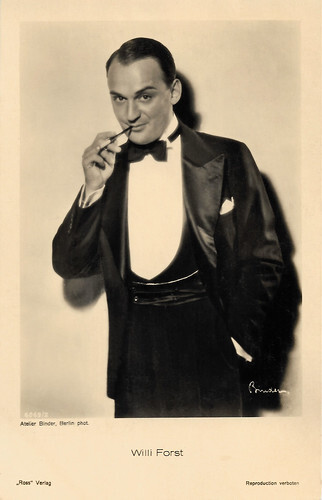
German postcard by Ross Verlag, no. 6069/2, 1931-1932. Photo: Atelier Binder, Berlin.
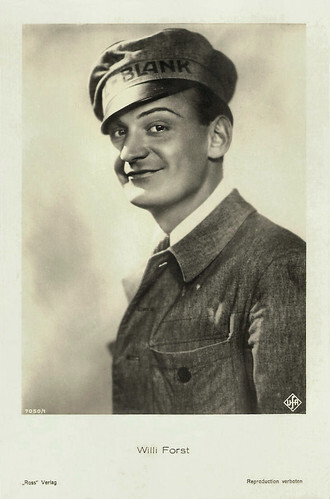
German postcard by Ross Verlag, no. 7050/1. Photo: Ufa. Willi Forst in Ein blonder Traum (Paul Martin 1932).
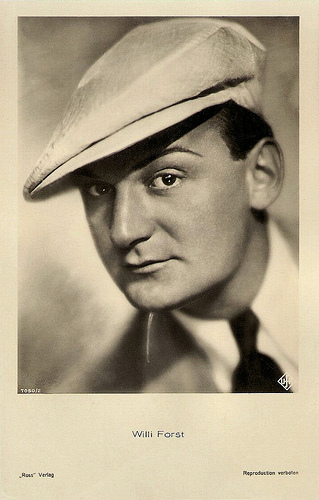
German postcard by Ross Verlag, no. 7050/2, 1932-1933. Photo: Ufa.
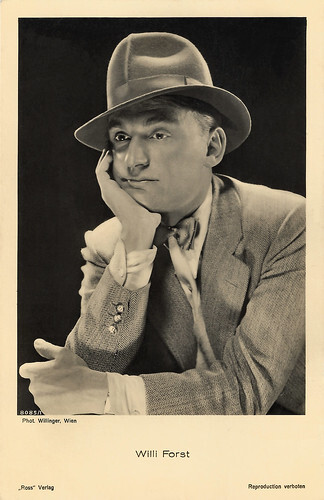
German postcard by Ross Verlag, no. 8085/1, 1933-1934. Photo: Willinger, Wien.
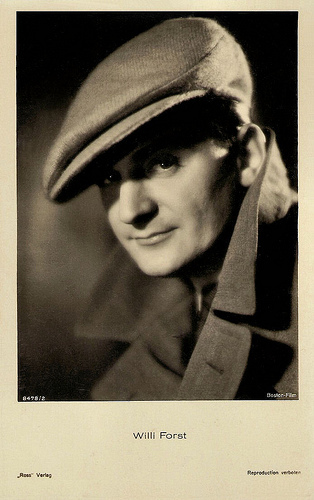
German postcard by Ross Verlag, no. 8478/2, 1933-1934. Photo: Boston-Film.
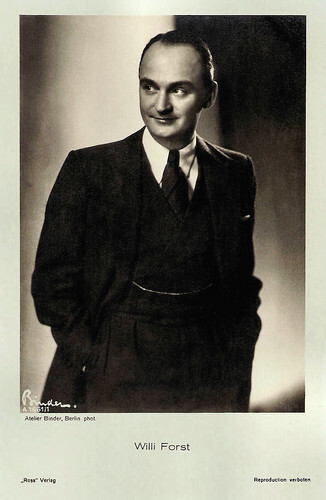
German postcard by Ross Verlag, no. A 1661/1, 1937-1938. Photo: Atelier Binder, Berlin.
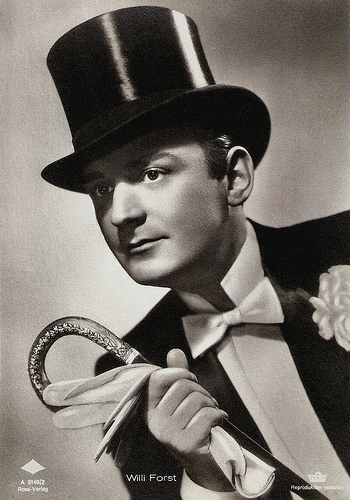
German postcard by Ross Verlag, no. A 3149/2, 1941-1944. Photo: Tobis.
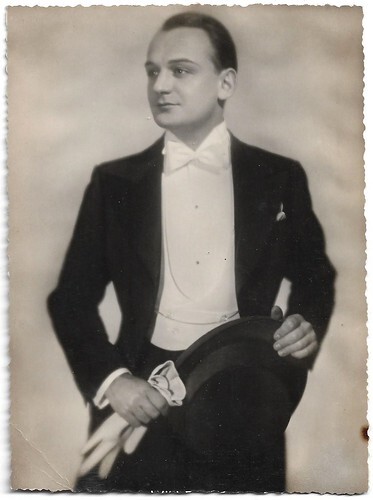
German postcard. This could be a Ross Luxusklasse card (a fragment of a sticker on the back suggests this), but the edges of this card were cut off.
Marlene Dietrich
Willi (also written as Willy) Forst was born Wilhelm Anton Frohs in Vienna, Austria-Hungary (now Austria), in 1903. His father was the porcelain painter Wilhelm Frohs, and his mother was the miller's daughter Maria Perschl. During secondary school, he worked with some amateur theatre groups.
At age 16, he began his career as an actor. Forst got his first stage engagement in 1919 in Cieszyn, Poland, as a "second adolescent lover and comedian, with choir commitment", despite the fact that he had no actual formal training as an actor. In the following years, he acted on the provincial stages in Austria–Hungary and the German Empire and appeared as a featured performer in the post-World War I operetta theatres of Vienna and Berlin.
In 1925, he got a contract for the Berliner Metropol-Theater to appear in operettas and revues. In 1927, he returned to the prose theatre. In Berlin, he worked with the famous director Erwin Piscator at the Lessing-Theater. In 1928 an engagement to Max Reinhardt 's Deutsches Theater (German Theatre).
Forst made his film debut in the Austrian film Der Wegweiser/The Signpost (Hans Kottow, 1920). He had small parts in films like Sodom und Gomorrah/Sodom and Gomorrah (Mihaly Kertész a.k.a. Michael Curtiz, 1922) starring Lucy Doraine and Strandgut/Jetsam (Hans Karl Breslauer, 1924). He played the title role in the Austrian silent film Oh, du lieber Augustin/Oh, Dear Augustine (Hans Karl Breslauer, 1922).
From 1927 he acted regularly in films. His first major screen roles were opposite Marlene Dietrich in the silent films Café Elektric/Cafe Electric (Gustav Ucicky, 1927) and Gefahren der Brautzeit/Dangers of the Engagement Period (Fred Sauer, 1929). The latter was Dietrich's final film before her breakthrough role in Der blaue Engel/The Blue Angel (Josef von Sternberg, 1930), which made her an international star and led to her departure to Hollywood.
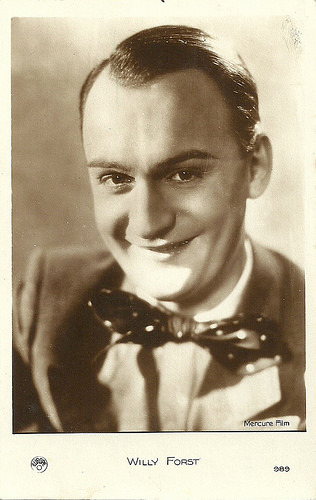
French postcard by Europe, no. 989. Photo: Mercure Film.
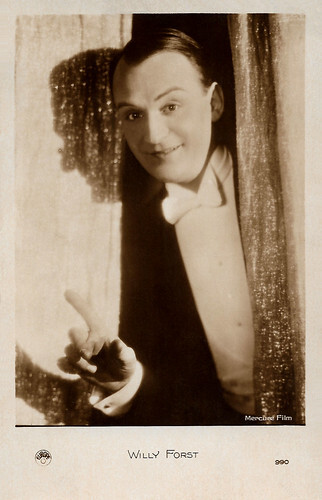
French postcard by Europe, no. 990. Photo: Mercure Film.
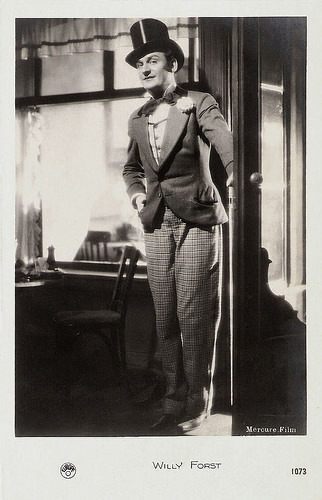
French postcard by Europe, no. 1073. Photo: Mercure Film.
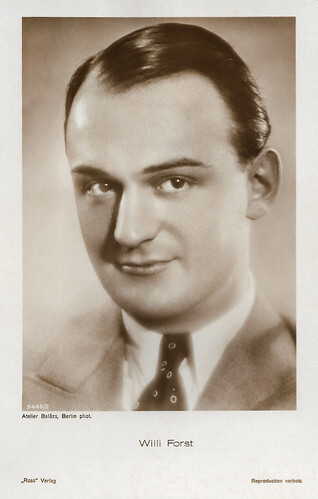
German postcard by Ross Verlag, no. 5446/2, 1930-1931. Photo: Atelier Balázs, Berlin.
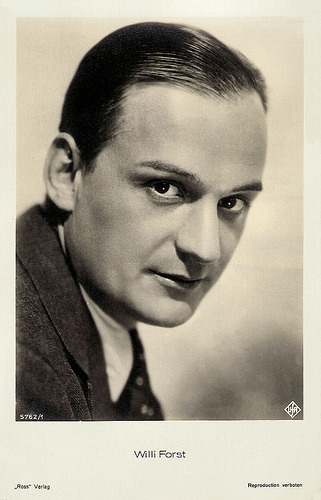
German postcard by Ross Verlag, no. 5762/1, 1930-1931. Photo: Ufa.
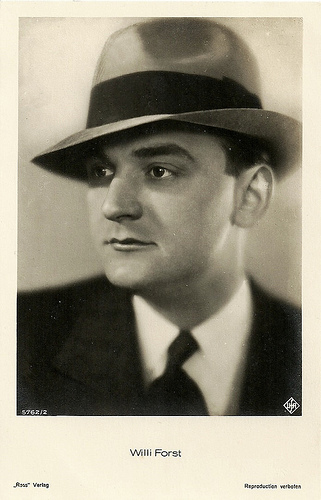
German postcard by Ross Verlag, no. 5762/2, 1930-1931. Photo: Ufa.
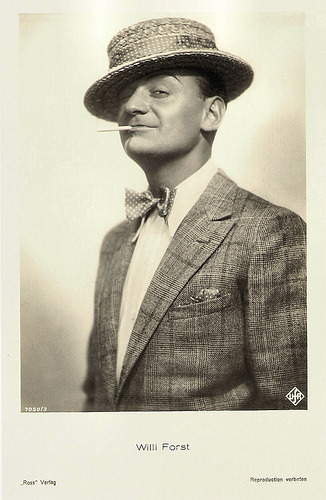
German postcard by Ross Verlag, no. 7050/3, 1932-1933. Photo: Ufa. Willi Forst in Ein Blonder Traum/A Blonde's Dream (Paul Martin, 1932).
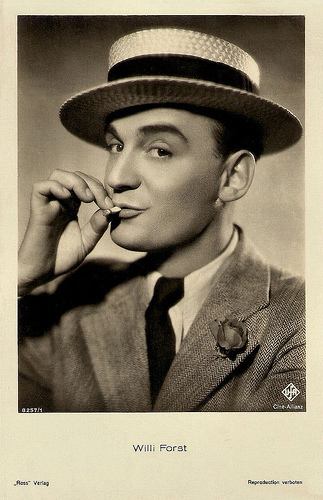
German postcard by Ross Verlag, no. 8257/1, 1933-1934. Photo: Ufa / Cine-Allianz.
Velvety voice
Willi Forst made his sound and singing film debut in Atlantik/Titanic (Ewald André Dupont, 1929). The film was the first fully talking film to be released in Germany, where it was a major hit. Forst attracted huge attention with a scene where he sat at the piano and sang a song while the ship was sinking. While singing the sad lines "Es wird ein Wein sein, und wir wer'n nimmer sein, es wird schöne Madeln geben, und wir wer'n nimmer leben...", he suddenly realizes the cruel truth of the lyrics and collapses.
Soon, he became known for his distinctive velvety voice and 'charming Viennese' characters. He became a darling of the public with a string of operetta films. After Zwei Herzen im 3/4 Takt/Two Hearts in Waltz Time (Géza von Bolváry, 1930) with music by Robert Stolz, he played six more times under the direction of Géza von Bolváry. The piece of clothing that suited him best in these films was the tailcoat – complete with cane and top hat. He moved in it as if it were his second skin.
Most of these successes were written by Austrian-born director and screenwriter Walter Reisch, who in later Hollywood exile would script Ninotchka (Ernst Lubitsch, 1939) and Gaslight (George Cukor, 1944), and work with Billy Wilder.
Reisch also wrote Ein blonder Traum/A Blonde's Dream (Paul Martin, 1932) with Lilian Harvey and Willy Fritsch , and Der Prinz von Arkadien/The Prince from Arcadien (Karl Hartl, 1932) with Liane Haid .
Forst considered the best learning experience for his future role as director, So ein Mädel vergisst man nicht/Unforgettable Girl (1933) directed by expressionist film actor-turned-director Fritz Kortner .
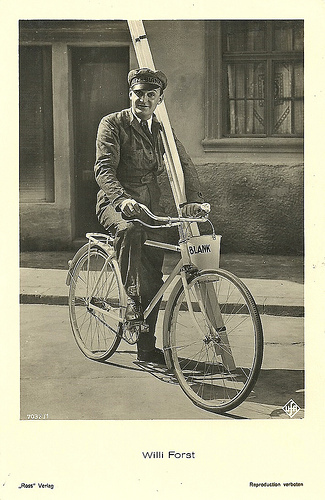
German postcard by Ross Verlag, no. 7032/1, 1932-1933. Photo: Ufa. Publicity still for Ein blonder Traum/Happy Ever After (Paul Martin, 1932).
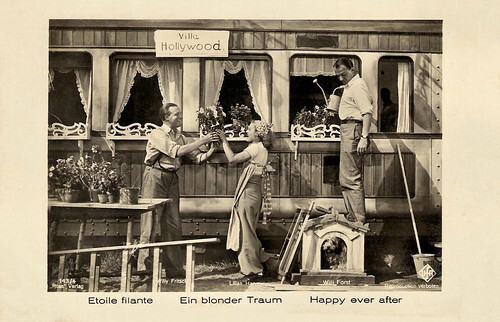
German postcard by Ross Verlag, no. 143/4, 1931-1932. Photo: Ufa. Publicity still for Ein blonder Traum/Happy Ever After (Paul Martin, 1932).
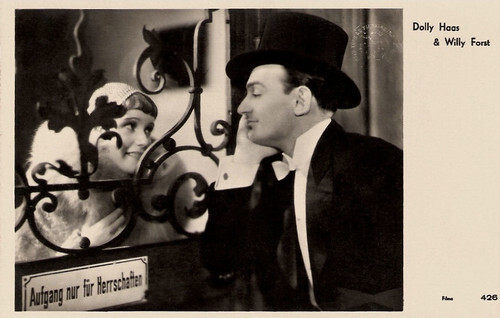
Dutch postcard by Filma, no. 426. Dolly Haas and Willi Forst in So ein Mädel vergisst man nicht/Unforgettable Girl (Fritz Kortner, 1932).
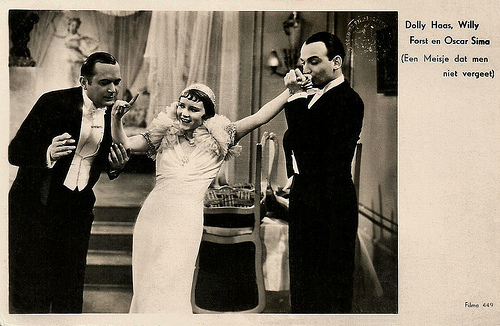
Dutch postcard by Filma, no. 449. Photo: Dolly Haas , Willi Forst and Oskar Sima in So ein Mädel vergisst man nicht/Unforgettable Girl (1932).
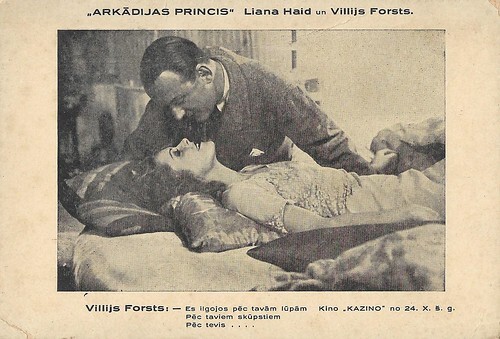
Latvian collector card by P. Mantnieks, Riga, for Kino Kazino. Liane Haid and Willi Forst in the Austrian-German film Der Prinz von Arkadien/The Prince of Arcadia (Karl Hartl, 1932).
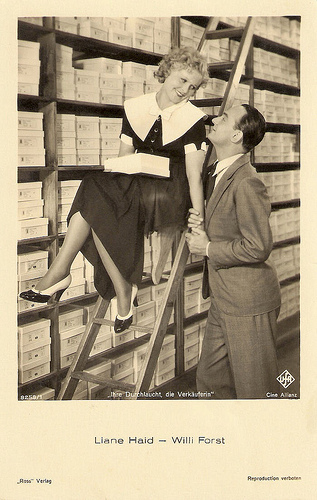
German postcard by Ross Verlag, no. 8258/1, 1933-1934. Photo: Ufa / Cine Allianz. Publicity still for the romantic comedy Ihre Durchlaucht, die Verkäuferin/Her Excellency, the Salesgirl (Karl Hartl, 1933) with Liane Haid .
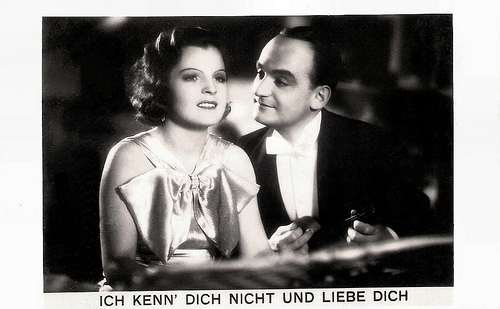
British postcard. Photo: publicity still for Ich Kenn Dich Nicht Und Liebe Dich/I Don't Know You, But I Love You (Géza von Bolváry, 1934) with Magda Schneider .
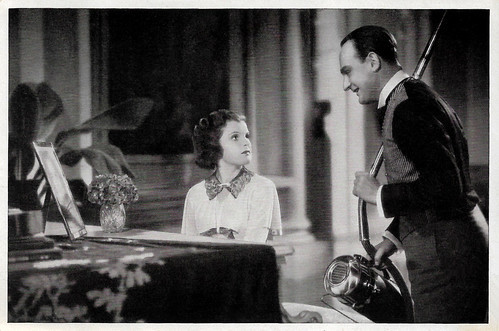
German collectors card in the series 'Vom Werden deutscher Filmkunst - Der Tonfilm', album no. 11, picture no. 36. Photo: Boston-Film / Ross Verlag. Magda Schneider and Willi Forst in Ich kenn' dich nicht und liebe dich/I Don't Know You, But I Love You (Géza von Bolváry, 1934).
Bel Ami
Willi Forst developed the genre of the 'Wiener Filme' with writer Walter Reisch in the 1930s, beginning with the Franz Schubert melodrama Leise flehen meine Lieder/Lover Divine (Willi Forst, 1933). Leise flehen meine Lieder was so popular throughout Europe that it was reshot in a British version for the English language market as The Unfinished Symphony (1934), co-directed by Forst and Anthony Asquith.
He followed it with the hit Maskerade/Masquerade in Vienna (Willi Forst, 1934), which launched his fame as a significant director and made an instant star of Paula Wessely . For the German film Mazurka (Willi Forst, 1935), he lured Pola Negri back from Hollywood. He rapidly developed himself into a four-way talent, as a producer, director, writer and actor in German films like Allotria/Tomfoolery(Willi Forst, 1936) with Renate Müller and Serenade (Willi Forst, 1937).
Forst briefly returned to Vienna in 1936 to film Burgtheater/The Court Theatre. The film starred Werner Krauss as a great stage actor whose life is altered by one late love. As usual in the Viennese Film, the renunciation of passion and its sublimation into art provides a dramatic conclusion. From the mid-1930s he also recorded many records, largely of sentimental Viennese songs, for the Odeon Records label owned by Carl Lindström AG. He founded his own film company in 1936. The 'Willi Forst-Film-Produktion' opened a German branch in 1937 and was shut down in 1950.
Following Austria’s annexation to Germany in March 1938, Vienna’s film industry was wholly integrated into the structure and ideology of the Third Reich and given a specific cultural mission – the production of lavish musicals, costume dramas and other 'Vienna style' entertainment films for the Reich. With strong control from Berlin, the new Viennese mega-studio Wien-Film echoed the concept of the Hollywood studio system more closely than had been normal in previous Austrian cinema development.
Many Austrian talents at Ufa in Berlin, including Forst, returned home to participate in this new phase of Vienna’s industry. From 1938 until 1945 Forst was a member of the supervisory board of the Wien Film GmbH. His best-known film for Wien Film would be the elegant satire Bel Ami (Willi Forst, 1939) based on the novel by Guy de Maupassant. He also played the title role, which would be his alter ego from then on.
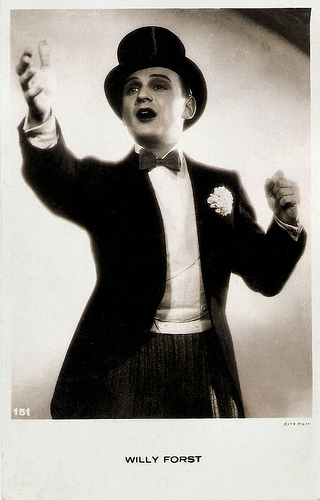
Dutch Postcard by City Film, no. 151.
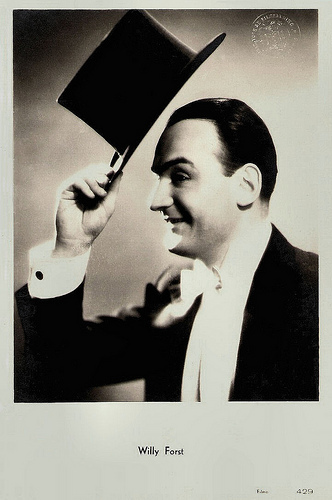
Dutch Postcard by JosPe, Arnhem, no. 429. Photo: Filma.
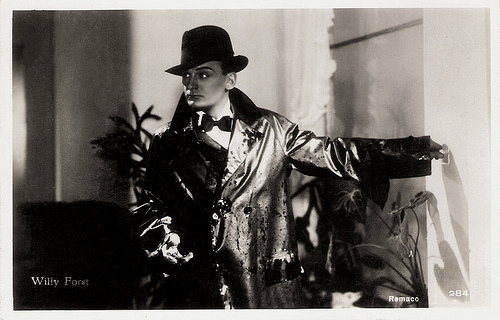
Dutch postcard by JosPe, Arnhem, no. 984. Photo: Remaco.
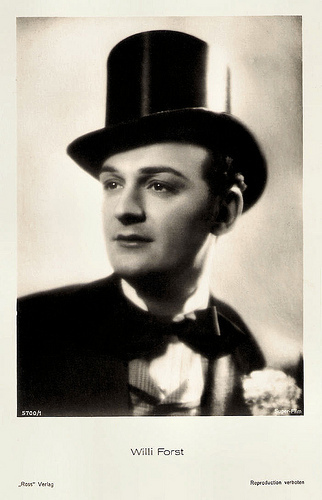
German postcard by Ross Verlag, no. 5700/1, 1930-1931. Photo: Super-Film.
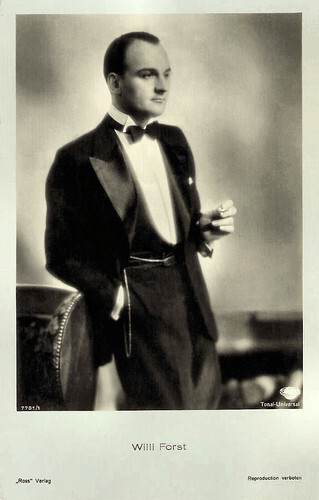
German postcard by Ross Verlag, no. 7701/1, 1932-1933. Photo: Tonal - Universal. Publicity still for Brennendes Geheimnis/The Burning Secret (Robert Siodmak, 1933).
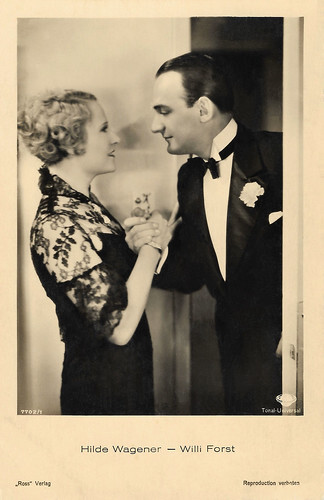
German postcard by Ross Verlag, no. 7702/1, 1932-1933. Photo: Tonal - Universal. Hilde Wagener and Willi Forst in Brennendes Geheimnis/The Burning Secret (Robert Siodmak, 1933).
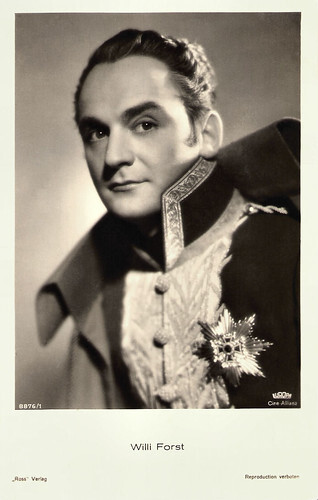
German postcard by Ross Verlag, no. 8876/1, 1933-1934. Photo: Europea / Cine-Allianz. Willi Forst in So endete eine Liebe/End of an Affair (Karl Hartl, 1934).
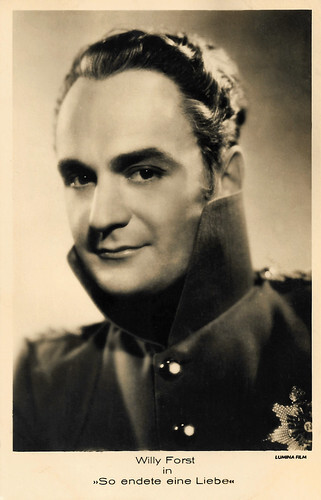
Dutch postcard by M.B. & Z. for Rembrandt Theater, Haarlem Photo: Lumina Film. Willi Forst in So endete eine Liebe/End of an Affair (Karl Hartl, 1934).
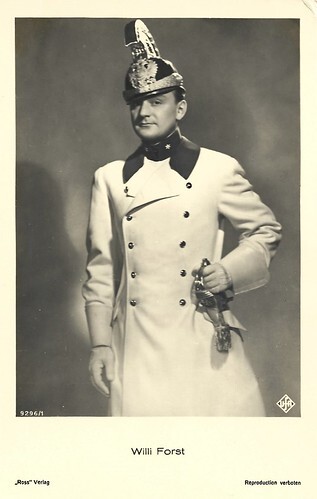
German postcard by Ross Verlag, no. 9296/1, 1935-1936. Photo: Ufa. Willi Forst in Königswalzer/The Royal Waltz (Herbert Maisch, 1935).
Wiener Filme
Willi Forst was much courted by the Nazis. He succeeded in avoiding overt political statements, concentrating entirely on the light entertainment for which he was famous and which was much in demand during the war. During the seven years of National Socialist rule in Austria, he only made four films, none of them political. His most important work was his Wien-Film trilogy: Operette/Operetta (Willi Forst, 1940), Wiener Blut/Vienna Blood (Willi Forst, 1942) starring Willy Fritsch , and Wiener Mädeln/Vienna Beauties (Willi Forst, begun in 1944, but not completed until 1949). With box-office takings of seven million Reichsmarks, the operetta film Wiener Blut/Vienna Blood was one of the most financially successful films of the Nazi era.
Robert von Dassanowsky at Senses of Cinema : "Operette has become Forst’s best-known work. It is certainly a high point in the Viennese Film genre and brings together all of Forst’s talents as an auteur. As the film’s leading man, writer, director, and producer, also responsible for overseeing the artistic and music direction, his superbly orchestrated and uniquely detailed Romantic/decadent style can only be compared to the baroque silent films of Erich von Stroheim , to the elegant comedies of French director René Clair, and to the later operatically orchestrated style of Italian director Luchino Visconti ’s nineteenth-century period films (Senso, The Leopard )."
After the war, Willi Forst emerged on the postwar film scene to reestablish Austrian film as an internationally important cinema and founded a new publication in April of 1946, Film , which was edited by Josef Malinahad. In the cinema, Forst had comparatively little success, except for the film Die Sünderin/The Sinner (Willi Forst, 1951) starring Hildegard Knef and Gustav Fröhlich. The frank treatment of social and sexual mores in Germany during and after the war and a modest nude scene of Knef created a furore at the release, but the film went on to attract an audience of seven million people.
Willi Forst's last film was the comedy Wien, du Stadt meiner Träume/Vienna, City of My Dreams (Willi Forst, 1957), with Adrian Hoven and Erika Remberg . Then he retired from the film world, acknowledging that his style was no longer in demand. After the death of his wife Melanie in 1973 he lived a reclusive life in the Swiss canton of Tessin. He died of cancer in Vienna in 1980 and is buried in Neustift am Walde.
Robert von Dassanowsky writes that Forst is "one of Austrian and Central European cinema's greatest filmmakers and influential industry figures, whose lack of presence in the international film 'canon' of important directors today is one more casualty from the negligence that has greeted Austrian cinema since the collapse of its commercial film industry in the 1960s."
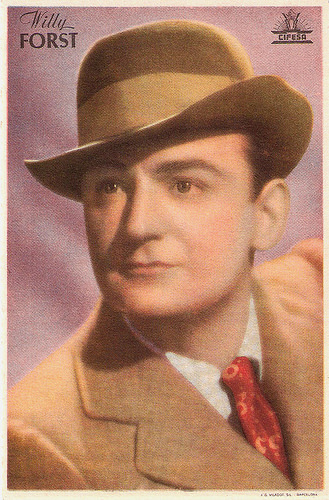
Spanish collector's card by I.G. Viladot, Barcelona. Image: Cifesa.
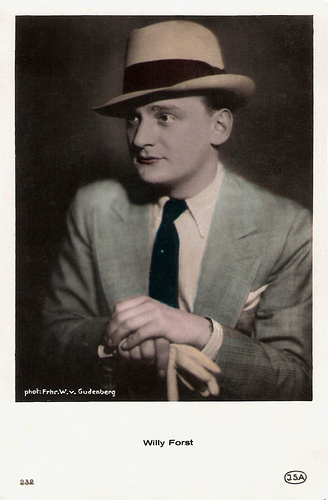
Dutch postcard by JSA, no. 232. Photo: Freiherr Wolff von Gudenberg. [Baron] Wolff von Gudenberg (1890-1961) was a noted and fashionable photographer in the 1920s and 1930s.

German postcard by Ross Verlag, no. A 1661/1, 1937-1938. Photo: Alex Binder, Berlin.
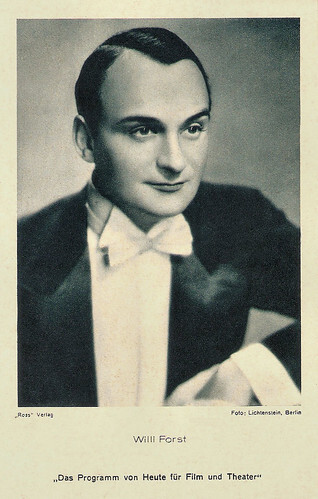
German postcard for Das Programma von Heute für Film und Theater by Ross Verlag. Photo: Lichtenstein, Berlin.
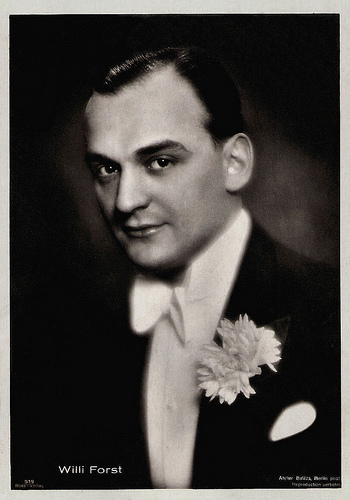
German postcard by Ross Verlag, no. 519, 1941-1944. Photo: Atelier Balázs, Berlin.
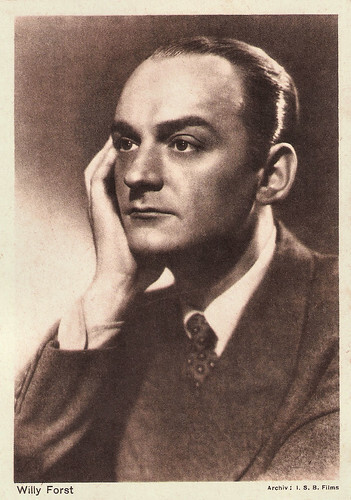
Austrian postcard by Eberle Verlag, Wien (Vienna), no. 22. Photo: I.S.B. Films.
Sources: Robert von Dassanowsky (Senses of Cinema), Thomas Staedeli (Cyranos), Filmportal.de, Wikipedia and .

German postcard by Ross Verlag, no. 6069/2, 1931-1932. Photo: Atelier Binder, Berlin.

German postcard by Ross Verlag, no. 7050/1. Photo: Ufa. Willi Forst in Ein blonder Traum (Paul Martin 1932).

German postcard by Ross Verlag, no. 7050/2, 1932-1933. Photo: Ufa.

German postcard by Ross Verlag, no. 8085/1, 1933-1934. Photo: Willinger, Wien.

German postcard by Ross Verlag, no. 8478/2, 1933-1934. Photo: Boston-Film.

German postcard by Ross Verlag, no. A 1661/1, 1937-1938. Photo: Atelier Binder, Berlin.

German postcard by Ross Verlag, no. A 3149/2, 1941-1944. Photo: Tobis.

German postcard. This could be a Ross Luxusklasse card (a fragment of a sticker on the back suggests this), but the edges of this card were cut off.
Marlene Dietrich
Willi (also written as Willy) Forst was born Wilhelm Anton Frohs in Vienna, Austria-Hungary (now Austria), in 1903. His father was the porcelain painter Wilhelm Frohs, and his mother was the miller's daughter Maria Perschl. During secondary school, he worked with some amateur theatre groups.
At age 16, he began his career as an actor. Forst got his first stage engagement in 1919 in Cieszyn, Poland, as a "second adolescent lover and comedian, with choir commitment", despite the fact that he had no actual formal training as an actor. In the following years, he acted on the provincial stages in Austria–Hungary and the German Empire and appeared as a featured performer in the post-World War I operetta theatres of Vienna and Berlin.
In 1925, he got a contract for the Berliner Metropol-Theater to appear in operettas and revues. In 1927, he returned to the prose theatre. In Berlin, he worked with the famous director Erwin Piscator at the Lessing-Theater. In 1928 an engagement to Max Reinhardt 's Deutsches Theater (German Theatre).
Forst made his film debut in the Austrian film Der Wegweiser/The Signpost (Hans Kottow, 1920). He had small parts in films like Sodom und Gomorrah/Sodom and Gomorrah (Mihaly Kertész a.k.a. Michael Curtiz, 1922) starring Lucy Doraine and Strandgut/Jetsam (Hans Karl Breslauer, 1924). He played the title role in the Austrian silent film Oh, du lieber Augustin/Oh, Dear Augustine (Hans Karl Breslauer, 1922).
From 1927 he acted regularly in films. His first major screen roles were opposite Marlene Dietrich in the silent films Café Elektric/Cafe Electric (Gustav Ucicky, 1927) and Gefahren der Brautzeit/Dangers of the Engagement Period (Fred Sauer, 1929). The latter was Dietrich's final film before her breakthrough role in Der blaue Engel/The Blue Angel (Josef von Sternberg, 1930), which made her an international star and led to her departure to Hollywood.

French postcard by Europe, no. 989. Photo: Mercure Film.

French postcard by Europe, no. 990. Photo: Mercure Film.

French postcard by Europe, no. 1073. Photo: Mercure Film.

German postcard by Ross Verlag, no. 5446/2, 1930-1931. Photo: Atelier Balázs, Berlin.

German postcard by Ross Verlag, no. 5762/1, 1930-1931. Photo: Ufa.

German postcard by Ross Verlag, no. 5762/2, 1930-1931. Photo: Ufa.

German postcard by Ross Verlag, no. 7050/3, 1932-1933. Photo: Ufa. Willi Forst in Ein Blonder Traum/A Blonde's Dream (Paul Martin, 1932).

German postcard by Ross Verlag, no. 8257/1, 1933-1934. Photo: Ufa / Cine-Allianz.
Velvety voice
Willi Forst made his sound and singing film debut in Atlantik/Titanic (Ewald André Dupont, 1929). The film was the first fully talking film to be released in Germany, where it was a major hit. Forst attracted huge attention with a scene where he sat at the piano and sang a song while the ship was sinking. While singing the sad lines "Es wird ein Wein sein, und wir wer'n nimmer sein, es wird schöne Madeln geben, und wir wer'n nimmer leben...", he suddenly realizes the cruel truth of the lyrics and collapses.
Soon, he became known for his distinctive velvety voice and 'charming Viennese' characters. He became a darling of the public with a string of operetta films. After Zwei Herzen im 3/4 Takt/Two Hearts in Waltz Time (Géza von Bolváry, 1930) with music by Robert Stolz, he played six more times under the direction of Géza von Bolváry. The piece of clothing that suited him best in these films was the tailcoat – complete with cane and top hat. He moved in it as if it were his second skin.
Most of these successes were written by Austrian-born director and screenwriter Walter Reisch, who in later Hollywood exile would script Ninotchka (Ernst Lubitsch, 1939) and Gaslight (George Cukor, 1944), and work with Billy Wilder.
Reisch also wrote Ein blonder Traum/A Blonde's Dream (Paul Martin, 1932) with Lilian Harvey and Willy Fritsch , and Der Prinz von Arkadien/The Prince from Arcadien (Karl Hartl, 1932) with Liane Haid .
Forst considered the best learning experience for his future role as director, So ein Mädel vergisst man nicht/Unforgettable Girl (1933) directed by expressionist film actor-turned-director Fritz Kortner .

German postcard by Ross Verlag, no. 7032/1, 1932-1933. Photo: Ufa. Publicity still for Ein blonder Traum/Happy Ever After (Paul Martin, 1932).

German postcard by Ross Verlag, no. 143/4, 1931-1932. Photo: Ufa. Publicity still for Ein blonder Traum/Happy Ever After (Paul Martin, 1932).

Dutch postcard by Filma, no. 426. Dolly Haas and Willi Forst in So ein Mädel vergisst man nicht/Unforgettable Girl (Fritz Kortner, 1932).

Dutch postcard by Filma, no. 449. Photo: Dolly Haas , Willi Forst and Oskar Sima in So ein Mädel vergisst man nicht/Unforgettable Girl (1932).

Latvian collector card by P. Mantnieks, Riga, for Kino Kazino. Liane Haid and Willi Forst in the Austrian-German film Der Prinz von Arkadien/The Prince of Arcadia (Karl Hartl, 1932).

German postcard by Ross Verlag, no. 8258/1, 1933-1934. Photo: Ufa / Cine Allianz. Publicity still for the romantic comedy Ihre Durchlaucht, die Verkäuferin/Her Excellency, the Salesgirl (Karl Hartl, 1933) with Liane Haid .

British postcard. Photo: publicity still for Ich Kenn Dich Nicht Und Liebe Dich/I Don't Know You, But I Love You (Géza von Bolváry, 1934) with Magda Schneider .

German collectors card in the series 'Vom Werden deutscher Filmkunst - Der Tonfilm', album no. 11, picture no. 36. Photo: Boston-Film / Ross Verlag. Magda Schneider and Willi Forst in Ich kenn' dich nicht und liebe dich/I Don't Know You, But I Love You (Géza von Bolváry, 1934).
Bel Ami
Willi Forst developed the genre of the 'Wiener Filme' with writer Walter Reisch in the 1930s, beginning with the Franz Schubert melodrama Leise flehen meine Lieder/Lover Divine (Willi Forst, 1933). Leise flehen meine Lieder was so popular throughout Europe that it was reshot in a British version for the English language market as The Unfinished Symphony (1934), co-directed by Forst and Anthony Asquith.
He followed it with the hit Maskerade/Masquerade in Vienna (Willi Forst, 1934), which launched his fame as a significant director and made an instant star of Paula Wessely . For the German film Mazurka (Willi Forst, 1935), he lured Pola Negri back from Hollywood. He rapidly developed himself into a four-way talent, as a producer, director, writer and actor in German films like Allotria/Tomfoolery(Willi Forst, 1936) with Renate Müller and Serenade (Willi Forst, 1937).
Forst briefly returned to Vienna in 1936 to film Burgtheater/The Court Theatre. The film starred Werner Krauss as a great stage actor whose life is altered by one late love. As usual in the Viennese Film, the renunciation of passion and its sublimation into art provides a dramatic conclusion. From the mid-1930s he also recorded many records, largely of sentimental Viennese songs, for the Odeon Records label owned by Carl Lindström AG. He founded his own film company in 1936. The 'Willi Forst-Film-Produktion' opened a German branch in 1937 and was shut down in 1950.
Following Austria’s annexation to Germany in March 1938, Vienna’s film industry was wholly integrated into the structure and ideology of the Third Reich and given a specific cultural mission – the production of lavish musicals, costume dramas and other 'Vienna style' entertainment films for the Reich. With strong control from Berlin, the new Viennese mega-studio Wien-Film echoed the concept of the Hollywood studio system more closely than had been normal in previous Austrian cinema development.
Many Austrian talents at Ufa in Berlin, including Forst, returned home to participate in this new phase of Vienna’s industry. From 1938 until 1945 Forst was a member of the supervisory board of the Wien Film GmbH. His best-known film for Wien Film would be the elegant satire Bel Ami (Willi Forst, 1939) based on the novel by Guy de Maupassant. He also played the title role, which would be his alter ego from then on.

Dutch Postcard by City Film, no. 151.

Dutch Postcard by JosPe, Arnhem, no. 429. Photo: Filma.

Dutch postcard by JosPe, Arnhem, no. 984. Photo: Remaco.

German postcard by Ross Verlag, no. 5700/1, 1930-1931. Photo: Super-Film.

German postcard by Ross Verlag, no. 7701/1, 1932-1933. Photo: Tonal - Universal. Publicity still for Brennendes Geheimnis/The Burning Secret (Robert Siodmak, 1933).

German postcard by Ross Verlag, no. 7702/1, 1932-1933. Photo: Tonal - Universal. Hilde Wagener and Willi Forst in Brennendes Geheimnis/The Burning Secret (Robert Siodmak, 1933).

German postcard by Ross Verlag, no. 8876/1, 1933-1934. Photo: Europea / Cine-Allianz. Willi Forst in So endete eine Liebe/End of an Affair (Karl Hartl, 1934).

Dutch postcard by M.B. & Z. for Rembrandt Theater, Haarlem Photo: Lumina Film. Willi Forst in So endete eine Liebe/End of an Affair (Karl Hartl, 1934).

German postcard by Ross Verlag, no. 9296/1, 1935-1936. Photo: Ufa. Willi Forst in Königswalzer/The Royal Waltz (Herbert Maisch, 1935).
Wiener Filme
Willi Forst was much courted by the Nazis. He succeeded in avoiding overt political statements, concentrating entirely on the light entertainment for which he was famous and which was much in demand during the war. During the seven years of National Socialist rule in Austria, he only made four films, none of them political. His most important work was his Wien-Film trilogy: Operette/Operetta (Willi Forst, 1940), Wiener Blut/Vienna Blood (Willi Forst, 1942) starring Willy Fritsch , and Wiener Mädeln/Vienna Beauties (Willi Forst, begun in 1944, but not completed until 1949). With box-office takings of seven million Reichsmarks, the operetta film Wiener Blut/Vienna Blood was one of the most financially successful films of the Nazi era.
Robert von Dassanowsky at Senses of Cinema : "Operette has become Forst’s best-known work. It is certainly a high point in the Viennese Film genre and brings together all of Forst’s talents as an auteur. As the film’s leading man, writer, director, and producer, also responsible for overseeing the artistic and music direction, his superbly orchestrated and uniquely detailed Romantic/decadent style can only be compared to the baroque silent films of Erich von Stroheim , to the elegant comedies of French director René Clair, and to the later operatically orchestrated style of Italian director Luchino Visconti ’s nineteenth-century period films (Senso, The Leopard )."
After the war, Willi Forst emerged on the postwar film scene to reestablish Austrian film as an internationally important cinema and founded a new publication in April of 1946, Film , which was edited by Josef Malinahad. In the cinema, Forst had comparatively little success, except for the film Die Sünderin/The Sinner (Willi Forst, 1951) starring Hildegard Knef and Gustav Fröhlich. The frank treatment of social and sexual mores in Germany during and after the war and a modest nude scene of Knef created a furore at the release, but the film went on to attract an audience of seven million people.
Willi Forst's last film was the comedy Wien, du Stadt meiner Träume/Vienna, City of My Dreams (Willi Forst, 1957), with Adrian Hoven and Erika Remberg . Then he retired from the film world, acknowledging that his style was no longer in demand. After the death of his wife Melanie in 1973 he lived a reclusive life in the Swiss canton of Tessin. He died of cancer in Vienna in 1980 and is buried in Neustift am Walde.
Robert von Dassanowsky writes that Forst is "one of Austrian and Central European cinema's greatest filmmakers and influential industry figures, whose lack of presence in the international film 'canon' of important directors today is one more casualty from the negligence that has greeted Austrian cinema since the collapse of its commercial film industry in the 1960s."

Spanish collector's card by I.G. Viladot, Barcelona. Image: Cifesa.

Dutch postcard by JSA, no. 232. Photo: Freiherr Wolff von Gudenberg. [Baron] Wolff von Gudenberg (1890-1961) was a noted and fashionable photographer in the 1920s and 1930s.

German postcard by Ross Verlag, no. A 1661/1, 1937-1938. Photo: Alex Binder, Berlin.

German postcard for Das Programma von Heute für Film und Theater by Ross Verlag. Photo: Lichtenstein, Berlin.

German postcard by Ross Verlag, no. 519, 1941-1944. Photo: Atelier Balázs, Berlin.

Austrian postcard by Eberle Verlag, Wien (Vienna), no. 22. Photo: I.S.B. Films.
Sources: Robert von Dassanowsky (Senses of Cinema), Thomas Staedeli (Cyranos), Filmportal.de, Wikipedia and .
Published on May 30, 2024 22:00
May 29, 2024
The Kid from Spain (1932)
The Kid from Spain (1932) is an American pre-Production-Code black-and-white musical comedy starring Eddie Cantor. The film was directed by Leo McCarey and produced by Samuel Goldwyn. Harry Ruby and Bert Kalmar composed the songs, and Busby Berkeley is credited with creating and directing the film's musical scenes. The film was a considerable financial hit in its day.

British postcard in the Famous Film Stars series by Valentine's, no. 7123A. Eddie Cantor in The Kid from Spain (Leo McCarey, 1932). Caption: Eddie Cantor, whose real name is Izzy Iskowitch, was born 31st January 1893 in New York. Beginning life as a newsboy, he ultimately appeared in Vaudeville and has risen to great fame as a star. A few of his successes are Whoopee, Palmy Days, The Kid from Spain and Roman Scandals.
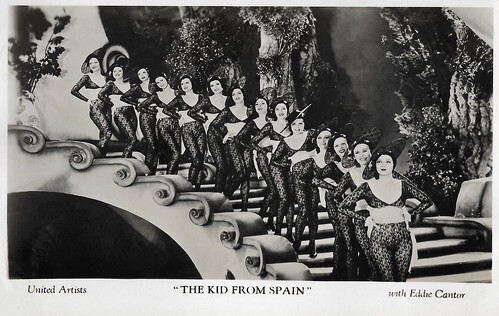
British postcard in the Film Shots series by Film Weekly. Photo: United Artists. The Goldwyn Girls in The Kid from Spain (Leo McCarey, 1932).
The only bullfighter from the USA
The Kid from Spain was shot at the Samuel Goldwyn Studios in West Hollywood at the beginning of 1932. Two years before shooting began, Eddie Cantor talked to Samuel Goldwyn about one of his film ideas.
Cantor suggested playing a googly-eyed Jewish lout from Brooklyn who became the best bullfighter in the world. Cantor's friend Sidney Franklin, the only bullfighter from the USA at the time, was the godfather of this idea.
Eddie Williams and his friend Ricardo are about to graduate when they are expelled from university because they broke into the girls' dormitory in a drunken stupor. Ricardo persuades Eddie to accompany him to his home in Mexico to meet his girlfriend Anita Gomez.
Eddie waits for his friend outside a bank that is being robbed. The robbers think he is the driver of the getaway car and force him to drive off. In their hideout, they refrain from killing him and allow him to travel to Mexico. While Eddie waits at the border, Ricardo has already arrived in his home town. There he learns from Anita's father Alonzo that Anita is engaged to the bullfighter Pancho, who saved her mother from a gang of bandits.
Alonzo can convince Ricardo that Pancho is the better choice. Ricardo finds Eddie, who has managed to cross the border and helps him disguise himself to escape the policeman Crawford who chases him. Ricardo tells Crawford that Eddie, the famous bullfighter Don Sebastian II, takes part in an important fight the following Sunday. Crawford sees through the charade and promises to watch the battle.
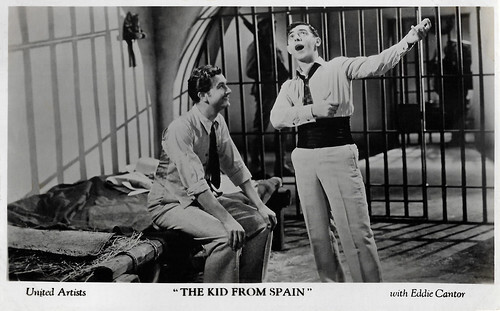
British postcard in the Film Weekly Stars series. Photo: United Artists. Robert Young and Eddie Cantor in The Kid from Spain (Leo McCarey, 1932).
A special train to the south of the country to promote the film
Filming of The Kid from Spain (1932), would start at the beginning of May under the direction of Albert S. Rogell. Due to differences with Goldwyn over the story, Rogell withdrew from the project. Enter Leo McCarey.
Eddie Cantor starred as Eddie Williams, Robert Young was miscast as his Mexican college buddy Ricardo, and Polish comic actress Lyda Roberti and Ruth Hall were their love interests, Rosalie and Anita.
In the supporting cast were John Miljan as the evil matador Pancho, Noah Beery, Sr. as Alonzo Gomez, and J. Carrol Naish as Pancho's grimy sidekick Pedro. The stock company of the Goldwyn Girls included Betty Grable , Paulette Goddard , Toby Wing, and the debuting Jane Wyman.
Bert Kalmar and Harry Ruby wrote the songs 'But We Must Rise', 'In the Moonlight', 'Look What You've Done' and 'What a Perfect Combination'. Busby Berkeley was the choreographer of the musical numbers. He was supported by Fred Zinnemann. The film also highlights the early talents of 28-year-old cinematographer Greg Toland. His camerawork shows expertise in both framing and focus, soon making him one of Hollywood's most sought-after cinematographers.
The production costs were over one million dollars (2024: approx. 22.5 million dollars). Goldwyn borrowed the money for the production from the Bank of America, which provided a seven-figure sum for a film for the first time. While United Artists took over cinema distribution, Samuel Goldwyn had reserved distribution for New York. He also sent a special train to the south of the country to promote the film and the musical Whoopee! (Thornton Freeland, 1930) in areas that either did not have a film projector or whose cinema operators did not have a rental agreement with United Artists.
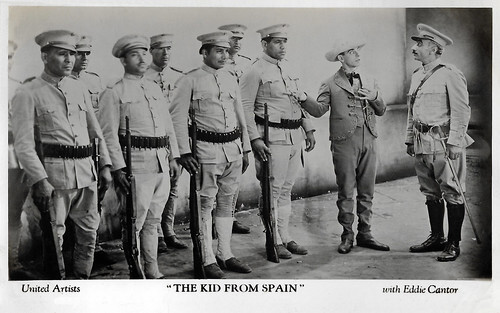
British postcard in the Film Weekly Stars series. Photo: United Artists. Eddie Cantor in The Kid from Spain (Leo McCarey, 1932).
Rolling his eyes and clapping his hands
The Kid from Spain was a huge success. With rentals gross of $2.6 million, it was number one at the American box office in 1932.
Ron Oliver at IMDb : "'Follies' star Eddie Cantor prances his way through this naughty pre-Code comedy. Rolling his eyes and clapping his hands, he uses every trick at his disposal to amuse and he succeeds quite nicely.
Cantor never slows down, but, like a mischievous little boy, he seems forever looking for new trouble to explore. His climactic scene in the bullfighting arena remains his best-remembered movie moment."
In his review at AllMovie , Craig Butler refers to a blackface sequence in the film: "While the blackface is somehow more palatable with Cantor than it is when done by Al Jolson , it still disconcerts and disturbs modern audiences, and tends to temporarily stop one's enjoyment of the film. Fortunately, director Leo McCarey keeps things moving at a snappy enough pace that the film is able to recover, and Cantor's appealing personality does help.
He's aided by the unique Lyda Roberti, who's strange but a treat, especially in her duets with Cantor. And the Busby Berkeley touches - a water ballet (in high heels) and a finale with multiple overhead shots, including one in which the girls put together a jigsaw puzzle that forms a bull's head -- are quite welcome."
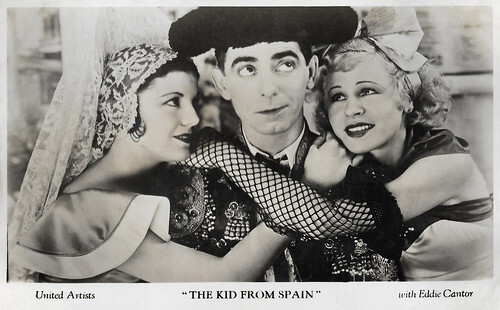
British postcard in the Film Weekly Stars series. Photo: United Artists. Ruth Hall, Eddie Cantor and Lyda Roberti in The Kid from Spain (Leo McCarey, 1932).
Sources: Ron Oliver (IMDb), Craig Butler (AllMovie), Wikipedia (English, German and Dutch), and IMDb.

British postcard in the Famous Film Stars series by Valentine's, no. 7123A. Eddie Cantor in The Kid from Spain (Leo McCarey, 1932). Caption: Eddie Cantor, whose real name is Izzy Iskowitch, was born 31st January 1893 in New York. Beginning life as a newsboy, he ultimately appeared in Vaudeville and has risen to great fame as a star. A few of his successes are Whoopee, Palmy Days, The Kid from Spain and Roman Scandals.

British postcard in the Film Shots series by Film Weekly. Photo: United Artists. The Goldwyn Girls in The Kid from Spain (Leo McCarey, 1932).
The only bullfighter from the USA
The Kid from Spain was shot at the Samuel Goldwyn Studios in West Hollywood at the beginning of 1932. Two years before shooting began, Eddie Cantor talked to Samuel Goldwyn about one of his film ideas.
Cantor suggested playing a googly-eyed Jewish lout from Brooklyn who became the best bullfighter in the world. Cantor's friend Sidney Franklin, the only bullfighter from the USA at the time, was the godfather of this idea.
Eddie Williams and his friend Ricardo are about to graduate when they are expelled from university because they broke into the girls' dormitory in a drunken stupor. Ricardo persuades Eddie to accompany him to his home in Mexico to meet his girlfriend Anita Gomez.
Eddie waits for his friend outside a bank that is being robbed. The robbers think he is the driver of the getaway car and force him to drive off. In their hideout, they refrain from killing him and allow him to travel to Mexico. While Eddie waits at the border, Ricardo has already arrived in his home town. There he learns from Anita's father Alonzo that Anita is engaged to the bullfighter Pancho, who saved her mother from a gang of bandits.
Alonzo can convince Ricardo that Pancho is the better choice. Ricardo finds Eddie, who has managed to cross the border and helps him disguise himself to escape the policeman Crawford who chases him. Ricardo tells Crawford that Eddie, the famous bullfighter Don Sebastian II, takes part in an important fight the following Sunday. Crawford sees through the charade and promises to watch the battle.

British postcard in the Film Weekly Stars series. Photo: United Artists. Robert Young and Eddie Cantor in The Kid from Spain (Leo McCarey, 1932).
A special train to the south of the country to promote the film
Filming of The Kid from Spain (1932), would start at the beginning of May under the direction of Albert S. Rogell. Due to differences with Goldwyn over the story, Rogell withdrew from the project. Enter Leo McCarey.
Eddie Cantor starred as Eddie Williams, Robert Young was miscast as his Mexican college buddy Ricardo, and Polish comic actress Lyda Roberti and Ruth Hall were their love interests, Rosalie and Anita.
In the supporting cast were John Miljan as the evil matador Pancho, Noah Beery, Sr. as Alonzo Gomez, and J. Carrol Naish as Pancho's grimy sidekick Pedro. The stock company of the Goldwyn Girls included Betty Grable , Paulette Goddard , Toby Wing, and the debuting Jane Wyman.
Bert Kalmar and Harry Ruby wrote the songs 'But We Must Rise', 'In the Moonlight', 'Look What You've Done' and 'What a Perfect Combination'. Busby Berkeley was the choreographer of the musical numbers. He was supported by Fred Zinnemann. The film also highlights the early talents of 28-year-old cinematographer Greg Toland. His camerawork shows expertise in both framing and focus, soon making him one of Hollywood's most sought-after cinematographers.
The production costs were over one million dollars (2024: approx. 22.5 million dollars). Goldwyn borrowed the money for the production from the Bank of America, which provided a seven-figure sum for a film for the first time. While United Artists took over cinema distribution, Samuel Goldwyn had reserved distribution for New York. He also sent a special train to the south of the country to promote the film and the musical Whoopee! (Thornton Freeland, 1930) in areas that either did not have a film projector or whose cinema operators did not have a rental agreement with United Artists.

British postcard in the Film Weekly Stars series. Photo: United Artists. Eddie Cantor in The Kid from Spain (Leo McCarey, 1932).
Rolling his eyes and clapping his hands
The Kid from Spain was a huge success. With rentals gross of $2.6 million, it was number one at the American box office in 1932.
Ron Oliver at IMDb : "'Follies' star Eddie Cantor prances his way through this naughty pre-Code comedy. Rolling his eyes and clapping his hands, he uses every trick at his disposal to amuse and he succeeds quite nicely.
Cantor never slows down, but, like a mischievous little boy, he seems forever looking for new trouble to explore. His climactic scene in the bullfighting arena remains his best-remembered movie moment."
In his review at AllMovie , Craig Butler refers to a blackface sequence in the film: "While the blackface is somehow more palatable with Cantor than it is when done by Al Jolson , it still disconcerts and disturbs modern audiences, and tends to temporarily stop one's enjoyment of the film. Fortunately, director Leo McCarey keeps things moving at a snappy enough pace that the film is able to recover, and Cantor's appealing personality does help.
He's aided by the unique Lyda Roberti, who's strange but a treat, especially in her duets with Cantor. And the Busby Berkeley touches - a water ballet (in high heels) and a finale with multiple overhead shots, including one in which the girls put together a jigsaw puzzle that forms a bull's head -- are quite welcome."

British postcard in the Film Weekly Stars series. Photo: United Artists. Ruth Hall, Eddie Cantor and Lyda Roberti in The Kid from Spain (Leo McCarey, 1932).
Sources: Ron Oliver (IMDb), Craig Butler (AllMovie), Wikipedia (English, German and Dutch), and IMDb.
Published on May 29, 2024 22:00
May 28, 2024
Old Heidelberg on stage and on screen
Heidelberg University or in German Ruprecht-Karls-Universität Heidelberg, is Germany's oldest university and one of the world's oldest surviving universities. It was the third university established in the Holy Roman Empire after Vienna and Prague. Heidelberg University is the setting of several films. Best known is Ernst Lubitsch's The Student Prince of Old Heidelberg (1927), starring Ramon Novarro and Norma Shearer. The play on which this film was based premiered in 1901 and was the most successful German stage play of its time. Soon it was staged all over Europe and many film adaptations followed.
On stage
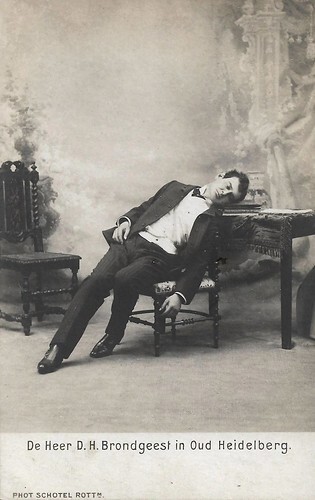
Dutch postcard, ca. 1902. Photo: Schotel, Rotterdam. The Dutch stage actor Henri (D.H.) Brondgeest as Karl Heinrich in the play 'Oud Heidelberg' (Old Heidelberg/ Alt-Heidelberg) by Wilhelm Meyer Förster. Henri Brondgeest (1865-1928) performed in this play in the season 1902/1903, with the N.V. Het Rotterdamsch Tooneelgezelschap acting under the direction of Louis Moor.
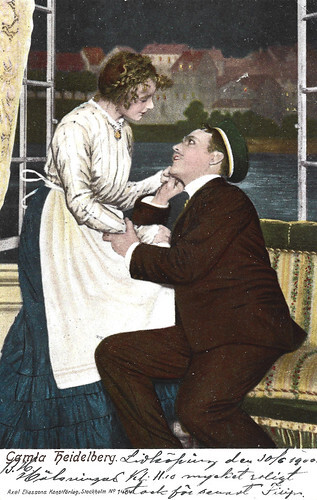
Swedish postcard by Axel Eliassons Konstförlag, no. 1484. Photo: Svenska Teatern, 1903. Anders de Wahl and Astrid Torsell in the play 'Gamla Heidelberg' (Alt Heidelberg/Old Heidelberg). The play was first performed in Sweden in 1903. De Wahl would play the lead of Prince Carl Heinrich several times. After him, Gösta Eckman would play the part often too.
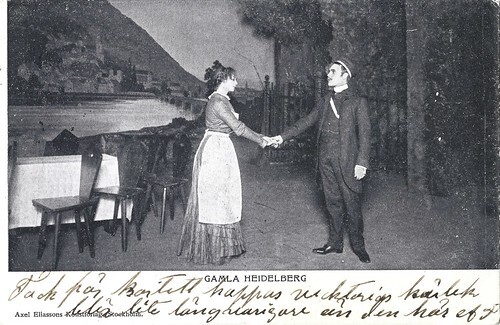
Swedish postcard by Axel Eliassons Konstförlag, Stockholm. Photo: Svenska Teatern, 1903. Anders de Wahl and Astrid Torsell in the play 'Gamla Heidelberg' (Alt Heidelberg/Old Heidelberg).

Belgian postcard by G.D.E. (G. Dupont-Emera, Bruxelles). André Brulé in the play Vieil Heidelberg (Old Heidelberg). Sent by mail in Belgium in 1908. Around 1908, Brulé must have made a large photo shoot at G. Dupont-Emera's photo studio in Brussels, as many cards with him exist published by G.D.E.
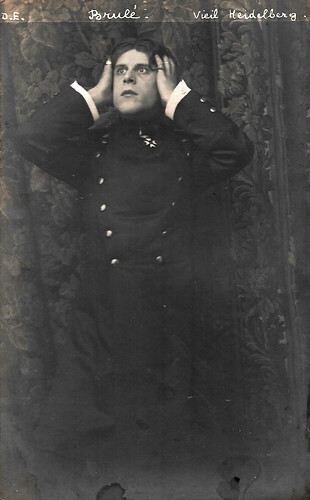
Belgian postcard. Photo by G.D.E. (G. Dupont-Emera, Rue Royale 142, Bruxelles). André Brulé in the play 'Vieil Heidelberg'.

Belgian postcard by G.D.E., Bruxelles. The card was sent by mail in 1909. André Brulé in the play 'Vieil Heidelberg' (Old Heidelberg/Alt Heidelberg) (1906).
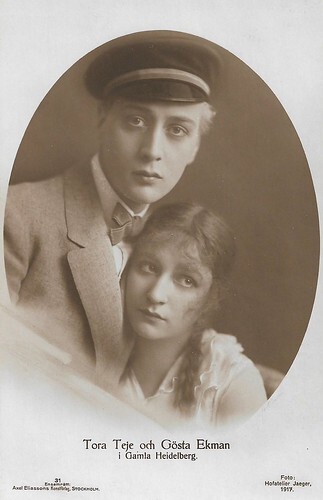
Swedish postcard by Axel Eliassons Konstförlag, Stockholm, no. 31. Photo: Hofatelier Jager, 1917. Gösta Ekman and Tora Teje in the stage play 'Gamla Heidelberg' (Old Heidelberg/The Student Prince in Old Heidelberg).
The Prince and the innkeeper's daughter
'Alt Heidelberg' (Old Heidelberg) is a German romantic play by Wilhelm Meyer-Förster, first performed at the Berliner Theater in 1901. While studying at the Heidelberg University, Prince Karl from the fictitious Duchy of Saxe-Karlsburg (derived from Saxe-Coburg). Karl-Heinrich becomes a member of the fictitious Corps Saxonia Heidelberg, immerses himself in the student fraternity and falls in love with the innkeeper's daughter Käthie. But he has to give her up when his father dies, and he is called to return to his homeland and rule as King. He leaves Heidelberg and Käthie to succeed his uncle.
'Alt Heidelberg' (Old Heidelberg) was based on Meyer-Förster's 1898 novel 'Karl Heinrich'. The play's title alludes to the poem 'Alt Heidelberg, du feine' from the 1854 epic poem 'Der Trompeter von Säckingen' by Joseph Victor von Scheffel, which became a symbol of student romanticism. Meyer-Förster's 'Alt Heidelberg' was a major international success and became one of the most-performed plays in Germany during the first half of the 20th century.
The premiere in France of 'Vieux Heidelberg' was in 1906, at the Theatre Antoine, in a translation by Maurice Remon and W. Bauer. After that, it was staged at the Odeon Theatre in Paris in the seasons 1906-1907, 1907-1908, 1912-1913 and 1931-1932.
The play had many adaptations for the cinema. John Emerson directed Old Heidelberg (1915) with Wallace Reid and Lilian Gish . In Germany the first of several film adaptations was done by Hans Behrendt in 1923, starring Paul Hartmann and Eva May . Ernst Lubitsch adapted the play as The Student Prince of Old Heidelberg (1927), starring Ramon Novarro and Norma Shearer . The hit song 'Ich hab mein Herz in Heidelberg verloren' from 1926 and the singspiel of the same name from 1927 were also based on the content of the play 'Alt-Heidelberg'.
In 1908, the play was the basis for a libretto by Alberto Colantuoni, titled 'Eidelberga Mia', with music by Ubaldo Pacchierotti. Ottoman Piltz later translated it into German in 1909 under the original German title, 'Alt Heidelberg'. The play was also turned into the operetta 'The Student Prince' (1924) by Sigmund Romberg. The operetta was the basis for the film The Student Prince (Richard Thorpe, 1954) with Edmund Purdom . The play was in the repertoire of the Heidelberg Castle Festival for thirty years and was also performed there in English with American actors. Wilhelm Meyer-Förster was made an honorary citizen of Heidelberg in 1925.
On screen
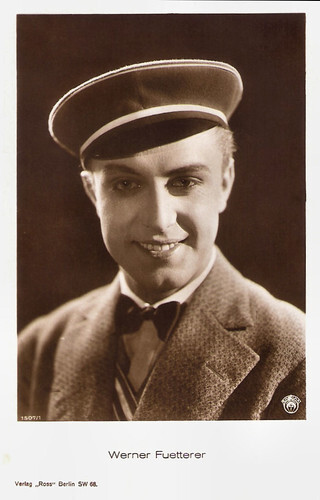
German postcard by Ross Verlag, Berlin, no. 1507/1, 1927-1928. Photo: Münchner Lichtspielkunst AG (Emelka). Werner Fuetterer in Ich hab mein Herz in Heidelberg verloren/I Lost My Heart in Heidelberg (Arthur Bergen, 1926).
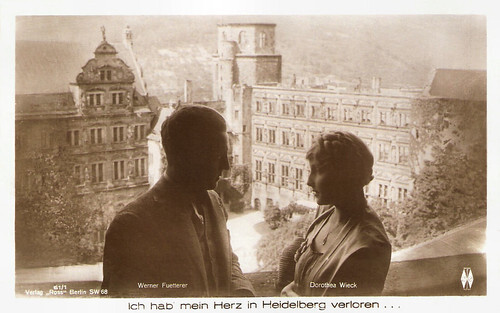
German postcard by Ross Verlag, Berlin, no. 61/1, 1926. Photo: Münchner Lichtspielkunst AG (Emelka). Bayern Films. Werner Fuetterer and Dorothea Wieck in Ich hab mein Herz in Heidelberg verloren/I Lost My Heart in Heidelberg (Arthur Bergen, 1926).
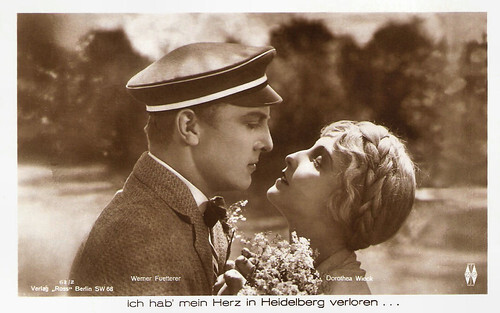
German postcard by Ross Verlag, Berlin, no. 61/2, 1926. Photo: Münchner Lichtspielkunst AG (Emelka). Bayern Films. Werner Fuetterer and Dorothea Wieck in Ich hab mein Herz in Heidelberg verloren/I Lost My Heart in Heidelberg (Arthur Bergen, 1926).
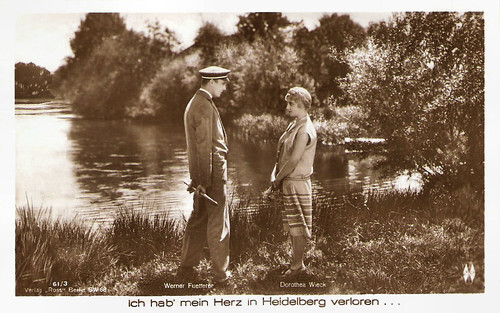
German postcard by Ross Verlag, Berlin, no. 61/3, 1926. Photo: Münchner Lichtspielkunst AG (Emelka). Bayern Films. Werner Fuetterer and Dorothea Wieck in Ich hab mein Herz in Heidelberg verloren/I Lost My Heart in Heidelberg (Arthur Bergen, 1926).
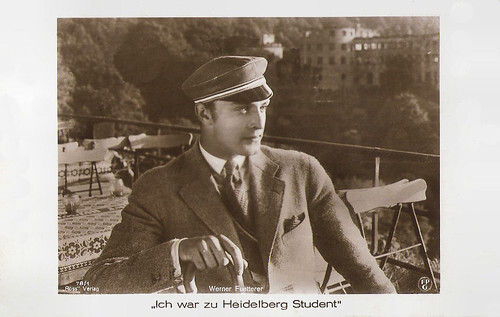
German postcard by Ross Verlag, Berlin, no. 78/1. Photo: Münchner Lichtspielkunst AG (Emelka) / FPG. Werner Fuetterer in Ich war zu Heidelberg Student/I was a student at Heidelberg (Wolfgang Neff, 1927).
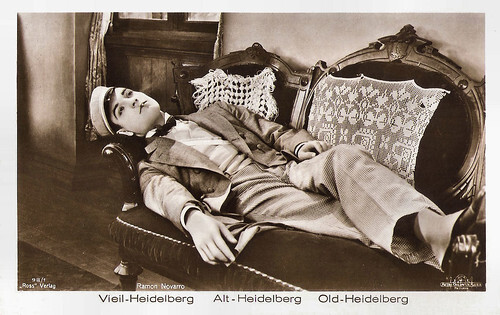
German postcard by Ross Verlag, no. 98/1. Photo: Metro-Goldwyn-Mayer. Ramon Novarro in The Student Prince/The Student Prince in Old Heidelberg (Ernst Lubitsch, 1927).
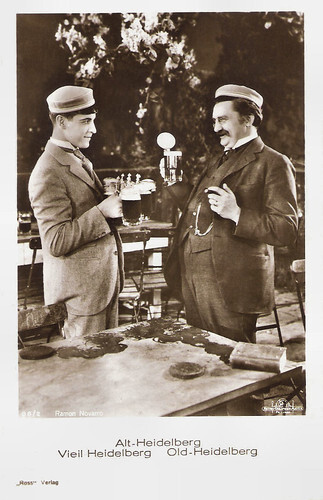
German postcard by Ross Verlag, no. 98/2. Photo: Metro-Goldwyn-Mayer. Ramon Novarro and Jean Hersholt in The Student Prince in Old Heidelberg (Ernst Lubitsch, 1927).
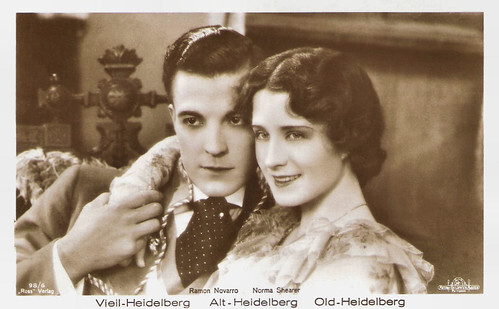
German postcard by Ross Verlag, no. 98/6. Photo: Metro-Goldwyn-Mayer. Ramon Novarro and Norma Shearer in The Student Prince in Old Heidelberg (Ernst Lubitsch, 1927).

German postcard by Ross Verlag, no. 98/9. Photo: Metro-Goldwyn-Mayer. Ramon Novarro in The Student Prince/The Student Prince in Old Heidelberg (Ernst Lubitsch, 1927).
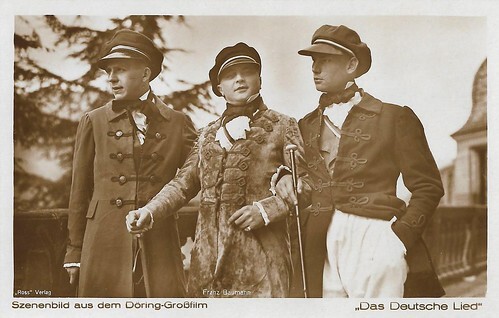
German postcard by Ross Verlag, unnumbered. Franz Baumann in Das Deutsche Lied/The German Song (Karl Pindl, 1928), produced by the Döring film company, Hannover, under the guidance [Protektorat] of the Deutsche Sängerbund (DSB). The film premiered in Vienna, Austria, at the 10th German Sängerbundesfest 19.-23.July 1928. Here Franz Baumann in the song part of the film, 'Alt Heidelberg, du feine!'.
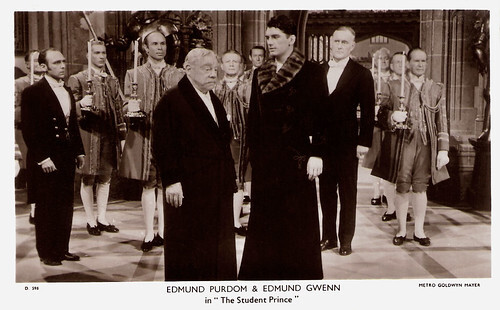
British postcard in the Picturegoer Series, no. D 598. Photo: Metro Goldwyn Mayer. Edmund Purdom and Edmund Gwenn in The Student Prince (Richard Thorpe, 1954).
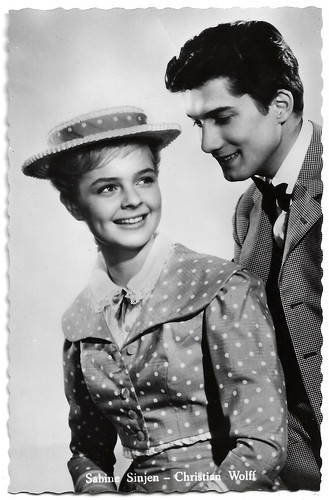
Dutch postcard by N.V. v.h. Weenenk & Snel, Baarn, no. 1066. Sabine Sinjen and Christian Wolff in Alt Heidelberg/Old Heidelberg (Ernst Marischka, 1959). Collection: Geoffrey Donaldson Institute.
Sources: Wikipedia (English and German) and IMDb.
On stage

Dutch postcard, ca. 1902. Photo: Schotel, Rotterdam. The Dutch stage actor Henri (D.H.) Brondgeest as Karl Heinrich in the play 'Oud Heidelberg' (Old Heidelberg/ Alt-Heidelberg) by Wilhelm Meyer Förster. Henri Brondgeest (1865-1928) performed in this play in the season 1902/1903, with the N.V. Het Rotterdamsch Tooneelgezelschap acting under the direction of Louis Moor.

Swedish postcard by Axel Eliassons Konstförlag, no. 1484. Photo: Svenska Teatern, 1903. Anders de Wahl and Astrid Torsell in the play 'Gamla Heidelberg' (Alt Heidelberg/Old Heidelberg). The play was first performed in Sweden in 1903. De Wahl would play the lead of Prince Carl Heinrich several times. After him, Gösta Eckman would play the part often too.

Swedish postcard by Axel Eliassons Konstförlag, Stockholm. Photo: Svenska Teatern, 1903. Anders de Wahl and Astrid Torsell in the play 'Gamla Heidelberg' (Alt Heidelberg/Old Heidelberg).

Belgian postcard by G.D.E. (G. Dupont-Emera, Bruxelles). André Brulé in the play Vieil Heidelberg (Old Heidelberg). Sent by mail in Belgium in 1908. Around 1908, Brulé must have made a large photo shoot at G. Dupont-Emera's photo studio in Brussels, as many cards with him exist published by G.D.E.

Belgian postcard. Photo by G.D.E. (G. Dupont-Emera, Rue Royale 142, Bruxelles). André Brulé in the play 'Vieil Heidelberg'.

Belgian postcard by G.D.E., Bruxelles. The card was sent by mail in 1909. André Brulé in the play 'Vieil Heidelberg' (Old Heidelberg/Alt Heidelberg) (1906).

Swedish postcard by Axel Eliassons Konstförlag, Stockholm, no. 31. Photo: Hofatelier Jager, 1917. Gösta Ekman and Tora Teje in the stage play 'Gamla Heidelberg' (Old Heidelberg/The Student Prince in Old Heidelberg).
The Prince and the innkeeper's daughter
'Alt Heidelberg' (Old Heidelberg) is a German romantic play by Wilhelm Meyer-Förster, first performed at the Berliner Theater in 1901. While studying at the Heidelberg University, Prince Karl from the fictitious Duchy of Saxe-Karlsburg (derived from Saxe-Coburg). Karl-Heinrich becomes a member of the fictitious Corps Saxonia Heidelberg, immerses himself in the student fraternity and falls in love with the innkeeper's daughter Käthie. But he has to give her up when his father dies, and he is called to return to his homeland and rule as King. He leaves Heidelberg and Käthie to succeed his uncle.
'Alt Heidelberg' (Old Heidelberg) was based on Meyer-Förster's 1898 novel 'Karl Heinrich'. The play's title alludes to the poem 'Alt Heidelberg, du feine' from the 1854 epic poem 'Der Trompeter von Säckingen' by Joseph Victor von Scheffel, which became a symbol of student romanticism. Meyer-Förster's 'Alt Heidelberg' was a major international success and became one of the most-performed plays in Germany during the first half of the 20th century.
The premiere in France of 'Vieux Heidelberg' was in 1906, at the Theatre Antoine, in a translation by Maurice Remon and W. Bauer. After that, it was staged at the Odeon Theatre in Paris in the seasons 1906-1907, 1907-1908, 1912-1913 and 1931-1932.
The play had many adaptations for the cinema. John Emerson directed Old Heidelberg (1915) with Wallace Reid and Lilian Gish . In Germany the first of several film adaptations was done by Hans Behrendt in 1923, starring Paul Hartmann and Eva May . Ernst Lubitsch adapted the play as The Student Prince of Old Heidelberg (1927), starring Ramon Novarro and Norma Shearer . The hit song 'Ich hab mein Herz in Heidelberg verloren' from 1926 and the singspiel of the same name from 1927 were also based on the content of the play 'Alt-Heidelberg'.
In 1908, the play was the basis for a libretto by Alberto Colantuoni, titled 'Eidelberga Mia', with music by Ubaldo Pacchierotti. Ottoman Piltz later translated it into German in 1909 under the original German title, 'Alt Heidelberg'. The play was also turned into the operetta 'The Student Prince' (1924) by Sigmund Romberg. The operetta was the basis for the film The Student Prince (Richard Thorpe, 1954) with Edmund Purdom . The play was in the repertoire of the Heidelberg Castle Festival for thirty years and was also performed there in English with American actors. Wilhelm Meyer-Förster was made an honorary citizen of Heidelberg in 1925.
On screen

German postcard by Ross Verlag, Berlin, no. 1507/1, 1927-1928. Photo: Münchner Lichtspielkunst AG (Emelka). Werner Fuetterer in Ich hab mein Herz in Heidelberg verloren/I Lost My Heart in Heidelberg (Arthur Bergen, 1926).

German postcard by Ross Verlag, Berlin, no. 61/1, 1926. Photo: Münchner Lichtspielkunst AG (Emelka). Bayern Films. Werner Fuetterer and Dorothea Wieck in Ich hab mein Herz in Heidelberg verloren/I Lost My Heart in Heidelberg (Arthur Bergen, 1926).

German postcard by Ross Verlag, Berlin, no. 61/2, 1926. Photo: Münchner Lichtspielkunst AG (Emelka). Bayern Films. Werner Fuetterer and Dorothea Wieck in Ich hab mein Herz in Heidelberg verloren/I Lost My Heart in Heidelberg (Arthur Bergen, 1926).

German postcard by Ross Verlag, Berlin, no. 61/3, 1926. Photo: Münchner Lichtspielkunst AG (Emelka). Bayern Films. Werner Fuetterer and Dorothea Wieck in Ich hab mein Herz in Heidelberg verloren/I Lost My Heart in Heidelberg (Arthur Bergen, 1926).

German postcard by Ross Verlag, Berlin, no. 78/1. Photo: Münchner Lichtspielkunst AG (Emelka) / FPG. Werner Fuetterer in Ich war zu Heidelberg Student/I was a student at Heidelberg (Wolfgang Neff, 1927).

German postcard by Ross Verlag, no. 98/1. Photo: Metro-Goldwyn-Mayer. Ramon Novarro in The Student Prince/The Student Prince in Old Heidelberg (Ernst Lubitsch, 1927).

German postcard by Ross Verlag, no. 98/2. Photo: Metro-Goldwyn-Mayer. Ramon Novarro and Jean Hersholt in The Student Prince in Old Heidelberg (Ernst Lubitsch, 1927).

German postcard by Ross Verlag, no. 98/6. Photo: Metro-Goldwyn-Mayer. Ramon Novarro and Norma Shearer in The Student Prince in Old Heidelberg (Ernst Lubitsch, 1927).

German postcard by Ross Verlag, no. 98/9. Photo: Metro-Goldwyn-Mayer. Ramon Novarro in The Student Prince/The Student Prince in Old Heidelberg (Ernst Lubitsch, 1927).

German postcard by Ross Verlag, unnumbered. Franz Baumann in Das Deutsche Lied/The German Song (Karl Pindl, 1928), produced by the Döring film company, Hannover, under the guidance [Protektorat] of the Deutsche Sängerbund (DSB). The film premiered in Vienna, Austria, at the 10th German Sängerbundesfest 19.-23.July 1928. Here Franz Baumann in the song part of the film, 'Alt Heidelberg, du feine!'.

British postcard in the Picturegoer Series, no. D 598. Photo: Metro Goldwyn Mayer. Edmund Purdom and Edmund Gwenn in The Student Prince (Richard Thorpe, 1954).

Dutch postcard by N.V. v.h. Weenenk & Snel, Baarn, no. 1066. Sabine Sinjen and Christian Wolff in Alt Heidelberg/Old Heidelberg (Ernst Marischka, 1959). Collection: Geoffrey Donaldson Institute.
Sources: Wikipedia (English and German) and IMDb.
Published on May 28, 2024 22:00
May 27, 2024
La Collectionneuse: Sonja Henie
Sonja Henie had been an outstanding skating champion, a popular performer of ice shows, a movie star and an art collector. Her career was marked by her ambition, determination, strong drive, boldness and professionalism. The ice fairy, who was a forerunner, first in her sport, then in the entertainment world, was an undisputed queen in her field and amassed a considerable fortune over the years.

German postcard by Sachsenstern-Zigarette in the series 'Berühmte Tänzerinnen und Tänzer'. Photo: Engadin Press, Samaden.
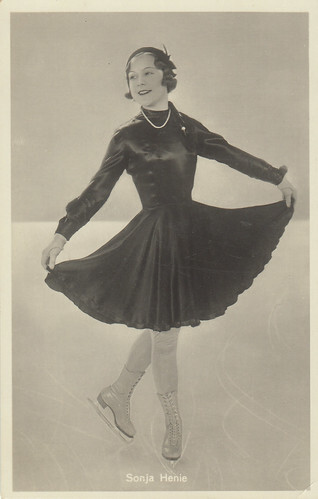
German postcard by Verlag Kunstanstalt Vorenberg, Berlin, no. 0932.
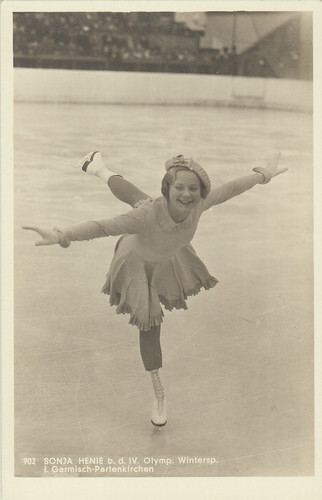
German postcard by B. Johannes (Beckert), Garmisch-Partenkirchen, no. 902. Caption: Sonja Henie at the IV Olympic Winter Games at Garmisch-Partenkirchen in 1936.
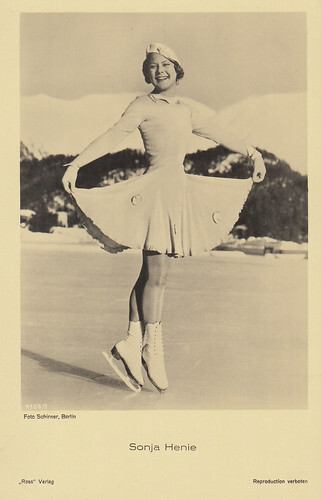
German postcard by Ross Verlag, no. 9126/1, 1935-1936. Photo: Schirner, Berlin.
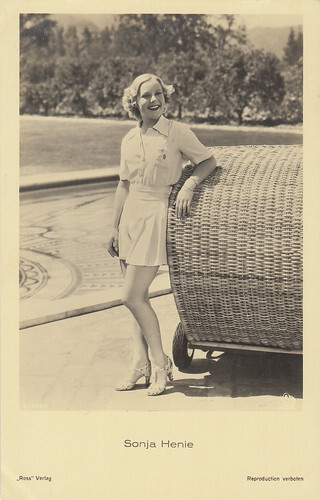
German postcard by Ross Verlag, no. A 1006/1, 1937-1938. Photo: 20th Century Fox.
A prominent skating champion
Sonja Henie was born on the 8th of April 1912 in Oslo, Norway. Her father, a wealthy fur wholesaler, had been a track cycling World Champion in 1894 and had competed in the 1896 European Speed Skating Championships. He saw to it that his two children, Leif and Sonja, would be deeply involved in sporting activities.
From an early age, Sonja showed outstanding skating skills and soon won a championship event for kids. Her parents strongly supported her and she was trained by ice-skating instructors to prepare her for becoming a champion. At the same time, she took ballet lessons, which would later prove to be very useful.
In 1923, she won her first national Championship of Norway, a feat she repeated six times, from 1924 to 1929. In 1924, she competed at the Winter Olympic Games in Chamonix but finished at the last place. She probably was too young to compete with much more experienced athletes but she would later take her revenge. For ten consecutive years, from 1927 to 1936, the 'Pavlova of the ice', as she was called, won the World Figure Skating Championships.
From 1931 to 1936, she also won the European Championships. In 1928, 1932 and 1936, she was awarded Gold Medals at the Olympic Games. Her impressive record of Championship trophies and Olympic Medals has never been equalled by any other skater. Sonja was the most influential and innovative female skater of her time. She incorporated graceful ballet movements into her skating, which made her stand out.
She allegedly was the first female skater to perform an Axel in competition and is credited with introducing short skirts and white skating shoes to her sport. Her fame helped to make skating more popular and trendy. During her championship career, she performed in skating exhibitions and there were rumours that her father was receiving huge fees to ensure his daughter’s appearances. Her official amateur status began to be questioned, although no sporting authorities ever dared to sanction her.
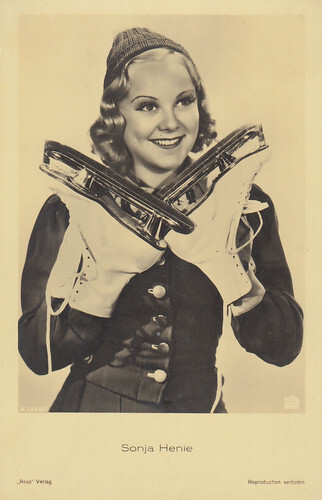
German postcard by Ross Verlag, no. A 1355/1, 1937-1938. Photo: 20th Century Fox.
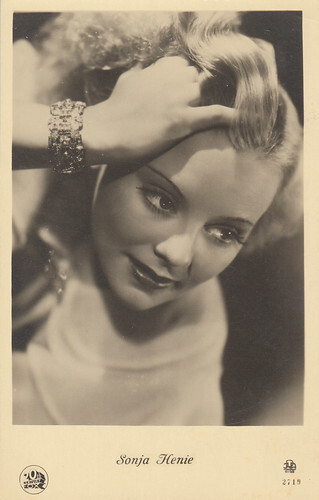
Latvian postcard by EMBR, no. 2719. Photo: 20th Century Fox.
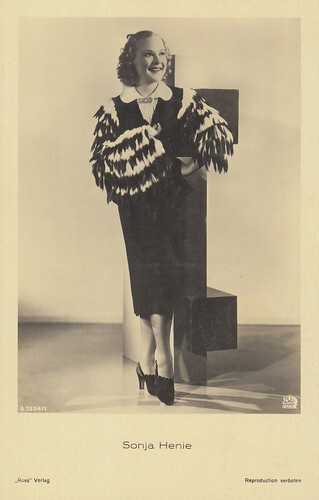
German postcard by Ross Verlag, no. A 1534/1, 1937-1938. Photo: 20th Century Fox.
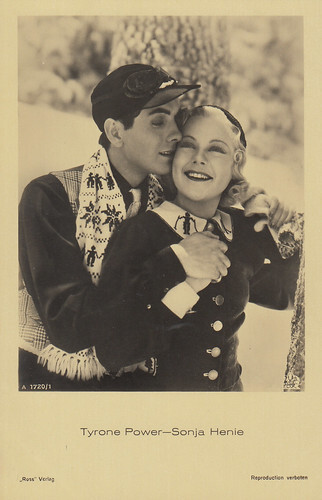
German postcard by Ross Verlag, no. A 1720/1, 1937-1938. Photo: 20th Century Fox. Tyrone Power and Sonja Henie in Thin Ice (Sidney Lanfield, 1937).
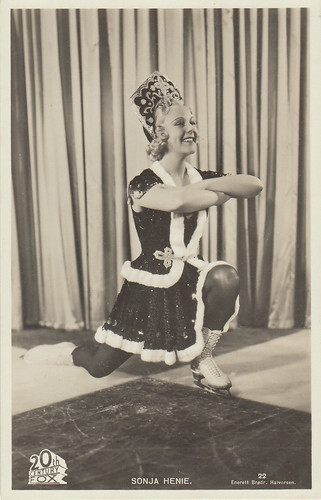
Norwegian postcard by Enerett Brodr. Halvorsen, no. 22. Photo: 20th Century Fox. Sonja Henie in Thin Ice (Sidney Lanfield, 1937).
Turning professional and going to Hollywood
In 1936, in the U.S.A., Sonja Henie turned professional. She soon signed with entrepreneur Arthur Wirtz for a series of skating extravaganzas on stage. She made her debut in a very successful show at Madison Square Garden in March and then went on tour.
On the 7th and 9th of May of 1936, she gave two shows at the Polar Palace in Los Angeles, as she wanted movie producers to take an interest in her. Sonja had always dreamed of becoming a film star.
For the record, she had made a brief appearance, as a skater, in the Norwegian film, Syv dager for Elisabeth/Seven Days for Elizabeth (Leif Sinding, 1927).
Darryl Zanuck offered her a contract but soon realised that Sonja was an ambitious young girl with a shrewd business sense. She flatly refused to be used in a skating number guest spot and demanded to make her Hollywood debut in a starring part.
Henie also made sure that her contract would guarantee a limited filming schedule so she could go on tour with her lucrative ice shows. Faced with such determination, Zanuck had to comply but he didn’t regret it as her first 20th Century Fox movie, One in a Million (Sidney Lanfield, 1936) was a smash hit.
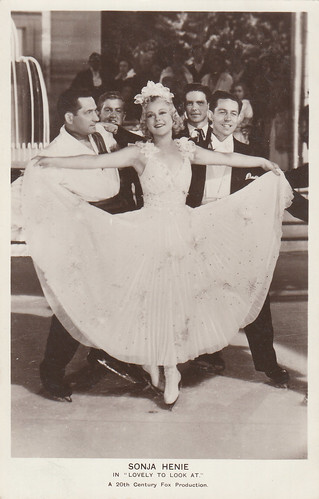
British postcard by Picturegoer, no. FS124. Photo: 20th Century Fox. Sonja Henie in Thin Ice (Sidney Lanfield, 1937). The film was released in England as Lovely to Look at.
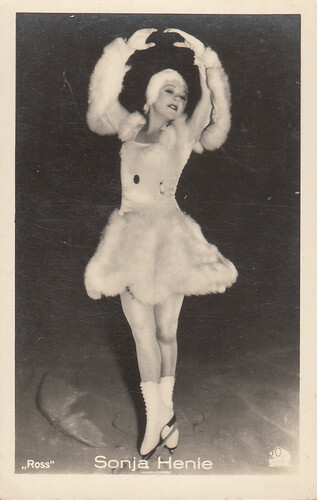
German collector card by Ross Verlag. Photo: 20th Century Fox.
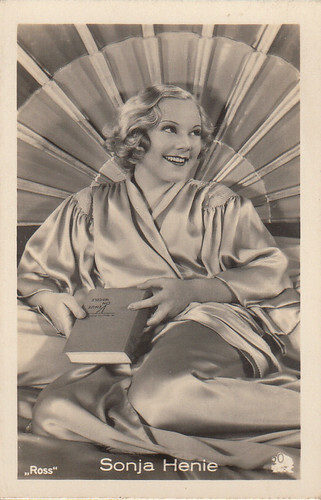
German collector card by Ross Verlag. Photo: 20th Century Fox.
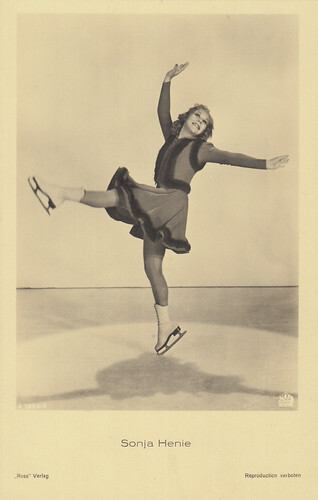
German postcard by Ross Verlag, no. A 1846/2, 1937-1938. Photo: 20th Century Fox.
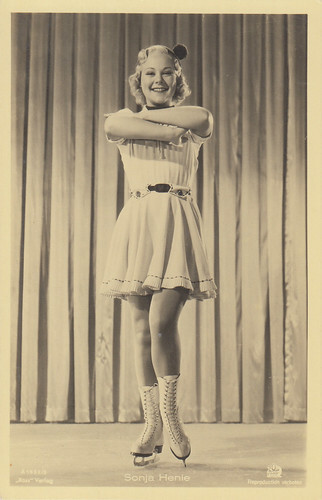
German postcard by Ross Verlag, no. A 1952/2, 1937-1938. Photo: 20th Century Fox.
Movie star
In 1937, 1938 and 1939, Sonja Henie was on the list of the ten most popular stars at the U.S. box office and became one of the highest-paid actresses in Hollywood. She was cute and had an effervescent charm and personality which transferred well to the screen but her acting skills were quite limited. Anyway, 20th Century Fox knew that audiences were mainly attracted by Sonja’s impressive skating numbers and spared no expense in giving her fans what they wanted.
Her motion pictures were always given high production values: strong supporting casts, beautiful sets, inventive choreography, innovative techniques for her ice numbers, etc. In her second movie, Thin Ice (Sidney Lanfield, 1937), she co-starred with Tyrone Power , who was her lover at the time.
Happy Landing (Roy Del Ruth, 1938) and My Lucky Star (Roy Del Ruth, 1938) followed. Second Fiddle (Sidney Lanfield, 1939) reunited her with Tyrone Power but their affair was over at the time and he would marry Annabella in April 1939.
After Everything Happens at Night (Irving Cummings, 1939), she starred in Sun Vally Serenade (H. Bruce Humberstone, 1941), which benefited from the novelty of seeing Sonja skating on black ice and from Glenn Miller Orchestra’s musical numbers.
Her 20th Century Fox contract ended with Iceland (H. Bruce Humberstone, 1942) and Wintertime (John Brahm, 1943). At that time, the relationship between Sonja and Zanuck had become tense. She then signed a two-picture deal with International Pictures and starred in It’s a Pleasure (William A. Seiter, 1945) and The Countess of Monte Cristo (Frederick De Cordova, 1948). The first one was released by R.K.O and the second by Universal.
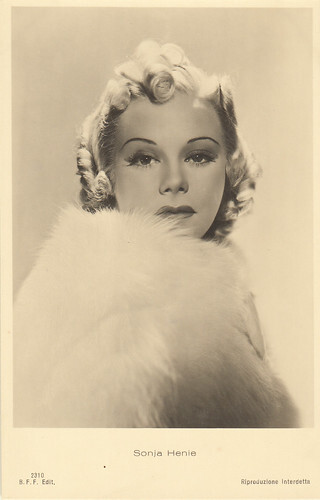
Italian postcard by Ballerini & Fratini, Firenze, no. 2310.
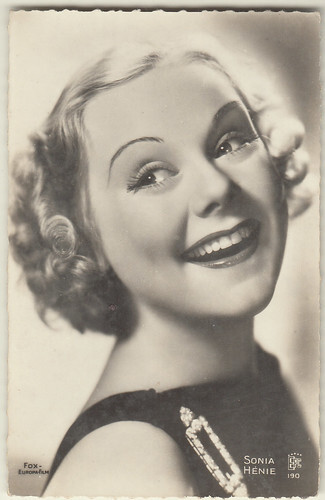
French postcard by Editions et Publications Cinématographiques (EPC), no. 190. Photo: Fox - Europa Film.
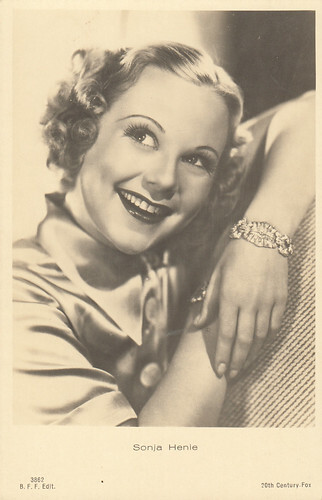
Italian postcard by Ballerini & Fratini, Firenze, no. 3862. Photo: 20th Century Fox.
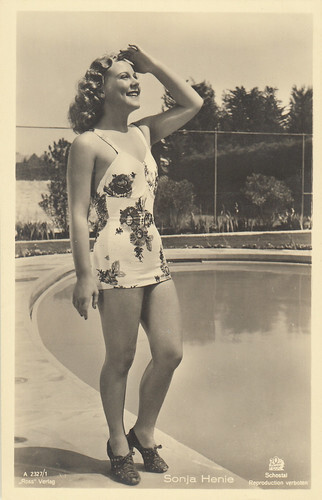
German postcard by Ross Verlag, no. A 2327/1, 1939-1940. Photo: Schostal / 20th Century Fox.
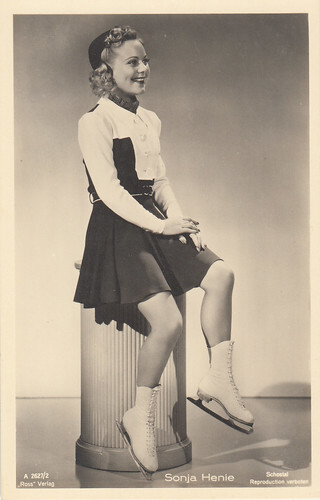
German postcard by Ross Verlag, no. A 2627/2, 1939-1940. Photo: Schostal. Photo: 20th Century Fox.
On stage
Since she had become professional in 1936, Sonja Henie had made a fortune by regularly appearing in lavish and hugely popular ice shows. As famous critic Richard Watts Jr. wrote in The New York Herald Tribune: "There is no entertainer in the world today who captures, holds and enraptures her audiences with more devastating conclusiveness".
At the beginning of the 1950s, she broke her business partnership with Arthur Wirtz and decided to produce her shows on her own. It was a mistake, as Wirtz had an enviable position in the sports world and had a monopoly on most of the major and best rinks in the U.S.A. Sonja’s shows had to play smaller and sometimes second-rate venues. Furthermore, an undaunted Wirtz had put on a new ice revue starring a younger skater, Olympic champion Barbara Ann Scott, which quite upset Sonja.
Without Wirtz’s guidance and expertise, the 1951-1952 season was a financial failure for her. Fortunately, Morris Chalfen, who, since 1945, was involved in the production ot the 'Holiday on Ice' shows, signed her for a 1953 European tour, which was a triumph. Sonja's career regained momentum and she continued to appear on stage over the next few years.
Sadly, things were going to take a bad turn when Chalfen arranged for her a South American tour in 1956, which was a flop. Venezuelan and Brazilian audiences’ reaction to Sonja’s skating numbers remained lukewarm, which she was not accustomed to. She allegedly had drinking problems at the time and it showed in her performances as, physically and mentally, she wasn’t in top form.
That unfortunate experience affected her and hastened her decision to give up ice shows. On the 6th of June 1956, she married Norwegian shipping magnate Niels Onstad. She had been previously married to Dan Topping from 1940 to 1946 and to Winthrop Gardiner from 1949 to 1956.
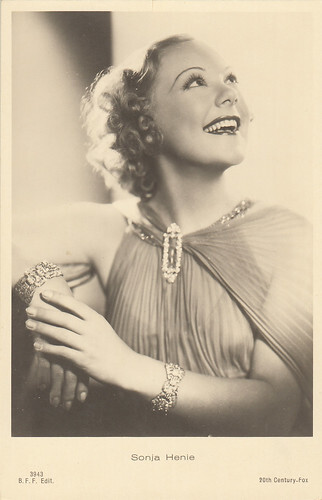
Italian postcard by Ballerini & Fratini, Firenze, no. 3943. Photo: 20the Century Fox.
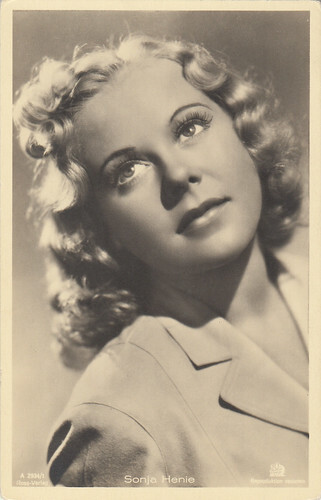
German postcard by Ross Verlag, no. A 2934/1, 1939-1940. Photo: 20th Century Fox.
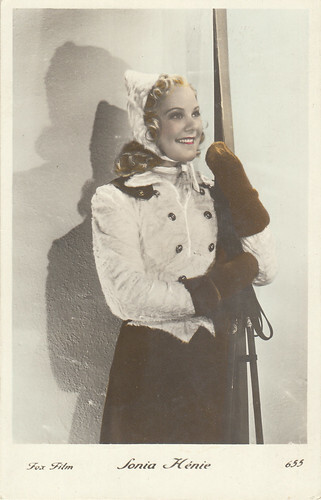
French postcard by Erpé, no. 655. Photo: Fox Film.
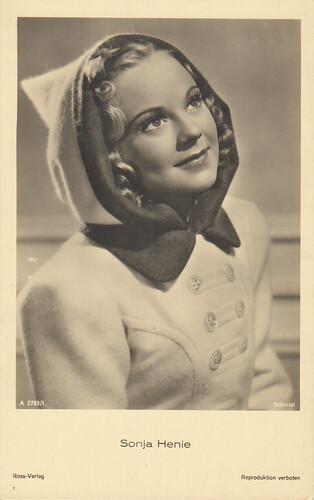
German postcard by Ross Verlag, no. A 2793/1, 1939-1940. Photo: Schostal.
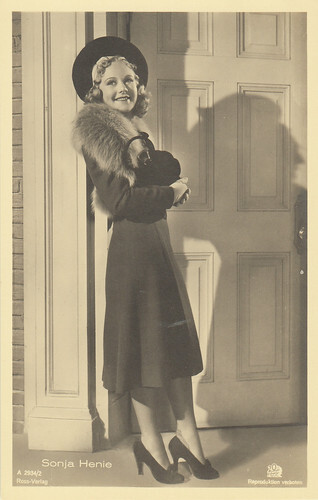
German postcard by Ross Verlag, no. A 2934/2, 1939-1940. Photo: 20th Century Fox.
An ill-fated return to the screen
At the end of the 1950s, Sonja Henie returned to the screen. She backed Hello London (Sid Smith, 1958), which was a kind of pseudo-documentary / travelogue in which she and other well-known performers, such as Michael Wilding and Eunice Gayson, appeared as themselves.
Sonja had planned this film as the first of a series but it was never to be. Hello London (1958) only received a limited release and this was the last time audiences ever saw her on ice.
Her marriage to Niels Onstad opened a new chapter in Sonja’s life, as he introduced her to Modern Art. She quickly deepened her interest in that field. Until then, she had mostly bought Old Master’s paintings.
In 1961, the couple established the Sonja Henie and Niels Onstad Foundation. Its aim was to finance the building of a museum of Modern Art in Norway, to which they would donate their art collection, which included paintings by Picasso, Léger, Bonnard, Matisse, Alechinsky, etc.
The Henie Onstad Kunstsenter (the Henie Onstad Art Center) was inaugurated with great fanfare in August 1968 by the King of Norway. Since its opening, the museum’s collection has continued to grow. The Art Center, located in Berum near Oslo, is today one of Norway’s leading institutions for the local and international art scene. An exhibition room in the museum is dedicated to Sonja, which displays her sporting trophies and some of her private objects.
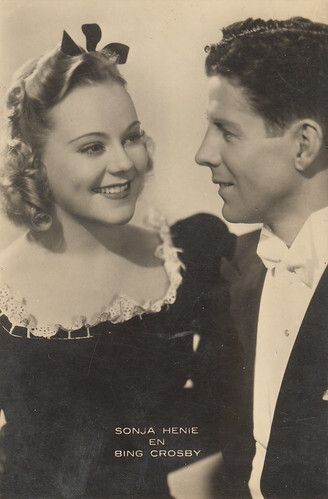
Dutch postcard by Sparo. Sonja Henie and Rudy Vallee (miscaptioned as Bing Crosby ) in Second Fiddle (Sidney Lanfield, 1939).
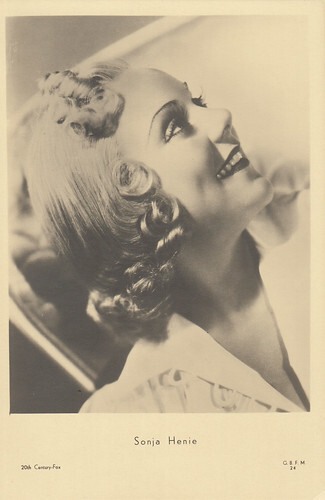
Italian postcard by G.B. Falci Editore, no. 24. Photo: 20th Century Fox.
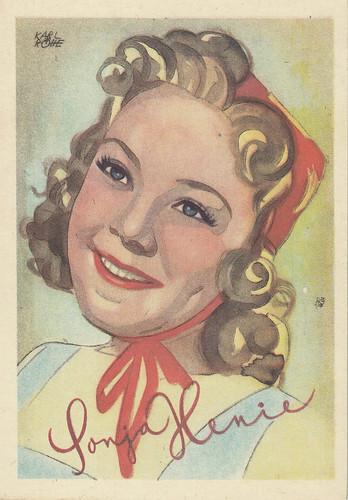
Possibly German or Austrian postcard. Illustration: Karl Rohe.
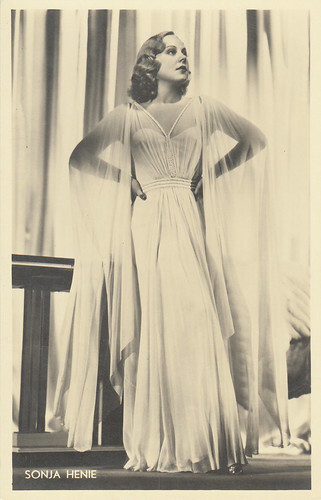
Dutch postcard by J.S.A.
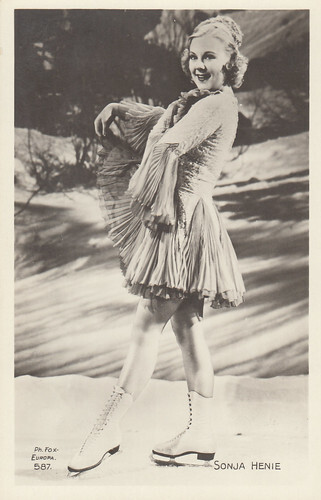
French postcard by Editions Chantal, no. 587. Photo: Fox-Europa.
A comeback which would never happen
At the end of the 1960s, Sonja Henie envisioned a comeback in a special TV ice show, in which she would allegedly have skated to Dr. Zhivago’s 'Lara’s Theme', but she would never have the opportunity to do so.
In the last months of 1968, she was diagnosed with leukemia and died in her sleep, on a plane from Paris to Oslo, on the 12th of October 1969.
At the time of her death, Sonja Henie was considered one of the richest women in the world and notably had built up a fabulous collection of jewellery over the years.
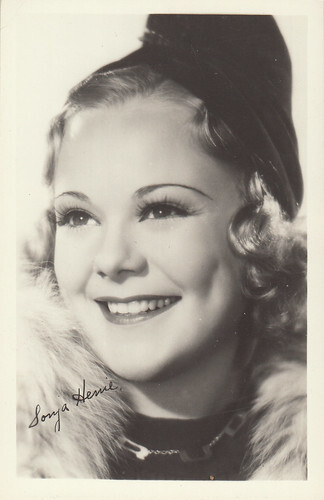
American postcard.
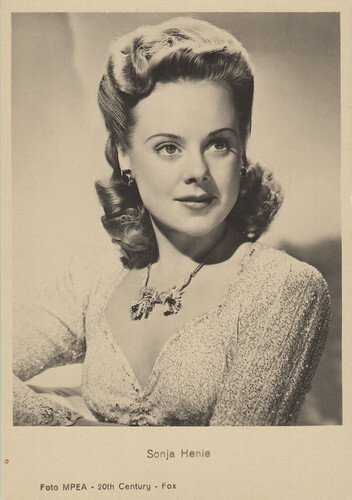
Czech postcard by Ceskoslovenské filmové nakladatelstvi (CSFN), Prague, no. 87. Photo: M.P.E.A. / 20th Century Fox.
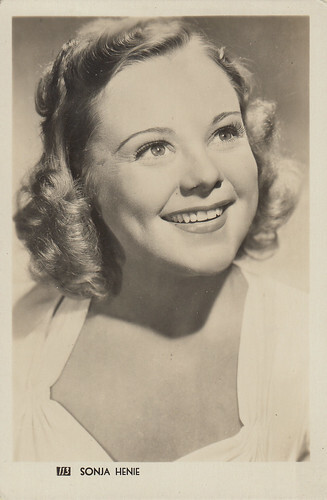
Spanish postcard, no. 113.
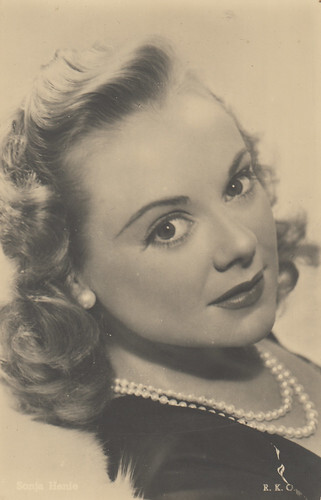
Dutch postcard by MPEA. Photo: R.K.O.
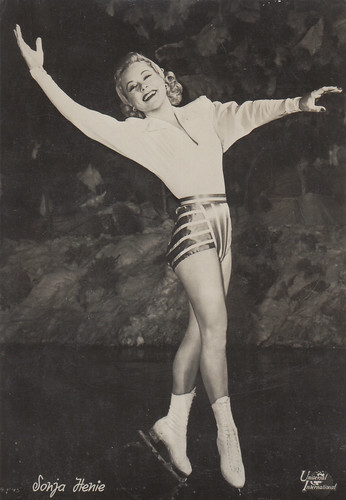
Belgian postcard by Fotoprim, Bruxelles, no. 28. Photo: Universal International.
Text and postcards: Marlène Pilaete.

German postcard by Sachsenstern-Zigarette in the series 'Berühmte Tänzerinnen und Tänzer'. Photo: Engadin Press, Samaden.

German postcard by Verlag Kunstanstalt Vorenberg, Berlin, no. 0932.

German postcard by B. Johannes (Beckert), Garmisch-Partenkirchen, no. 902. Caption: Sonja Henie at the IV Olympic Winter Games at Garmisch-Partenkirchen in 1936.

German postcard by Ross Verlag, no. 9126/1, 1935-1936. Photo: Schirner, Berlin.

German postcard by Ross Verlag, no. A 1006/1, 1937-1938. Photo: 20th Century Fox.
A prominent skating champion
Sonja Henie was born on the 8th of April 1912 in Oslo, Norway. Her father, a wealthy fur wholesaler, had been a track cycling World Champion in 1894 and had competed in the 1896 European Speed Skating Championships. He saw to it that his two children, Leif and Sonja, would be deeply involved in sporting activities.
From an early age, Sonja showed outstanding skating skills and soon won a championship event for kids. Her parents strongly supported her and she was trained by ice-skating instructors to prepare her for becoming a champion. At the same time, she took ballet lessons, which would later prove to be very useful.
In 1923, she won her first national Championship of Norway, a feat she repeated six times, from 1924 to 1929. In 1924, she competed at the Winter Olympic Games in Chamonix but finished at the last place. She probably was too young to compete with much more experienced athletes but she would later take her revenge. For ten consecutive years, from 1927 to 1936, the 'Pavlova of the ice', as she was called, won the World Figure Skating Championships.
From 1931 to 1936, she also won the European Championships. In 1928, 1932 and 1936, she was awarded Gold Medals at the Olympic Games. Her impressive record of Championship trophies and Olympic Medals has never been equalled by any other skater. Sonja was the most influential and innovative female skater of her time. She incorporated graceful ballet movements into her skating, which made her stand out.
She allegedly was the first female skater to perform an Axel in competition and is credited with introducing short skirts and white skating shoes to her sport. Her fame helped to make skating more popular and trendy. During her championship career, she performed in skating exhibitions and there were rumours that her father was receiving huge fees to ensure his daughter’s appearances. Her official amateur status began to be questioned, although no sporting authorities ever dared to sanction her.

German postcard by Ross Verlag, no. A 1355/1, 1937-1938. Photo: 20th Century Fox.

Latvian postcard by EMBR, no. 2719. Photo: 20th Century Fox.

German postcard by Ross Verlag, no. A 1534/1, 1937-1938. Photo: 20th Century Fox.

German postcard by Ross Verlag, no. A 1720/1, 1937-1938. Photo: 20th Century Fox. Tyrone Power and Sonja Henie in Thin Ice (Sidney Lanfield, 1937).

Norwegian postcard by Enerett Brodr. Halvorsen, no. 22. Photo: 20th Century Fox. Sonja Henie in Thin Ice (Sidney Lanfield, 1937).
Turning professional and going to Hollywood
In 1936, in the U.S.A., Sonja Henie turned professional. She soon signed with entrepreneur Arthur Wirtz for a series of skating extravaganzas on stage. She made her debut in a very successful show at Madison Square Garden in March and then went on tour.
On the 7th and 9th of May of 1936, she gave two shows at the Polar Palace in Los Angeles, as she wanted movie producers to take an interest in her. Sonja had always dreamed of becoming a film star.
For the record, she had made a brief appearance, as a skater, in the Norwegian film, Syv dager for Elisabeth/Seven Days for Elizabeth (Leif Sinding, 1927).
Darryl Zanuck offered her a contract but soon realised that Sonja was an ambitious young girl with a shrewd business sense. She flatly refused to be used in a skating number guest spot and demanded to make her Hollywood debut in a starring part.
Henie also made sure that her contract would guarantee a limited filming schedule so she could go on tour with her lucrative ice shows. Faced with such determination, Zanuck had to comply but he didn’t regret it as her first 20th Century Fox movie, One in a Million (Sidney Lanfield, 1936) was a smash hit.

British postcard by Picturegoer, no. FS124. Photo: 20th Century Fox. Sonja Henie in Thin Ice (Sidney Lanfield, 1937). The film was released in England as Lovely to Look at.

German collector card by Ross Verlag. Photo: 20th Century Fox.

German collector card by Ross Verlag. Photo: 20th Century Fox.

German postcard by Ross Verlag, no. A 1846/2, 1937-1938. Photo: 20th Century Fox.

German postcard by Ross Verlag, no. A 1952/2, 1937-1938. Photo: 20th Century Fox.
Movie star
In 1937, 1938 and 1939, Sonja Henie was on the list of the ten most popular stars at the U.S. box office and became one of the highest-paid actresses in Hollywood. She was cute and had an effervescent charm and personality which transferred well to the screen but her acting skills were quite limited. Anyway, 20th Century Fox knew that audiences were mainly attracted by Sonja’s impressive skating numbers and spared no expense in giving her fans what they wanted.
Her motion pictures were always given high production values: strong supporting casts, beautiful sets, inventive choreography, innovative techniques for her ice numbers, etc. In her second movie, Thin Ice (Sidney Lanfield, 1937), she co-starred with Tyrone Power , who was her lover at the time.
Happy Landing (Roy Del Ruth, 1938) and My Lucky Star (Roy Del Ruth, 1938) followed. Second Fiddle (Sidney Lanfield, 1939) reunited her with Tyrone Power but their affair was over at the time and he would marry Annabella in April 1939.
After Everything Happens at Night (Irving Cummings, 1939), she starred in Sun Vally Serenade (H. Bruce Humberstone, 1941), which benefited from the novelty of seeing Sonja skating on black ice and from Glenn Miller Orchestra’s musical numbers.
Her 20th Century Fox contract ended with Iceland (H. Bruce Humberstone, 1942) and Wintertime (John Brahm, 1943). At that time, the relationship between Sonja and Zanuck had become tense. She then signed a two-picture deal with International Pictures and starred in It’s a Pleasure (William A. Seiter, 1945) and The Countess of Monte Cristo (Frederick De Cordova, 1948). The first one was released by R.K.O and the second by Universal.

Italian postcard by Ballerini & Fratini, Firenze, no. 2310.

French postcard by Editions et Publications Cinématographiques (EPC), no. 190. Photo: Fox - Europa Film.

Italian postcard by Ballerini & Fratini, Firenze, no. 3862. Photo: 20th Century Fox.

German postcard by Ross Verlag, no. A 2327/1, 1939-1940. Photo: Schostal / 20th Century Fox.

German postcard by Ross Verlag, no. A 2627/2, 1939-1940. Photo: Schostal. Photo: 20th Century Fox.
On stage
Since she had become professional in 1936, Sonja Henie had made a fortune by regularly appearing in lavish and hugely popular ice shows. As famous critic Richard Watts Jr. wrote in The New York Herald Tribune: "There is no entertainer in the world today who captures, holds and enraptures her audiences with more devastating conclusiveness".
At the beginning of the 1950s, she broke her business partnership with Arthur Wirtz and decided to produce her shows on her own. It was a mistake, as Wirtz had an enviable position in the sports world and had a monopoly on most of the major and best rinks in the U.S.A. Sonja’s shows had to play smaller and sometimes second-rate venues. Furthermore, an undaunted Wirtz had put on a new ice revue starring a younger skater, Olympic champion Barbara Ann Scott, which quite upset Sonja.
Without Wirtz’s guidance and expertise, the 1951-1952 season was a financial failure for her. Fortunately, Morris Chalfen, who, since 1945, was involved in the production ot the 'Holiday on Ice' shows, signed her for a 1953 European tour, which was a triumph. Sonja's career regained momentum and she continued to appear on stage over the next few years.
Sadly, things were going to take a bad turn when Chalfen arranged for her a South American tour in 1956, which was a flop. Venezuelan and Brazilian audiences’ reaction to Sonja’s skating numbers remained lukewarm, which she was not accustomed to. She allegedly had drinking problems at the time and it showed in her performances as, physically and mentally, she wasn’t in top form.
That unfortunate experience affected her and hastened her decision to give up ice shows. On the 6th of June 1956, she married Norwegian shipping magnate Niels Onstad. She had been previously married to Dan Topping from 1940 to 1946 and to Winthrop Gardiner from 1949 to 1956.

Italian postcard by Ballerini & Fratini, Firenze, no. 3943. Photo: 20the Century Fox.

German postcard by Ross Verlag, no. A 2934/1, 1939-1940. Photo: 20th Century Fox.

French postcard by Erpé, no. 655. Photo: Fox Film.

German postcard by Ross Verlag, no. A 2793/1, 1939-1940. Photo: Schostal.

German postcard by Ross Verlag, no. A 2934/2, 1939-1940. Photo: 20th Century Fox.
An ill-fated return to the screen
At the end of the 1950s, Sonja Henie returned to the screen. She backed Hello London (Sid Smith, 1958), which was a kind of pseudo-documentary / travelogue in which she and other well-known performers, such as Michael Wilding and Eunice Gayson, appeared as themselves.
Sonja had planned this film as the first of a series but it was never to be. Hello London (1958) only received a limited release and this was the last time audiences ever saw her on ice.
Her marriage to Niels Onstad opened a new chapter in Sonja’s life, as he introduced her to Modern Art. She quickly deepened her interest in that field. Until then, she had mostly bought Old Master’s paintings.
In 1961, the couple established the Sonja Henie and Niels Onstad Foundation. Its aim was to finance the building of a museum of Modern Art in Norway, to which they would donate their art collection, which included paintings by Picasso, Léger, Bonnard, Matisse, Alechinsky, etc.
The Henie Onstad Kunstsenter (the Henie Onstad Art Center) was inaugurated with great fanfare in August 1968 by the King of Norway. Since its opening, the museum’s collection has continued to grow. The Art Center, located in Berum near Oslo, is today one of Norway’s leading institutions for the local and international art scene. An exhibition room in the museum is dedicated to Sonja, which displays her sporting trophies and some of her private objects.

Dutch postcard by Sparo. Sonja Henie and Rudy Vallee (miscaptioned as Bing Crosby ) in Second Fiddle (Sidney Lanfield, 1939).

Italian postcard by G.B. Falci Editore, no. 24. Photo: 20th Century Fox.

Possibly German or Austrian postcard. Illustration: Karl Rohe.

Dutch postcard by J.S.A.

French postcard by Editions Chantal, no. 587. Photo: Fox-Europa.
A comeback which would never happen
At the end of the 1960s, Sonja Henie envisioned a comeback in a special TV ice show, in which she would allegedly have skated to Dr. Zhivago’s 'Lara’s Theme', but she would never have the opportunity to do so.
In the last months of 1968, she was diagnosed with leukemia and died in her sleep, on a plane from Paris to Oslo, on the 12th of October 1969.
At the time of her death, Sonja Henie was considered one of the richest women in the world and notably had built up a fabulous collection of jewellery over the years.

American postcard.

Czech postcard by Ceskoslovenské filmové nakladatelstvi (CSFN), Prague, no. 87. Photo: M.P.E.A. / 20th Century Fox.

Spanish postcard, no. 113.

Dutch postcard by MPEA. Photo: R.K.O.

Belgian postcard by Fotoprim, Bruxelles, no. 28. Photo: Universal International.
Text and postcards: Marlène Pilaete.
Published on May 27, 2024 22:00
May 25, 2024
Mary Carlisle
American actress, singer, and dancer Mary Carlisle (1914-2018) starred in more than 60 Hollywood films. The petite, blue-eyed blonde made a name for herself as a wholesome ingénue in numerous 1930s musical comedies. After her marriage in 1942 and a starring role in Dead Men Walk (1943), she retired from acting.
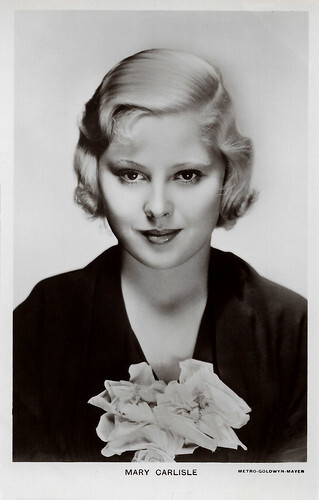
British postcard in the Picturegoer Series, London, no. 743. Photo: Metro-Goldwyn-Mayer.
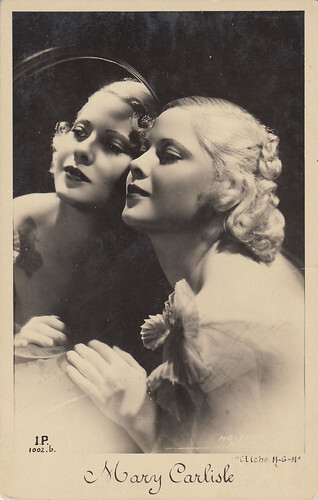
Postcard by I.P., no. 1002b. Photo: MGM. Collection: Marlene Pilaete.
Angelic looks
Mary Carlisle was born Gwendolyn Witter in 1914 in Boston, Massachusetts. Her parents were Arthur William and Leona Ella (Wotton) Witter. Born into a religious family, she was educated in a convent in Back Bay, Boston.
Sometime after her father's death, when she was 4,. Her mother married industrialist Henry J. Kaiser and the family relocated to Los Angeles. Mary's uncle, Robert Carlisle, a film editor and producer, allowed her to appear as an extra in the Jackie Coogan silent film Long Live the King (Victor Schertzinger, 1923).
The story goes that studio executive Carl Laemmle Jr. discovered Carlisle at the age of 14 while she was eating lunch with her mother at the Universal Studios canteen. Laemmle praised her for her angelic looks and offered her a screen test. Though she passed the test and started doing extra work at Universal, she was stopped by a welfare officer who noticed that she was underage and had to finish school first.
After completing her education, she headed to MGM. After a one-day basic tap-dancing lesson, she won a brief part alongside future star Ann Dvorak in a film. In 1930, Carlisle signed a one-year contract with MGM and had small parts in such films as Madam Satan (Cecil B. DeMille, 1930) and Passion Flower (William C. deMille, 1930).
She also had a bit role in Grand Hotel (Edmund Goulding, 1932) as a bride named Mrs. Hoffman. Alongside Gloria Stuart and Ginger Rogers , she was one of the 15 WAMPAS Baby Stars in 1932.
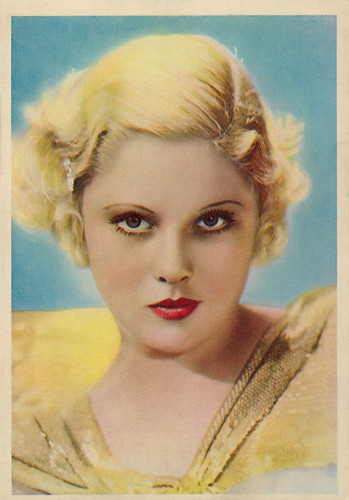
British postcard by De Reszke Cigarettes, no. 18. Caption: Born in 1914, Mary Carlisle entered films at the age of fifteen as the result of a try-out of a drama. She and Ann Dvorak were chosen out of 600 applicants. Her first role was with Jackie Coogan in If I Were King, and after playing leads in short subjects appeared in Grand Hotel and other films, and soon started making a name for herself in featured roles.
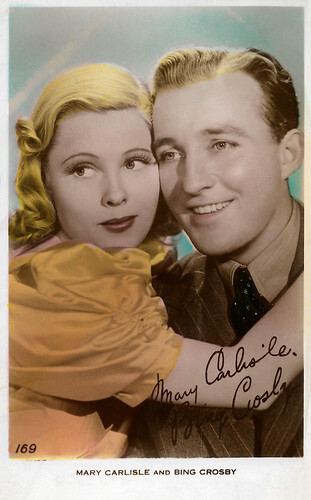
British postcard by Art Photo, no. 169. Mary Carlisle and Bing Crosby in Doctor Rhythm (Frank Tuttle, 1938).
The standard prototype of the porcelain-pretty collegiate
Mary Carlisle's major acting break came when MGM "loaned" her out to Paramount to star in the musical comedy College Humor (Wesley Ruggles, 1933) alongside Bing Crosby . The performance was well regarded by critics and catapulted Carlisle to leading actress status.
She made two more films for Paramount with Crosby, Double or Nothing (Theodore Reed, 1937) and Doctor Rhythm (Frank Tuttle, 1938). Gary Brumburgh at IMDb : "She was the standard prototype of the porcelain-pretty collegiate and starry-eyed romantic interest in a host of Depression-era films. (...) Disappointed with the momentum of her career and her inability to extricate herself from the picture-pretty, paragon-of-virtue stereotype, Mary travelled and lived in London for a time in the late '30s."
Mary continued working for different studios, mainly in B-movies as a leading lady. One of Carlisle's few appearances in an A-movie was in Dance, Girl, Dance (Dorothy Arzner, 1940), opposite Lucille Ball and Maureen O'Hara . She acted in over 60 films in a career that spanned about a dozen years.
She retired after co-starring as the doctor's wife in the Horror film Dead Men Walk (Sam Newfield, 1943) with George Zucco. In 1942, Carlisle married British-born actor James Edward Blakeley, who later became an executive producer at 20th Century Fox. The couple had one son, James, and two grandchildren during their nearly 65-year marriage.
In later life, Carlisle was the manager of the Elizabeth Arden Salon in Beverly Hills, California. Her husband passed away in 2007. Carlisle died in 2018, at the Motion Picture & Television Fund, a retirement community for actors in Woodland Hills, Los Angeles. No cause of death was reported. She was believed to be 104, but never personally confirmed her age or birth date during her life. She is buried in Westwood Memorial Park in Los Angeles, California. In 1960, Carlisle received a star on the Hollywood Walk of Fame, at 6679 Hollywood Boulevard.
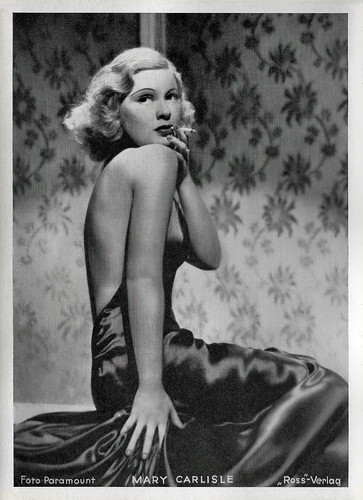
Big German card by Ross Verlag. Photo: Paramount.
Sources: (IMDb), Find A Grave, Wikipedia and .

British postcard in the Picturegoer Series, London, no. 743. Photo: Metro-Goldwyn-Mayer.

Postcard by I.P., no. 1002b. Photo: MGM. Collection: Marlene Pilaete.
Angelic looks
Mary Carlisle was born Gwendolyn Witter in 1914 in Boston, Massachusetts. Her parents were Arthur William and Leona Ella (Wotton) Witter. Born into a religious family, she was educated in a convent in Back Bay, Boston.
Sometime after her father's death, when she was 4,. Her mother married industrialist Henry J. Kaiser and the family relocated to Los Angeles. Mary's uncle, Robert Carlisle, a film editor and producer, allowed her to appear as an extra in the Jackie Coogan silent film Long Live the King (Victor Schertzinger, 1923).
The story goes that studio executive Carl Laemmle Jr. discovered Carlisle at the age of 14 while she was eating lunch with her mother at the Universal Studios canteen. Laemmle praised her for her angelic looks and offered her a screen test. Though she passed the test and started doing extra work at Universal, she was stopped by a welfare officer who noticed that she was underage and had to finish school first.
After completing her education, she headed to MGM. After a one-day basic tap-dancing lesson, she won a brief part alongside future star Ann Dvorak in a film. In 1930, Carlisle signed a one-year contract with MGM and had small parts in such films as Madam Satan (Cecil B. DeMille, 1930) and Passion Flower (William C. deMille, 1930).
She also had a bit role in Grand Hotel (Edmund Goulding, 1932) as a bride named Mrs. Hoffman. Alongside Gloria Stuart and Ginger Rogers , she was one of the 15 WAMPAS Baby Stars in 1932.

British postcard by De Reszke Cigarettes, no. 18. Caption: Born in 1914, Mary Carlisle entered films at the age of fifteen as the result of a try-out of a drama. She and Ann Dvorak were chosen out of 600 applicants. Her first role was with Jackie Coogan in If I Were King, and after playing leads in short subjects appeared in Grand Hotel and other films, and soon started making a name for herself in featured roles.

British postcard by Art Photo, no. 169. Mary Carlisle and Bing Crosby in Doctor Rhythm (Frank Tuttle, 1938).
The standard prototype of the porcelain-pretty collegiate
Mary Carlisle's major acting break came when MGM "loaned" her out to Paramount to star in the musical comedy College Humor (Wesley Ruggles, 1933) alongside Bing Crosby . The performance was well regarded by critics and catapulted Carlisle to leading actress status.
She made two more films for Paramount with Crosby, Double or Nothing (Theodore Reed, 1937) and Doctor Rhythm (Frank Tuttle, 1938). Gary Brumburgh at IMDb : "She was the standard prototype of the porcelain-pretty collegiate and starry-eyed romantic interest in a host of Depression-era films. (...) Disappointed with the momentum of her career and her inability to extricate herself from the picture-pretty, paragon-of-virtue stereotype, Mary travelled and lived in London for a time in the late '30s."
Mary continued working for different studios, mainly in B-movies as a leading lady. One of Carlisle's few appearances in an A-movie was in Dance, Girl, Dance (Dorothy Arzner, 1940), opposite Lucille Ball and Maureen O'Hara . She acted in over 60 films in a career that spanned about a dozen years.
She retired after co-starring as the doctor's wife in the Horror film Dead Men Walk (Sam Newfield, 1943) with George Zucco. In 1942, Carlisle married British-born actor James Edward Blakeley, who later became an executive producer at 20th Century Fox. The couple had one son, James, and two grandchildren during their nearly 65-year marriage.
In later life, Carlisle was the manager of the Elizabeth Arden Salon in Beverly Hills, California. Her husband passed away in 2007. Carlisle died in 2018, at the Motion Picture & Television Fund, a retirement community for actors in Woodland Hills, Los Angeles. No cause of death was reported. She was believed to be 104, but never personally confirmed her age or birth date during her life. She is buried in Westwood Memorial Park in Los Angeles, California. In 1960, Carlisle received a star on the Hollywood Walk of Fame, at 6679 Hollywood Boulevard.

Big German card by Ross Verlag. Photo: Paramount.
Sources: (IMDb), Find A Grave, Wikipedia and .
Published on May 25, 2024 22:00
May 24, 2024
Mitzi Gaynor
Bright-eyed Mitzi Gaynor (1931) is an American actress, singer, and dancer. She was a leading lady in light musicals, including There's No Business Like Show Business (1954), which featured Irving Berlin's music and starred Ethel Merman, and South Pacific (1958), based on the musical by Rodgers and Hammerstein.
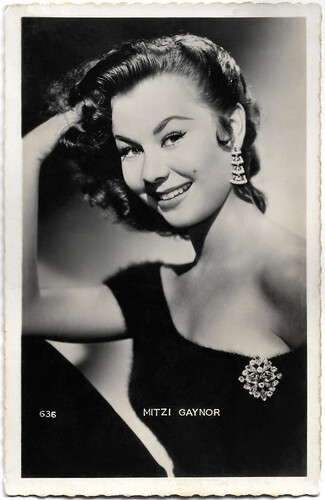
French postcard by Editions P.I., Paris, no. 636.
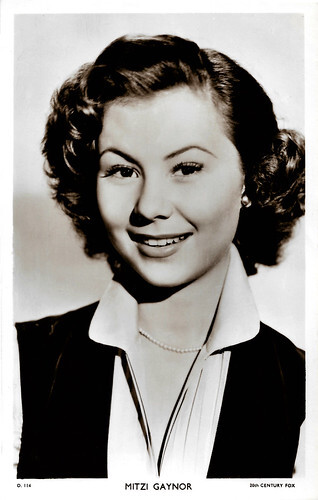
British postcard in the Picturegoer Series, London, no. D. 114. Photo: 20th Century Fox.
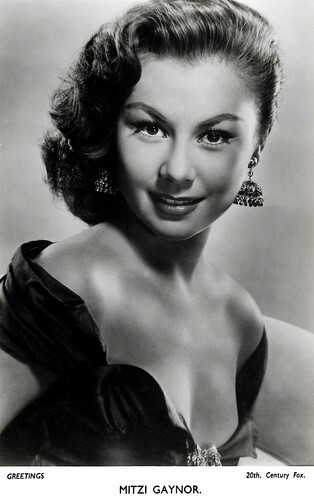
British postcard in the Greetings series. Photo: 20th Century Fox.
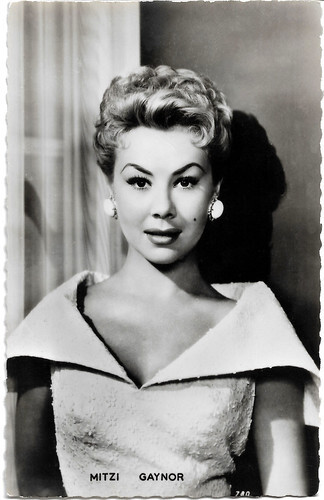
French postcard by Editions P.I., Paris, no. 780. Photo: Paramount Pictures, 1956.
Starting her career as a chorus dancer at 12
Mitzi Gaynor was born as Francesca Marlene de Czanyi von Gerber in 1931, in Chicago, Illinois. She was the daughter of Pauline, a dancer, and Henry von Gerber, a violinist, cellist, and music director. After her father remarried, she became step-sister to anti-war activist Donald W. Duncan. Her family first moved to Elgin, Illinois, then to Detroit, and later when she was eleven, to Hollywood.
She trained as a ballerina as a child and began her career as a chorus dancer. At 12, she joined the dancing chorus of the Los Angeles Civic Light Opera. She lied about her address so she could attend Hollywood High School.
In 1950, she signed a seven-year contract with Twentieth Century Fox where she sang, acted, and danced in several film musicals. A Fox Studio executive thought that Mitzi Gerber sounded like the name of a delicatessen, and they came up with a name that used the same initials. Gaynor made her film debut in a musical, My Blue Heaven (Henry Koster, 1950) supporting Betty Grable and Dan Dailey.
She followed it with a college drama Take Care of My Little Girl (Jean Negulesco, 1951), where she played the roommate of Jeanne Crain . Fox then gave Gaynor a star part, in the musical biopic Golden Girl (Lloyd Bacon, 1951). It was a mild success at the box office. Gaynor was one of several stars in the anthology comedy We're Not Married! (Edmund Goulding, 1952) with Ginger Rogers and Marilyn Monroe , and she was top-billed in the musical, Bloodhounds of Broadway (Harmon Jones, 1952).
Fox put her in another biopic, The I Don't Care Girl (Lloyd Bacon, 1952), where she played Ziegfeld star Eva Tanguay. Gaynor starred in Down Among the Sheltering Palms (Edmund Goulding, 1953), playing a South Sea island girl. She was the female lead in a Western, Three Young Texans (Henry Levin, 1954) with Jeffrey Hunter . Gaynor's most popular film in her time at Fox was There's No Business Like Show Business (Walter Lang, 1954), where she was billed after Ethel Merman, Dan Dailey, Marilyn Monroe , Donald O'Connor and Johnnie Ray.
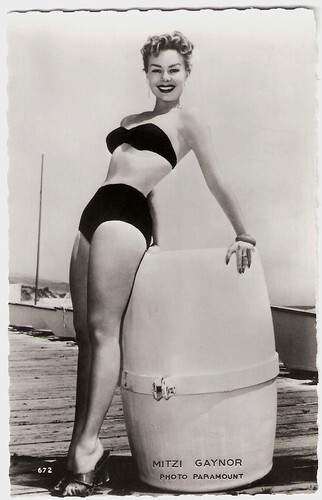
French postcard by Editions P.I., Paris, no. 672, offered by Les Carbones Korès Carboplane. Photo: Paramount.
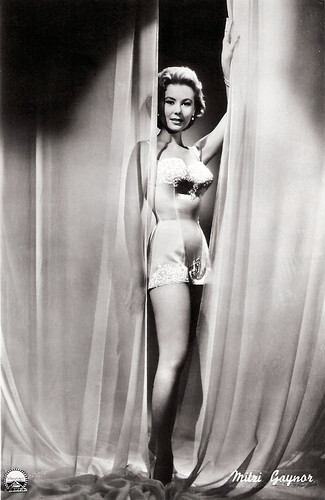
Belgian postcard by Bromophoto, Bruxelles (Brussels). Photo: Paramount.
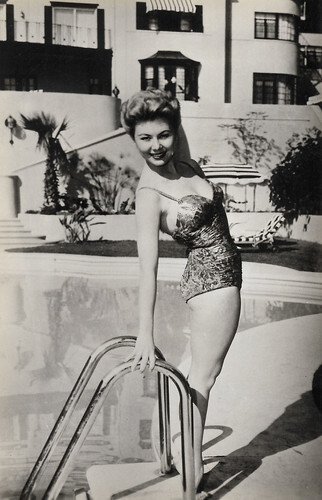
Spanish postcard by Ediciones Raker, Barcelona, no. 23. Photo: M.G.M., 1959.
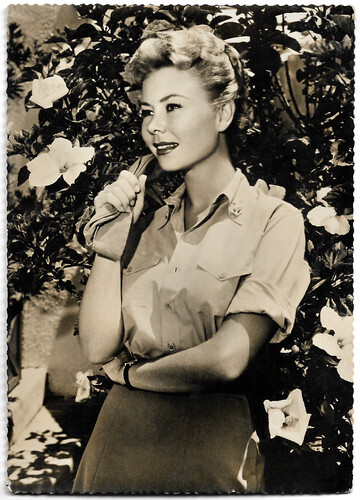
Yugoslavian postcard by 3K, no. 2915.
A major draw on the nightclub and summer musical circuit
In 1954, Mitzi Gaynor married Jack Bean, a talent agent and public relations executive for MCA, in San Francisco, California. She had just been released from Twentieth Century-Fox (before the start of There's No Business Like Show Business) with four years left on her contract and decided with the time off to get married. The union was childless.
After their wedding, Bean quit MCA, started his own real estate business and managed Gaynor's career. Bean wisely perceived that his new bride was a far more effective performer on a live stage than a film set. In 1956, Gaynor appeared in the Paramount remake of Anything Goes (Robert Lewis, 1956), co-starring Bing Crosby , Donald O'Connor , and Zizi Jeanmaire , loosely based on the musical by Cole Porter, P.G. Wodehouse and Guy Bolton.
Paramount cast her in another remake, The Birds and the Bees (Norman Taurog, 1956) with David Niven , playing the role originated by Barbara Stanwyck in The Lady Eve (Preston Sturges, 1941). Her third film for Paramount was The Joker Is Wild (Charles Vidor, 1957), a biopic of famous comedian Joe E. Lewis ( Frank Sinatra ) in which Gaynor played the female lead. In 1957, Gaynor appeared in MGM's Les Girls (George Cukor, 1957), with Gene Kelly and Kay Kendall .
Her biggest international fame came from the plum role of Nellie Forbush in the film version of Rodgers and Hammerstein's South Pacific (Joshua Logan, 1958), starring Rossano Brazzi . She was nominated for a Best Actress Golden Globe Award for her performance. Gaynor followed this with a comedy at MGM, Happy Anniversary (David Miller, 1959) opposite David Niven , and the British musical comedy thriller Surprise Package (Stanley Donen, 1960), with Yul Brynner and Noël Coward. Her last film role was For Love or Money (Michael Gordon, 1963), starring Kirk Douglas .
Mitzi Gaynor's film career was over, but happily, she continued to be a major draw on the nightclub and summer musical circuit. She often performed songs at Academy Awards ceremonies. At the 1967 Oscar telecast, she sang the theme from the film Georgy Girl (Silvio Narizzano, 1966) and stopped the show. The Academy had difficulty getting the audience to sit down and stop applauding. Gaynor later added the number to her concert repertoire. Throughout the 1960s and 1970s, she starred in nine acclaimed television specials that garnered 16 Emmy nominations. During the 1990s, Gaynor also became a featured columnist for the influential magazine The Hollywood Reporter. Her husband Jack Bean died in 2006.
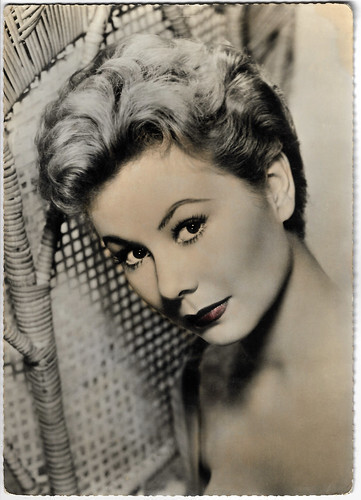
Yugoslavian postcard by 3K, no. 2944.
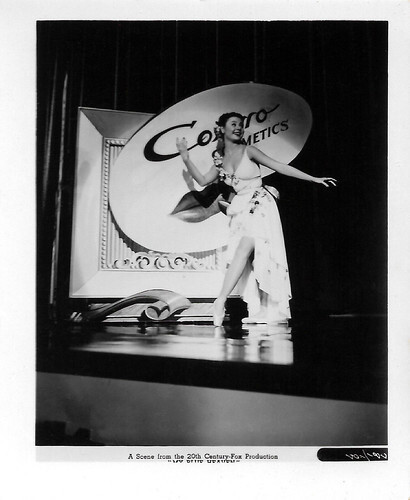
Vintage photo by 20th Century Fox. Mitzi Gaynor in My Blue Heaven (Henry Koster, 1950).
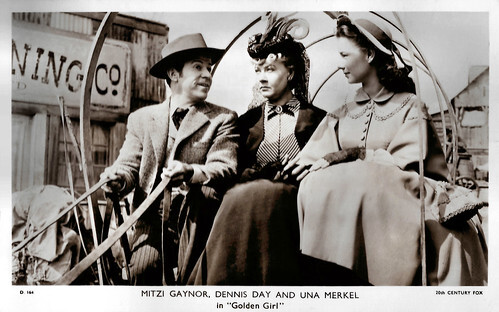
British postcard in the Picturegoer Series, London, no. D 164. Photo: Metro-Goldwyn-Mayer (MGM). Mitzi Gaynor (right), Dennis Day and Una Merkel in Golden Girl (Lloyd Bacon, 1951).
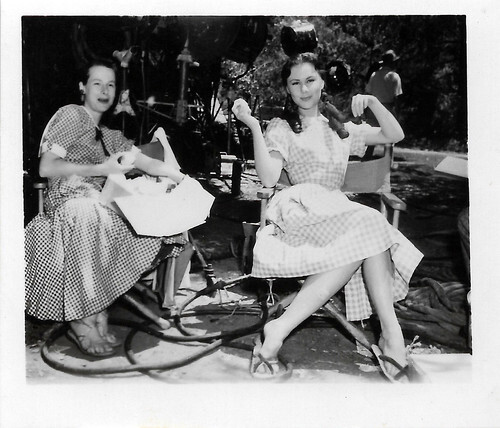
Vintage set photo.
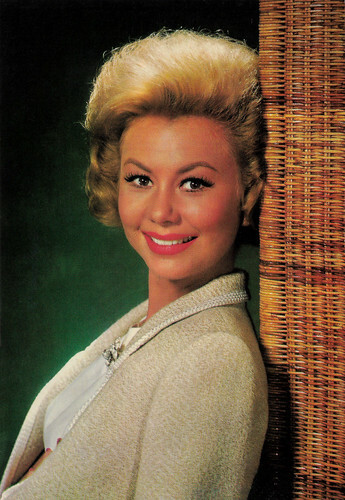
Spanish postcard by Postal Oscarcolor, S.L., no. 8.
Sources: AllMovie, Wikipedia and .

French postcard by Editions P.I., Paris, no. 636.

British postcard in the Picturegoer Series, London, no. D. 114. Photo: 20th Century Fox.

British postcard in the Greetings series. Photo: 20th Century Fox.

French postcard by Editions P.I., Paris, no. 780. Photo: Paramount Pictures, 1956.
Starting her career as a chorus dancer at 12
Mitzi Gaynor was born as Francesca Marlene de Czanyi von Gerber in 1931, in Chicago, Illinois. She was the daughter of Pauline, a dancer, and Henry von Gerber, a violinist, cellist, and music director. After her father remarried, she became step-sister to anti-war activist Donald W. Duncan. Her family first moved to Elgin, Illinois, then to Detroit, and later when she was eleven, to Hollywood.
She trained as a ballerina as a child and began her career as a chorus dancer. At 12, she joined the dancing chorus of the Los Angeles Civic Light Opera. She lied about her address so she could attend Hollywood High School.
In 1950, she signed a seven-year contract with Twentieth Century Fox where she sang, acted, and danced in several film musicals. A Fox Studio executive thought that Mitzi Gerber sounded like the name of a delicatessen, and they came up with a name that used the same initials. Gaynor made her film debut in a musical, My Blue Heaven (Henry Koster, 1950) supporting Betty Grable and Dan Dailey.
She followed it with a college drama Take Care of My Little Girl (Jean Negulesco, 1951), where she played the roommate of Jeanne Crain . Fox then gave Gaynor a star part, in the musical biopic Golden Girl (Lloyd Bacon, 1951). It was a mild success at the box office. Gaynor was one of several stars in the anthology comedy We're Not Married! (Edmund Goulding, 1952) with Ginger Rogers and Marilyn Monroe , and she was top-billed in the musical, Bloodhounds of Broadway (Harmon Jones, 1952).
Fox put her in another biopic, The I Don't Care Girl (Lloyd Bacon, 1952), where she played Ziegfeld star Eva Tanguay. Gaynor starred in Down Among the Sheltering Palms (Edmund Goulding, 1953), playing a South Sea island girl. She was the female lead in a Western, Three Young Texans (Henry Levin, 1954) with Jeffrey Hunter . Gaynor's most popular film in her time at Fox was There's No Business Like Show Business (Walter Lang, 1954), where she was billed after Ethel Merman, Dan Dailey, Marilyn Monroe , Donald O'Connor and Johnnie Ray.

French postcard by Editions P.I., Paris, no. 672, offered by Les Carbones Korès Carboplane. Photo: Paramount.

Belgian postcard by Bromophoto, Bruxelles (Brussels). Photo: Paramount.

Spanish postcard by Ediciones Raker, Barcelona, no. 23. Photo: M.G.M., 1959.

Yugoslavian postcard by 3K, no. 2915.
A major draw on the nightclub and summer musical circuit
In 1954, Mitzi Gaynor married Jack Bean, a talent agent and public relations executive for MCA, in San Francisco, California. She had just been released from Twentieth Century-Fox (before the start of There's No Business Like Show Business) with four years left on her contract and decided with the time off to get married. The union was childless.
After their wedding, Bean quit MCA, started his own real estate business and managed Gaynor's career. Bean wisely perceived that his new bride was a far more effective performer on a live stage than a film set. In 1956, Gaynor appeared in the Paramount remake of Anything Goes (Robert Lewis, 1956), co-starring Bing Crosby , Donald O'Connor , and Zizi Jeanmaire , loosely based on the musical by Cole Porter, P.G. Wodehouse and Guy Bolton.
Paramount cast her in another remake, The Birds and the Bees (Norman Taurog, 1956) with David Niven , playing the role originated by Barbara Stanwyck in The Lady Eve (Preston Sturges, 1941). Her third film for Paramount was The Joker Is Wild (Charles Vidor, 1957), a biopic of famous comedian Joe E. Lewis ( Frank Sinatra ) in which Gaynor played the female lead. In 1957, Gaynor appeared in MGM's Les Girls (George Cukor, 1957), with Gene Kelly and Kay Kendall .
Her biggest international fame came from the plum role of Nellie Forbush in the film version of Rodgers and Hammerstein's South Pacific (Joshua Logan, 1958), starring Rossano Brazzi . She was nominated for a Best Actress Golden Globe Award for her performance. Gaynor followed this with a comedy at MGM, Happy Anniversary (David Miller, 1959) opposite David Niven , and the British musical comedy thriller Surprise Package (Stanley Donen, 1960), with Yul Brynner and Noël Coward. Her last film role was For Love or Money (Michael Gordon, 1963), starring Kirk Douglas .
Mitzi Gaynor's film career was over, but happily, she continued to be a major draw on the nightclub and summer musical circuit. She often performed songs at Academy Awards ceremonies. At the 1967 Oscar telecast, she sang the theme from the film Georgy Girl (Silvio Narizzano, 1966) and stopped the show. The Academy had difficulty getting the audience to sit down and stop applauding. Gaynor later added the number to her concert repertoire. Throughout the 1960s and 1970s, she starred in nine acclaimed television specials that garnered 16 Emmy nominations. During the 1990s, Gaynor also became a featured columnist for the influential magazine The Hollywood Reporter. Her husband Jack Bean died in 2006.

Yugoslavian postcard by 3K, no. 2944.

Vintage photo by 20th Century Fox. Mitzi Gaynor in My Blue Heaven (Henry Koster, 1950).

British postcard in the Picturegoer Series, London, no. D 164. Photo: Metro-Goldwyn-Mayer (MGM). Mitzi Gaynor (right), Dennis Day and Una Merkel in Golden Girl (Lloyd Bacon, 1951).

Vintage set photo.

Spanish postcard by Postal Oscarcolor, S.L., no. 8.
Sources: AllMovie, Wikipedia and .
Published on May 24, 2024 22:00
May 23, 2024
Diana Dors
Blonde and curvey bombshell Diana Dors (1931-1984) was called ‘The English Marilyn Monroe’, to her disgust. In her own words: "I was the first home-grown sex symbol, rather like Britain's naughty seaside postcards. When Marilyn Monroe's first film was shown here, The Asphalt Jungle (1950), a columnist actually wrote, 'How much like our Diana Dors she is'."
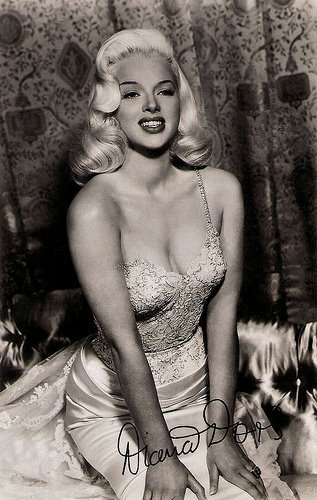
British promo card for Empire News and Sunday Chronicle. The card announced that Diana Dors would write a series of articles for the two-in-one Sunday newspaper about her adventures in Hollywood. In Hollywood she made The Unholy Wife (John Farrow, 1957) and I Married a Woman (Hal Kanter, 1958). The latter was filmed between mid-July and late August 1956 and the card was probably produced in 1956 or 1957.
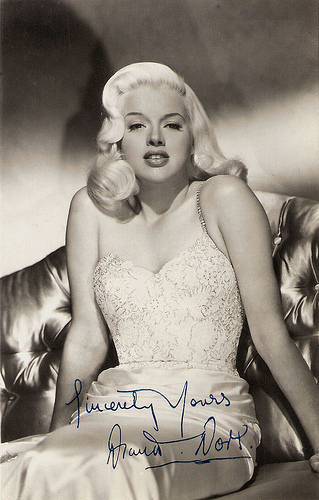
British autograph card. Photo: Cornel Lucas / Rank.
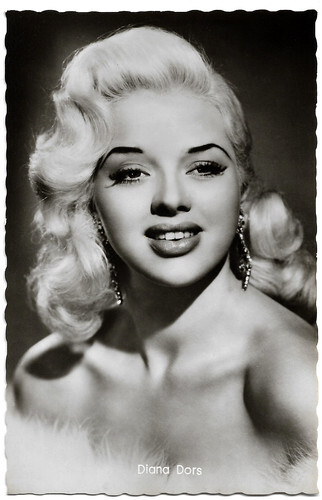
West German postcard by Kolibri Verlag G.m.b.H, Minden-Westf., no. 2275. Photo: Keystone.
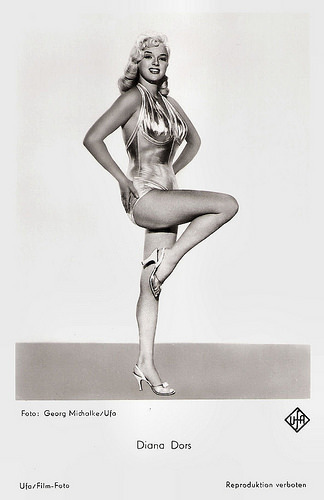
German postcard by Ufa, Berlin-Tempelhof, no. FK 3954. Photo: Georg Michalke / Ufa.
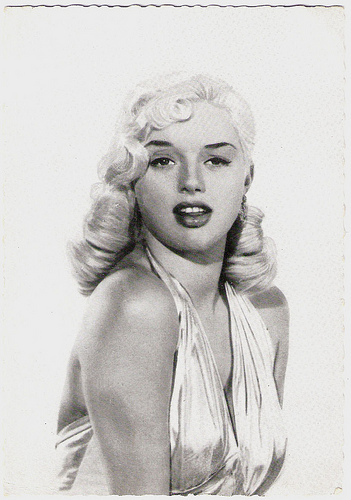
German postcard by Filmbilder-Vertrieb Ernst Freihoff, Essen, no. 245. Retail prive: 10 Pfg. Photo: Georg Michalke.
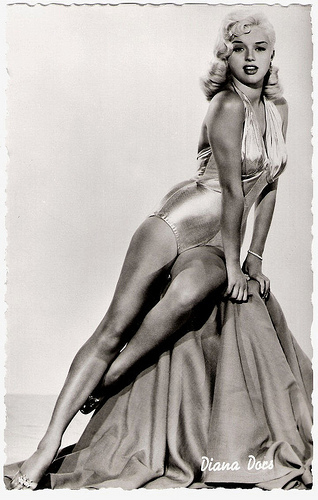
Austrian postcard by Bild- und Ton-Postkartenverlag P. Weizmann, Wien, no. 570. Photo: Georg Michalke.
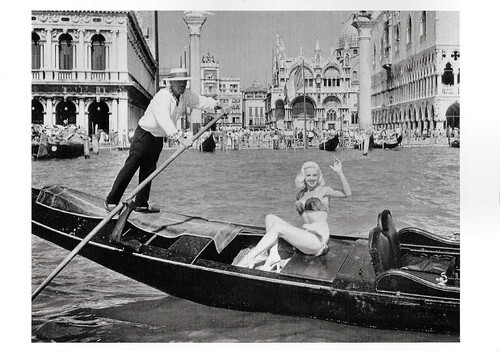
British postcard by National Museum of Photography Film and Television, no. NMP 18. Photo: Cornel Lucas, 1954.
The Siren of Swindon
Diana Dors was born Diana Mary Fluck in Swindon, England, in 1931. Her father, Peter Fluck, was a railroad employee. Her mother, Mary Fluck, had almost died from the traumatic birth of her daughter. Because of this trauma, she lavished on Diana everything she herself had dreamed of: clothes, dance lessons, visits to the cinema. The actresses on the screen caught Diana's attention and she later told that she wanted to be an actress from the age of three.
Physically, Diana grew up fast and she looked and acted much older than what she was. 'The Siren of Swindon' began her career on stage while she was only 13. The youngest of her class, she trained at the London Academy of Music and Dramatic Arts (LAMDA) in London.
At the age of 15, she appeared in her first film, The Shop at Sly Corner (George King, 1947) starring Oskar Homolka . The J. Arthur Rank Organisation offered her a contract and she played several ‘sexy girl in background’ roles in their films. The best of these parts was Charlotte in Oliver Twist (David Lean, 1948) starring Alec Guinness .
She made several more films in the late 1940s, including substantial roles in the comedy Here Come The Huggetts (Ken Annakin, 1948), and the 'bad girl' opposite Honor Blackman 's more virtuous roles in the cycling comedy A Boy, a Girl and a Bike (Ralph Smart, 1949) and Diamond City (David MacDonald, 1949), a lively British 'Western' set in South Africa's diamond fields.
Her appeal stemmed from a combination of glamour and humour, coupled with a lack of vanity. A good example of her early appeal comes in Lady Godiva Rides Again (Frank Launder, 1951) with Dennis Price . It was a light hearted romp that made fun of the beauty queen business. The American Board of Film Censors had banned the film because Diana was showing her navel. However she's friendly and surprisingly non-threatening in the film, more interested in having fun than in winning. Both critics and the public loved her as a sexy siren.
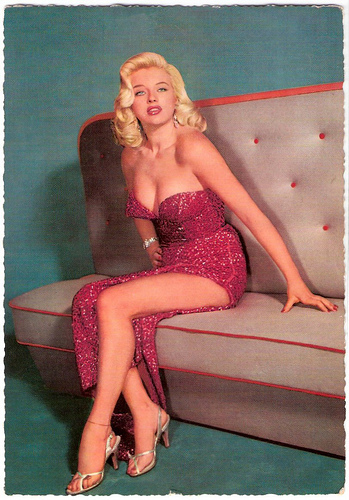
German card, printed by Krüger, no. 902/80. Photo: Ufa.
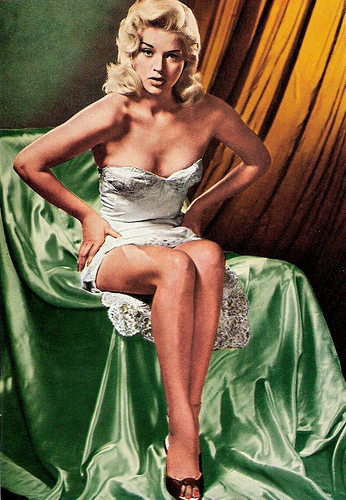
German postcard by Terra-Colour, no. PU 4.
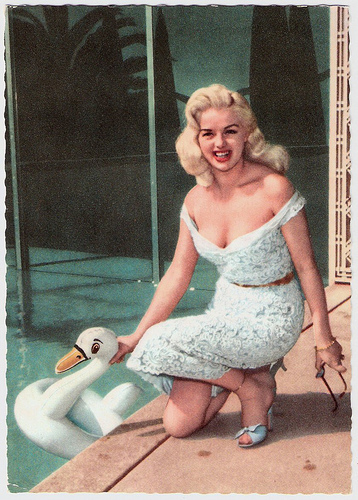
German postcard by Ufa (Universum-Film Aktiengesellschaft), Berlin Tempelhof, no. CK-86. Retail price: 30 Pfg. Photo: Ufa.
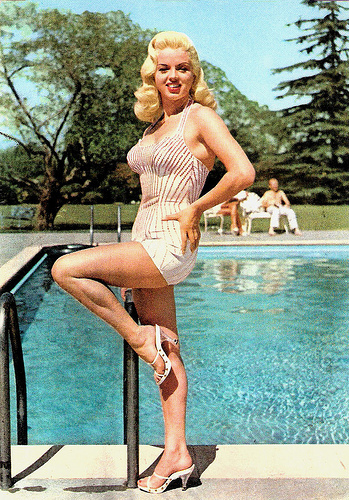
Italian postcard by Rotalcolor, no. 18.
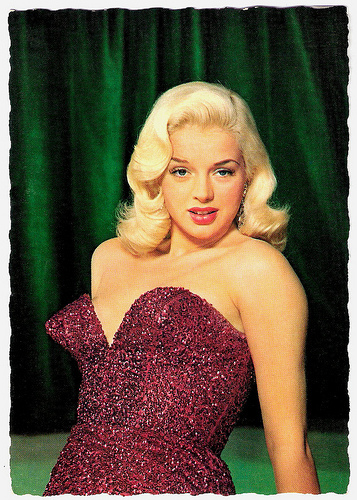
French postcard by E.D.U.G., no. 53.
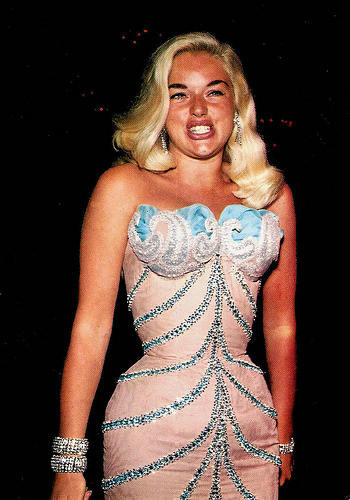
Spanish postcard by Oscarcolor, no. 331.
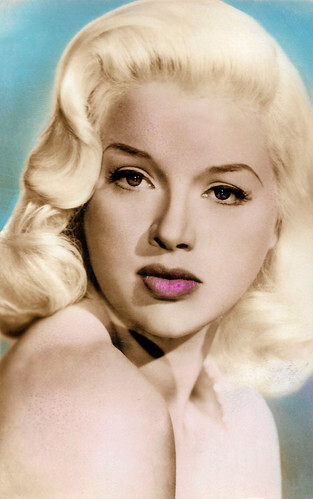
Yugoslavian postcard by Izrada "Nas glas", Smederevo, no. 131.
Public brawl
Diana Dors was one of the very first celebrities to actually court the British press. Her first husband and manager Dennis Hamilton believed any publicity either good or bad could only benefit the ambitious starlet. One stunt was to set up the company Diana Dors Ltd and another was the announcement of Diana as the youngest Rolls Royce owner at the age of 20 (however, she could not drive).
Dors got a 'decent' role in the 'women in prison' drama The Weak and the Wicked (J. Lee Thompson, 1954) opposite Glynis Johns and people started to believe she could act as well as look decorative. She confirmed her talent with a good role in the fantasy A Kid for Two Farthings (Carol Reed, 1955) with Celia Johnson , and her part as a murderess in Yield to the Night (J. Lee Thompson, 1956), loosely based on the true life story of Ruth Ellis, the last woman executed in Britain for murder.
Casting off her sex symbol image, Diana portrayed Mary Hilton whose story is told entirely in flashbacks, as she awaits her final sentencing or possible reprieve, and attempts to tie up the loose ends in her life involving her mother, brother, and husband. Michael Brooke at BFI Screenonline : "Eyebrows were raised at Dors being offered such a challenging dramatic role, given that her blonde bombshell image at the time was almost exclusively associated with comedy, but she rose to the occasion, managing to evoke considerable sympathy for her condemned but essentially unsympathetic character."
Dors was snapped up by Hollywood, but she was put in two unsuitable vehicles, the crime thriller The Unholy Wife (John Farrow, 1957) with Rod Steiger, and the comedy I Married a Woman (Hal Kanter, 1958).
A very public brawl between her and her husband, Dennis Hamilton, finished her Hollywood career. At a pool party full of Hollywood A-list celebrities, Diana was pushed fully clothed into her swimming pool. Hamilton then proceeded to punch the photographer thought to have pushed her, into unconsciousness. The celebrities fled and the headlines the following day were 'Ms Dors go home and take Mr Dors with you!'. Her three movie deal with RKO ended after they cancelled the contract on a moral clause in the contract.
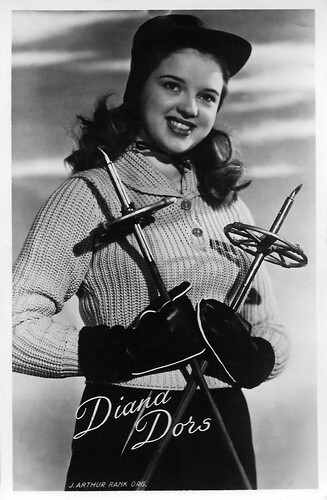
Dutch postcard by Foto-Archief Film en Toneel, no. A x 281. Photo: J. Arthur Rank Org. Sent by mail in 1951.
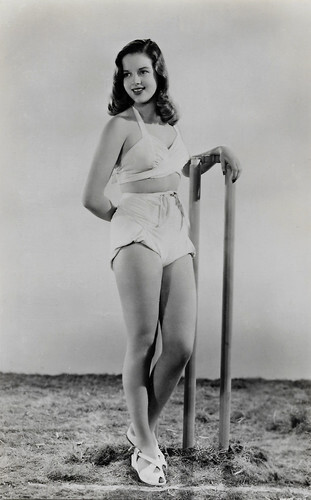
British Best wishes postcard. Photo: J. Arthur Rank Organisation.
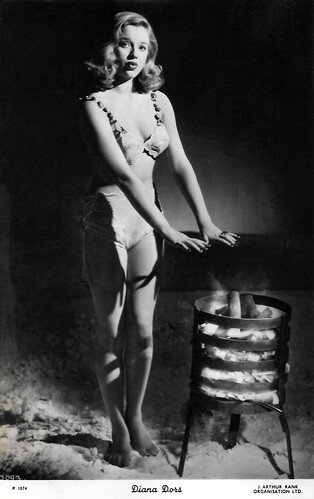
British postcard in 'The People' Series by Show Parade Picture Service, London, no. P. 1074. Photo: J. Arthur Rank Organisation.
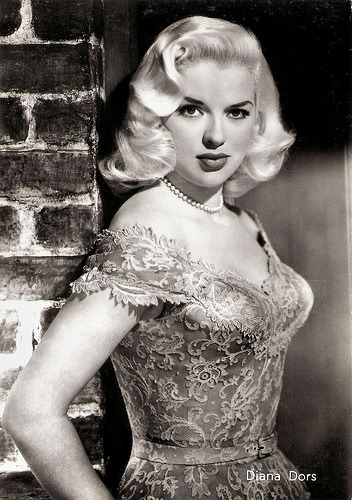
Italian postcard by Bromostampa, Milano, no. 10.
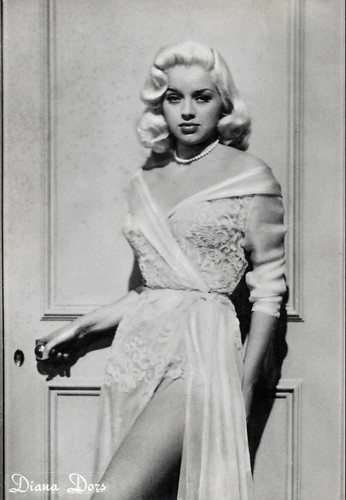
Italian postcard by Rotalfoto, Milano, no. 536. Photo: Rank.
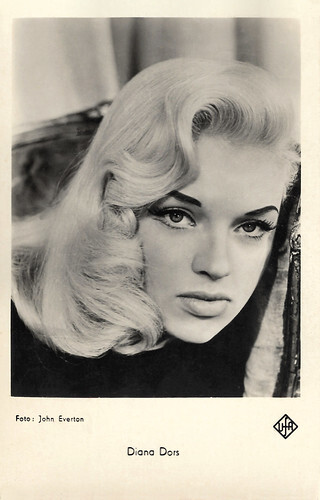
French postcard by Editions P.I., Paris, French licence holder for Ufa, no. FK 11A. The postcard was offered by Les Carbones Korès "Carboplane". Photo: John Everton / Ufa.
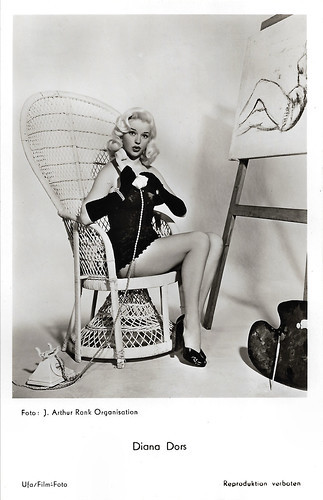
German postcard by Ufa, Berlin-Tempelhof, no. FK 2061. Photo: J. Arthur Rank Organisation.
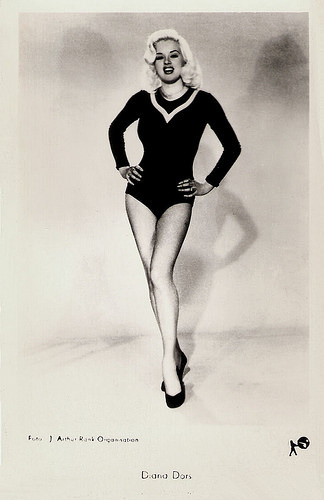
French postcard by Editions P.I., Paris, no. FK 3860. Photo: J. Arthur Rank Organisation.
Blowsy
Diana Dors returned to Britain, but she never quite attained the level of her pre-Hollywood period. During the 1960s Dors never stopped working but her roles got smaller and the films worse. In the campy horror film Beserk! (Jim O'Connolly, 1967), she played a performer in a cheesy carnival who ends up cut in half by a power saw. The film starred 63-year-old Joan Crawford who played the outrageous owner and ringmaster of a travelling circus, who'll stop at nothing to draw bigger audiences...
Dors was often seen on TV both in the US and the UK. She began to pile on the pounds and rapidly went from blowsy to fat. One of her weighty roles was as the ex-wife of Peter Sellers in There's a Girl in My Soup (Roy Boulting, 1970). Her appearance in The Amazing Mr Blunden (Lionel Jeffries, 1972) got a lot of publicity as she played a slatternly Victorian housekeeper in her sixties.
Her major television breakthrough came in 1970, when she starred as a brassy matriarch in Keith Waterhouse and Willis Hall's popular ITV sitcom Queenie's Castle (1970-1972). Despite these successes she continued to accept any role going and took small parts in several British sex comedies, such as Adventures of a Taxi Driver (Stanley Long, 1976).
Diana Dors died in 1984 from a recurrence of ovarian cancer, first diagnosed two years earlier. She was 52 years old. For over thirty years she had lived her life in the headlines, and now she was missed. She had three sons, Mark and Gary Dawson from her second marriage to comedian/TV emcee Richard Dawson, and Jason Lake from her third marriage to actor Alan Lake. Alan Lake committed suicide not long after her death, which generated even more headlines. Her final film, the Nell Dunn adaptation Steaming (Joseph Losey, 1985) starring Vanessa Redgrave , was released a year later.
During her career of nearly four decades, Diana Dors was loved by the British public, and her life, both professional and personal, was followed in a whole new way. Through the media, her life was made accessible to the British public: she was down to earth, made mistakes, had a vulnerability about her and the public followed her ups and downs through the many daily newspapers and magazine articles. Together with 'The Three M's' from Hollywood: Jayne Mansfield , Mamie Van Doren and Marilyn Monroe , DD has left her mark on popular culture by popularising the 1950s blonde bombshell look. David Absalom at British Pictures : "She's been a National Joke and a National Disgrace in her time, but when she died we realised we'd lost a National Treasure."
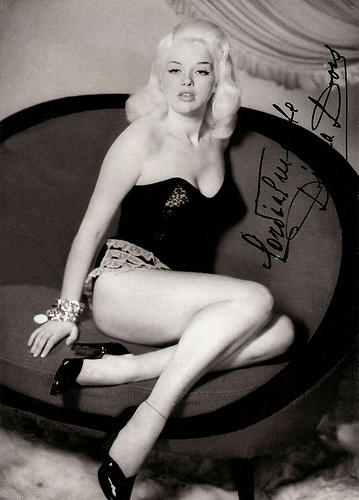
Italian photo distributed at Quindicinale fotografico d'attualita cine-teatrale, Roma.
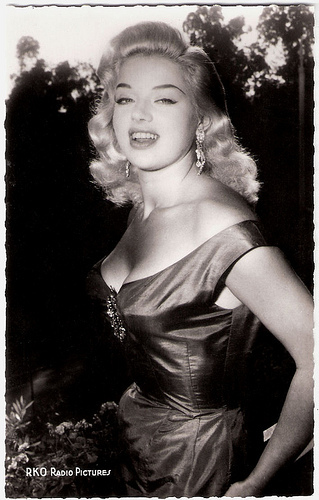
French postcard by Editions du Globe, no. 559. Photo: RKO Radio Pictures.
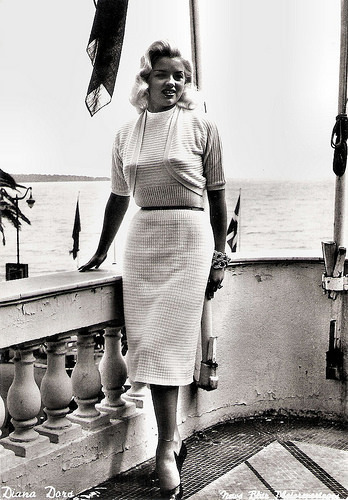
Italian postcard by Bromofoto, Milano, no. 1251.
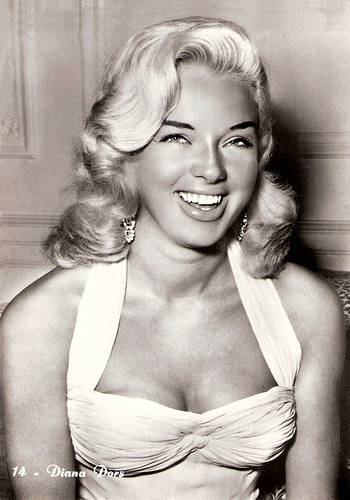
Italian postcard by Turismofoto, no. 14.
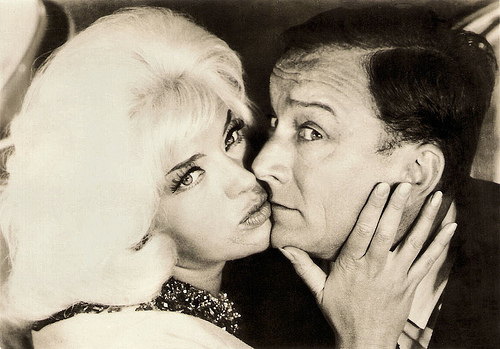
East-German postcard by VEB Progress Film-Vertrieb, Berlin, no. 2629. Photo: publicity still for Allez France!/The Counterfeit Constable (Robert Dhéry, Pierre Tchernia, 1964) with Robert Dhèry.
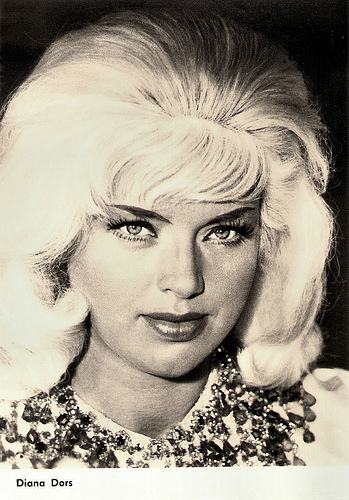
East-German postcard by VEB Progress Filmvertrieb, Berlin, no. 2.631, 1966. Photo: publicity still for Allez France!/The Counterfeit Constable (Robert Dhéry, Pierre Tchernia, 1964).
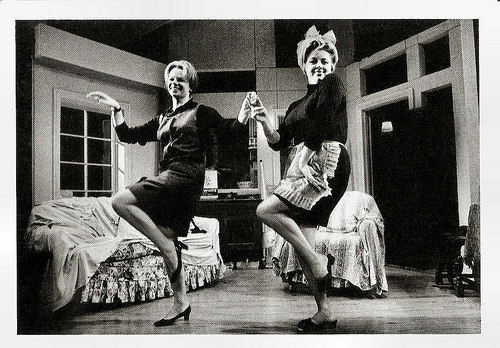
British postcard in the series Talking the Stage: an exhibition of photographs by John Haynes by National Theatre (NT). Photo: John Haynes. Publicity still for Three Months Gone by Donald Howarth (1970) with Jill Bennett.
Trailer for The Unholy Wife (1957). Source: Pinkfairygirl86 (YouTube).
Trailer for Beserk! (1967). Source: SonyPicsHomeEntAU (YouTube).
Sources: Michael Brooke (BFI Screenonline), David Absalom (British Pictures), Hal Erickson (AllMovie), (IMDb), DianaDors, Wikipedia, and .

British promo card for Empire News and Sunday Chronicle. The card announced that Diana Dors would write a series of articles for the two-in-one Sunday newspaper about her adventures in Hollywood. In Hollywood she made The Unholy Wife (John Farrow, 1957) and I Married a Woman (Hal Kanter, 1958). The latter was filmed between mid-July and late August 1956 and the card was probably produced in 1956 or 1957.

British autograph card. Photo: Cornel Lucas / Rank.

West German postcard by Kolibri Verlag G.m.b.H, Minden-Westf., no. 2275. Photo: Keystone.

German postcard by Ufa, Berlin-Tempelhof, no. FK 3954. Photo: Georg Michalke / Ufa.

German postcard by Filmbilder-Vertrieb Ernst Freihoff, Essen, no. 245. Retail prive: 10 Pfg. Photo: Georg Michalke.

Austrian postcard by Bild- und Ton-Postkartenverlag P. Weizmann, Wien, no. 570. Photo: Georg Michalke.

British postcard by National Museum of Photography Film and Television, no. NMP 18. Photo: Cornel Lucas, 1954.
The Siren of Swindon
Diana Dors was born Diana Mary Fluck in Swindon, England, in 1931. Her father, Peter Fluck, was a railroad employee. Her mother, Mary Fluck, had almost died from the traumatic birth of her daughter. Because of this trauma, she lavished on Diana everything she herself had dreamed of: clothes, dance lessons, visits to the cinema. The actresses on the screen caught Diana's attention and she later told that she wanted to be an actress from the age of three.
Physically, Diana grew up fast and she looked and acted much older than what she was. 'The Siren of Swindon' began her career on stage while she was only 13. The youngest of her class, she trained at the London Academy of Music and Dramatic Arts (LAMDA) in London.
At the age of 15, she appeared in her first film, The Shop at Sly Corner (George King, 1947) starring Oskar Homolka . The J. Arthur Rank Organisation offered her a contract and she played several ‘sexy girl in background’ roles in their films. The best of these parts was Charlotte in Oliver Twist (David Lean, 1948) starring Alec Guinness .
She made several more films in the late 1940s, including substantial roles in the comedy Here Come The Huggetts (Ken Annakin, 1948), and the 'bad girl' opposite Honor Blackman 's more virtuous roles in the cycling comedy A Boy, a Girl and a Bike (Ralph Smart, 1949) and Diamond City (David MacDonald, 1949), a lively British 'Western' set in South Africa's diamond fields.
Her appeal stemmed from a combination of glamour and humour, coupled with a lack of vanity. A good example of her early appeal comes in Lady Godiva Rides Again (Frank Launder, 1951) with Dennis Price . It was a light hearted romp that made fun of the beauty queen business. The American Board of Film Censors had banned the film because Diana was showing her navel. However she's friendly and surprisingly non-threatening in the film, more interested in having fun than in winning. Both critics and the public loved her as a sexy siren.

German card, printed by Krüger, no. 902/80. Photo: Ufa.

German postcard by Terra-Colour, no. PU 4.

German postcard by Ufa (Universum-Film Aktiengesellschaft), Berlin Tempelhof, no. CK-86. Retail price: 30 Pfg. Photo: Ufa.

Italian postcard by Rotalcolor, no. 18.

French postcard by E.D.U.G., no. 53.

Spanish postcard by Oscarcolor, no. 331.

Yugoslavian postcard by Izrada "Nas glas", Smederevo, no. 131.
Public brawl
Diana Dors was one of the very first celebrities to actually court the British press. Her first husband and manager Dennis Hamilton believed any publicity either good or bad could only benefit the ambitious starlet. One stunt was to set up the company Diana Dors Ltd and another was the announcement of Diana as the youngest Rolls Royce owner at the age of 20 (however, she could not drive).
Dors got a 'decent' role in the 'women in prison' drama The Weak and the Wicked (J. Lee Thompson, 1954) opposite Glynis Johns and people started to believe she could act as well as look decorative. She confirmed her talent with a good role in the fantasy A Kid for Two Farthings (Carol Reed, 1955) with Celia Johnson , and her part as a murderess in Yield to the Night (J. Lee Thompson, 1956), loosely based on the true life story of Ruth Ellis, the last woman executed in Britain for murder.
Casting off her sex symbol image, Diana portrayed Mary Hilton whose story is told entirely in flashbacks, as she awaits her final sentencing or possible reprieve, and attempts to tie up the loose ends in her life involving her mother, brother, and husband. Michael Brooke at BFI Screenonline : "Eyebrows were raised at Dors being offered such a challenging dramatic role, given that her blonde bombshell image at the time was almost exclusively associated with comedy, but she rose to the occasion, managing to evoke considerable sympathy for her condemned but essentially unsympathetic character."
Dors was snapped up by Hollywood, but she was put in two unsuitable vehicles, the crime thriller The Unholy Wife (John Farrow, 1957) with Rod Steiger, and the comedy I Married a Woman (Hal Kanter, 1958).
A very public brawl between her and her husband, Dennis Hamilton, finished her Hollywood career. At a pool party full of Hollywood A-list celebrities, Diana was pushed fully clothed into her swimming pool. Hamilton then proceeded to punch the photographer thought to have pushed her, into unconsciousness. The celebrities fled and the headlines the following day were 'Ms Dors go home and take Mr Dors with you!'. Her three movie deal with RKO ended after they cancelled the contract on a moral clause in the contract.

Dutch postcard by Foto-Archief Film en Toneel, no. A x 281. Photo: J. Arthur Rank Org. Sent by mail in 1951.

British Best wishes postcard. Photo: J. Arthur Rank Organisation.

British postcard in 'The People' Series by Show Parade Picture Service, London, no. P. 1074. Photo: J. Arthur Rank Organisation.

Italian postcard by Bromostampa, Milano, no. 10.

Italian postcard by Rotalfoto, Milano, no. 536. Photo: Rank.

French postcard by Editions P.I., Paris, French licence holder for Ufa, no. FK 11A. The postcard was offered by Les Carbones Korès "Carboplane". Photo: John Everton / Ufa.

German postcard by Ufa, Berlin-Tempelhof, no. FK 2061. Photo: J. Arthur Rank Organisation.

French postcard by Editions P.I., Paris, no. FK 3860. Photo: J. Arthur Rank Organisation.
Blowsy
Diana Dors returned to Britain, but she never quite attained the level of her pre-Hollywood period. During the 1960s Dors never stopped working but her roles got smaller and the films worse. In the campy horror film Beserk! (Jim O'Connolly, 1967), she played a performer in a cheesy carnival who ends up cut in half by a power saw. The film starred 63-year-old Joan Crawford who played the outrageous owner and ringmaster of a travelling circus, who'll stop at nothing to draw bigger audiences...
Dors was often seen on TV both in the US and the UK. She began to pile on the pounds and rapidly went from blowsy to fat. One of her weighty roles was as the ex-wife of Peter Sellers in There's a Girl in My Soup (Roy Boulting, 1970). Her appearance in The Amazing Mr Blunden (Lionel Jeffries, 1972) got a lot of publicity as she played a slatternly Victorian housekeeper in her sixties.
Her major television breakthrough came in 1970, when she starred as a brassy matriarch in Keith Waterhouse and Willis Hall's popular ITV sitcom Queenie's Castle (1970-1972). Despite these successes she continued to accept any role going and took small parts in several British sex comedies, such as Adventures of a Taxi Driver (Stanley Long, 1976).
Diana Dors died in 1984 from a recurrence of ovarian cancer, first diagnosed two years earlier. She was 52 years old. For over thirty years she had lived her life in the headlines, and now she was missed. She had three sons, Mark and Gary Dawson from her second marriage to comedian/TV emcee Richard Dawson, and Jason Lake from her third marriage to actor Alan Lake. Alan Lake committed suicide not long after her death, which generated even more headlines. Her final film, the Nell Dunn adaptation Steaming (Joseph Losey, 1985) starring Vanessa Redgrave , was released a year later.
During her career of nearly four decades, Diana Dors was loved by the British public, and her life, both professional and personal, was followed in a whole new way. Through the media, her life was made accessible to the British public: she was down to earth, made mistakes, had a vulnerability about her and the public followed her ups and downs through the many daily newspapers and magazine articles. Together with 'The Three M's' from Hollywood: Jayne Mansfield , Mamie Van Doren and Marilyn Monroe , DD has left her mark on popular culture by popularising the 1950s blonde bombshell look. David Absalom at British Pictures : "She's been a National Joke and a National Disgrace in her time, but when she died we realised we'd lost a National Treasure."

Italian photo distributed at Quindicinale fotografico d'attualita cine-teatrale, Roma.

French postcard by Editions du Globe, no. 559. Photo: RKO Radio Pictures.

Italian postcard by Bromofoto, Milano, no. 1251.

Italian postcard by Turismofoto, no. 14.

East-German postcard by VEB Progress Film-Vertrieb, Berlin, no. 2629. Photo: publicity still for Allez France!/The Counterfeit Constable (Robert Dhéry, Pierre Tchernia, 1964) with Robert Dhèry.

East-German postcard by VEB Progress Filmvertrieb, Berlin, no. 2.631, 1966. Photo: publicity still for Allez France!/The Counterfeit Constable (Robert Dhéry, Pierre Tchernia, 1964).

British postcard in the series Talking the Stage: an exhibition of photographs by John Haynes by National Theatre (NT). Photo: John Haynes. Publicity still for Three Months Gone by Donald Howarth (1970) with Jill Bennett.
Trailer for The Unholy Wife (1957). Source: Pinkfairygirl86 (YouTube).
Trailer for Beserk! (1967). Source: SonyPicsHomeEntAU (YouTube).
Sources: Michael Brooke (BFI Screenonline), David Absalom (British Pictures), Hal Erickson (AllMovie), (IMDb), DianaDors, Wikipedia, and .
Published on May 23, 2024 22:00
May 22, 2024
Bleeke Bet (1934)
The tragi-comedy Bleeke Bet/Pale Betty (Richard Oswald, Alex Benno, 1934) was one of the first Dutch sound films. The distributor Monopole Film ordered a series of postcards with pictures by photographer Dick van Maarseveen to promote the film. The film was a success in the Dutch cinemas.
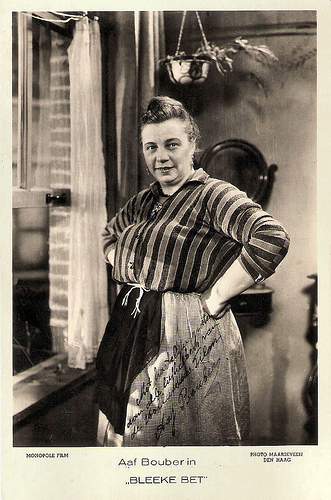
Dutch postcard by M.B. & Z. (M. Bonnist & Zonen, Amsterdam). Photo: Dick van Maarseveen, Den Haag / Monopole Film. Aaf Bouber in Bleeke Bet (Alex Benno, Richard Oswald, 1934). Collection: Geoffrey Donaldson Institute.
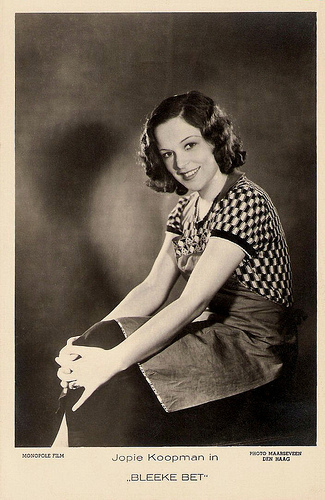
Dutch postcard by Monopole Film, Rotterdam. Photo: Dick van Maarseveen. Jopie Koopman in Bleeke Bet (Alex Benno, Richard Oswald, 1934). Collection: Geoffrey Donaldson Institute.
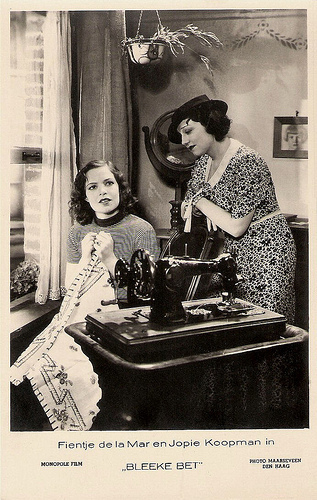
Dutch postcard by Monopole Film, Rotterdam. Photo: Dick van Maarseveen. Fien de la Mar and Jopie Koopman in Bleeke Bet (Alex Benno, Richard Oswald, 1934).
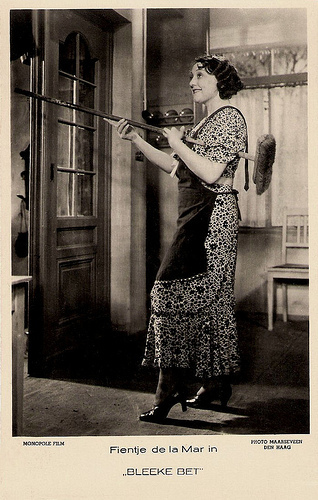
Dutch postcard by M.B. & Z. (M. Bonnist & Zonen, Amsterdam). Photo: Monopole Film / Dick van Maarseveen, Den Haag. Fien(tje) de la Mar in Bleeke Bet (Alex Benno, Richard Oswald, 1934).
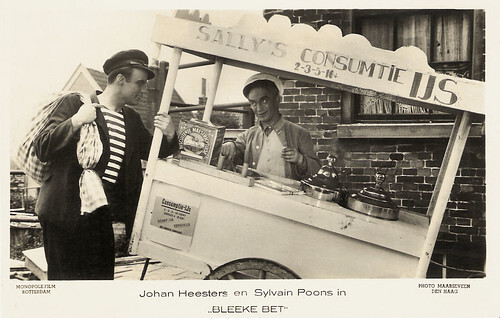
Dutch postcard by Monopole Film, Amsterdam. Photo: Dick van Maarseveen, Den Haag. Sylvain Poons and Johan Heesters in Bleeke Bet (Richard Oswald, Alex Benno, 1934). Collection: Geoffrey Donaldson Institute.
A greengrocer in the Jordaan
The directors of Bleeke Bet/Pale Betty (1934) were Alex Benno, who had already directed several silent Dutch films and the Austrian director, producer, and screenwriter Richard Oswald.
From 1914 on, Oswald made dozens of films in Weimar Germany, including the comedy Der Hauptmann von Köpenick/The Captain from Köpenick (1931) and the horror-comedy Unheimliche Geschichten/Uncanny Stories (1932) starring Paul Wegener . Being Jewish, Oswald was forced to flee Nazi Germany, first for occupied France and later emigrating to the United States.
Alex Benno had also written the screenplay for Bleeke Bet. It was based on a popular stage melodrama, written by Herman Bouber in 1917. Benno and Bouber made a silent version of Bleeke Bet in 1923 with Alida van Gijtenbeek as Bet. After the amazing box office success of the sound film De Jantjes/The Tars (Jaap Speyer, 1933), also based on a play by Bouber, Benno got the green light for a sound version of Bleeke Bet.
In the new sound version, Bouber's wife, Aaf Bouber , played the title role of Bleeke Bet, a greengrocer in the Jordaan, the old neighbourhood in the heart of Amsterdam. Bet wants her daughter Jans ( Jopie Koopman ) to marry the son of a dodgy businessman, but Jans loves sailor Ko (the young Johannes Heesters ).
Bet's attempts to drive them apart come to nothing but when Ko is reported lost at sea, a desperate Jans gives in to her mother's wishes. On the wedding day, Ko turns out to be alive and just in time to take his rightful place at the altar next to Jans. The still on the last postcard of this post shows the happy ending with Fien de la Mar as Ka in the centre.
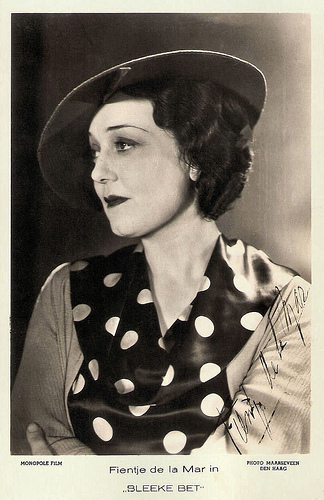
Dutch postcard by M.B. & Z. (M. Bonnist & Zonen, Amsterdam). Photo: Dick van Maarseveen, Den Haag / Monopole Film. Fien(tje) de la Mar in Bleeke Bet (1934, Alex Benno, Richard Oswald). Collection: Geoffrey Donaldson Institute.
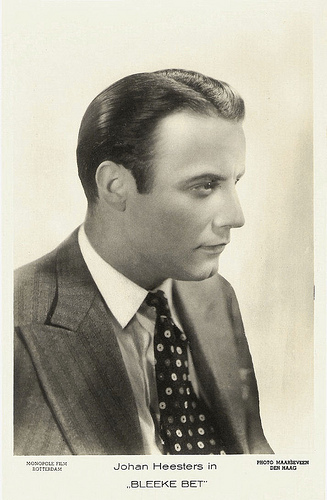
Dutch postcard by M. B. & Z. (M. Bonnist & Zonen, Amsterdam). Photo: Monopole Film, Rotterdam / Maarseveen, Den Haag. Johan(nes) Heesters in Bleeke Bet (1934).
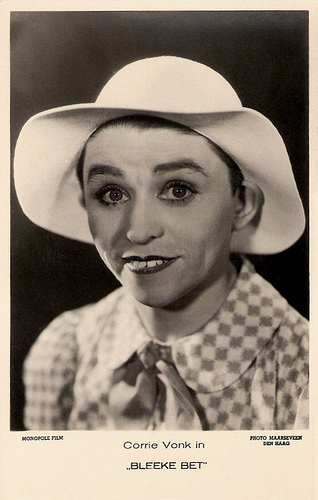
Dutch postcard by M.B. & Z. (M. Bonnist & Zonen, Amsterdam). Photo: Monopole Film / Dick van Maarseveen, Den Haag. Corrie Vonk in Bleeke Bet (Alex Benno, Richard Oswald, 1934).
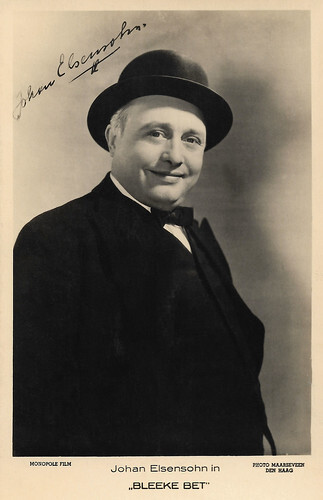
Dutch postcard by M.B. & Z. (M. Bonnist & Zonen, Amsterdam). Photo: Dick van Maarseveen, Den Haag / Monopole Film. Johan Elsensohn in Bleeke Bet (1934). Collection: Geoffrey Donaldson Institute.
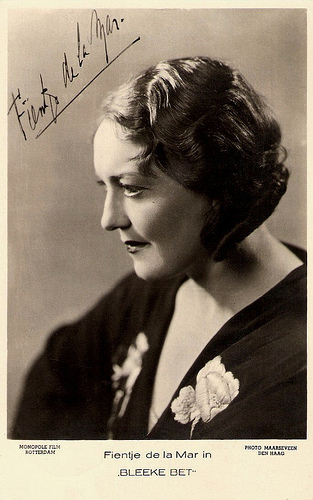
Dutch Postcard by Monopole Film, Rotterdam. Photo: Dick van Maarseveen, Den Haag. Fien de la Mar in Bleeke Bet (1934).
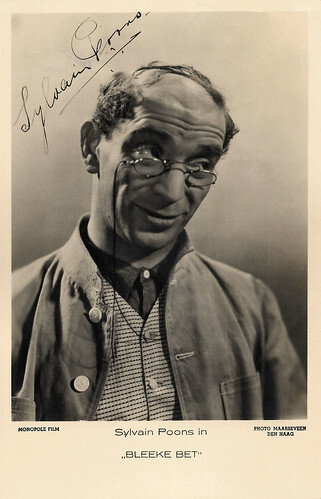
Dutch postcard by Monopole Film, Rotterdam. Photo: Dick van Maarseveen, Den Haag. Sylvain Poons in Bleeke Bet (1934).
Nazi censors
Bleeke Bet was a commercial success and would be re-issued in 1941 and 1961. In 1941 Jewish actors like Sylvain Poons were cut out of the picture by the Nazi censors.
Poons as the ice cream salesman Sally sings an evergreen in the film, 'IJslied' (Ice cream Song). The music was composed by emigrant Hans May and the lyrics were written by the later collaborator, Jacques van Tol.
The film has more wonderful songs, including Fien de la Mar 's torch song 'Ik wil gelukkig zijn' (I want to be happy).
Fien de la Mar , Sylvain Poons and Johan Elsensohn as Bet's husband got positive reviews in the Dutch newspapers for their performances. The voice of Johannes Heesters was also complimented.
However, the film's reviews were mixed, but it did not matter to the producer: the public loved it.
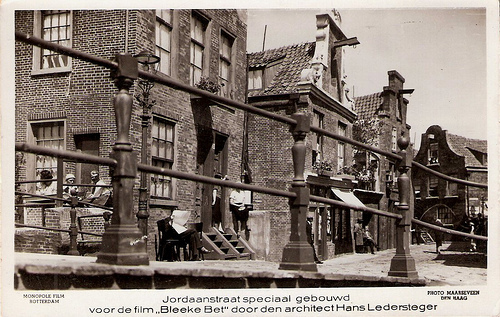
Dutch postcard by Monopole Film, Rotterdam. Photo: Dick van Maarseveen. Still of a set built for Bleeke Bet (Alex Benno, Richard Oswald, 1934), a street in the old neighbourhood De Jordaan in Amsterdam. Set designer was Hans Ledersteger. The set would be used again for several other films.
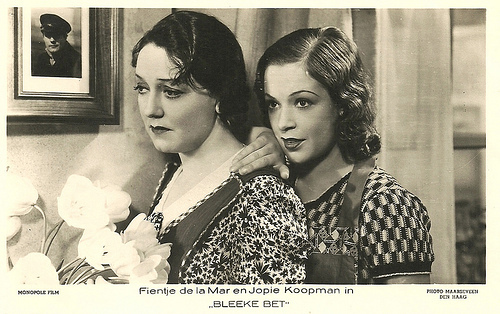
Dutch postcard by Monopole Film. Photo: Maarseveen, Den Haag. Fien(tje) de la Mar and Jopie Koopman in Bleeke Bet (Alex Benno, Richard Oswald, 1934).
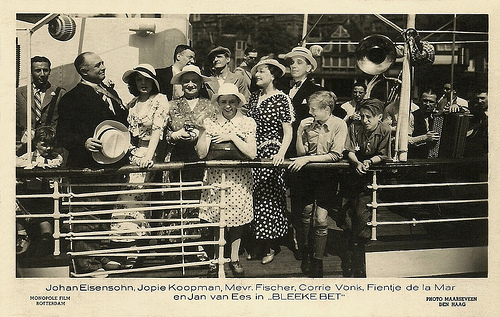
Dutch postcard by Monopole Film, Amsterdam. Photo: Maarseveen, Den Haag. Johan Elsensohn , Jopie Koopman , Clara Vischer-Blaaser, Corry Vonk , Fien de la Mar and Jan van Ees in Bleeke Bet (Richard Oswald, Alex Benno, 1934).
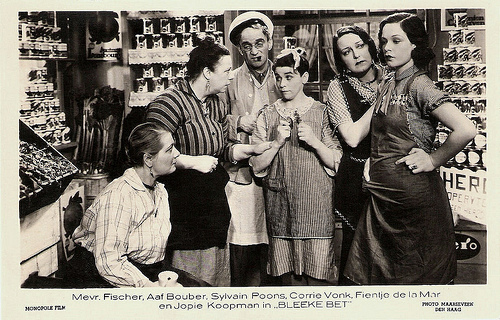
Dutch postcard by Monopole Film, Amsterdam. Photo: Maarseveen, Den Haag. Clara Vischer-Blaaser, Aaf Bouber , Sylvain Poons , Corry Vonk , Fien de la Mar and Jopie Koopman in Bleeke Bet (Richard Oswald, Alex Benno, 1934).
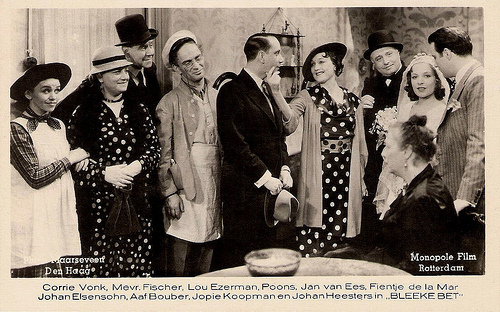
Dutch Postcard by Monopole Film, Rotterdam. Photo: Dick van Maarseveen, Den Haag (The Hague). Publicity still for Bleeke Bet (1934) with the main cast for the happy ending.
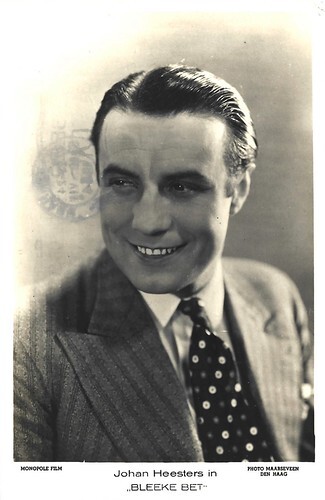
Dutch postcard by Monopole Film, Rotterdam. Photo: Dick van Maarseveen, Den Haag. Johan(nes) Heesters in Bleeke Bet (Richard Oswald, Alex Benno, 1934).
Sources: Wikipedia (Dutch and English) and IMDb.

Dutch postcard by M.B. & Z. (M. Bonnist & Zonen, Amsterdam). Photo: Dick van Maarseveen, Den Haag / Monopole Film. Aaf Bouber in Bleeke Bet (Alex Benno, Richard Oswald, 1934). Collection: Geoffrey Donaldson Institute.

Dutch postcard by Monopole Film, Rotterdam. Photo: Dick van Maarseveen. Jopie Koopman in Bleeke Bet (Alex Benno, Richard Oswald, 1934). Collection: Geoffrey Donaldson Institute.

Dutch postcard by Monopole Film, Rotterdam. Photo: Dick van Maarseveen. Fien de la Mar and Jopie Koopman in Bleeke Bet (Alex Benno, Richard Oswald, 1934).

Dutch postcard by M.B. & Z. (M. Bonnist & Zonen, Amsterdam). Photo: Monopole Film / Dick van Maarseveen, Den Haag. Fien(tje) de la Mar in Bleeke Bet (Alex Benno, Richard Oswald, 1934).

Dutch postcard by Monopole Film, Amsterdam. Photo: Dick van Maarseveen, Den Haag. Sylvain Poons and Johan Heesters in Bleeke Bet (Richard Oswald, Alex Benno, 1934). Collection: Geoffrey Donaldson Institute.
A greengrocer in the Jordaan
The directors of Bleeke Bet/Pale Betty (1934) were Alex Benno, who had already directed several silent Dutch films and the Austrian director, producer, and screenwriter Richard Oswald.
From 1914 on, Oswald made dozens of films in Weimar Germany, including the comedy Der Hauptmann von Köpenick/The Captain from Köpenick (1931) and the horror-comedy Unheimliche Geschichten/Uncanny Stories (1932) starring Paul Wegener . Being Jewish, Oswald was forced to flee Nazi Germany, first for occupied France and later emigrating to the United States.
Alex Benno had also written the screenplay for Bleeke Bet. It was based on a popular stage melodrama, written by Herman Bouber in 1917. Benno and Bouber made a silent version of Bleeke Bet in 1923 with Alida van Gijtenbeek as Bet. After the amazing box office success of the sound film De Jantjes/The Tars (Jaap Speyer, 1933), also based on a play by Bouber, Benno got the green light for a sound version of Bleeke Bet.
In the new sound version, Bouber's wife, Aaf Bouber , played the title role of Bleeke Bet, a greengrocer in the Jordaan, the old neighbourhood in the heart of Amsterdam. Bet wants her daughter Jans ( Jopie Koopman ) to marry the son of a dodgy businessman, but Jans loves sailor Ko (the young Johannes Heesters ).
Bet's attempts to drive them apart come to nothing but when Ko is reported lost at sea, a desperate Jans gives in to her mother's wishes. On the wedding day, Ko turns out to be alive and just in time to take his rightful place at the altar next to Jans. The still on the last postcard of this post shows the happy ending with Fien de la Mar as Ka in the centre.

Dutch postcard by M.B. & Z. (M. Bonnist & Zonen, Amsterdam). Photo: Dick van Maarseveen, Den Haag / Monopole Film. Fien(tje) de la Mar in Bleeke Bet (1934, Alex Benno, Richard Oswald). Collection: Geoffrey Donaldson Institute.

Dutch postcard by M. B. & Z. (M. Bonnist & Zonen, Amsterdam). Photo: Monopole Film, Rotterdam / Maarseveen, Den Haag. Johan(nes) Heesters in Bleeke Bet (1934).

Dutch postcard by M.B. & Z. (M. Bonnist & Zonen, Amsterdam). Photo: Monopole Film / Dick van Maarseveen, Den Haag. Corrie Vonk in Bleeke Bet (Alex Benno, Richard Oswald, 1934).

Dutch postcard by M.B. & Z. (M. Bonnist & Zonen, Amsterdam). Photo: Dick van Maarseveen, Den Haag / Monopole Film. Johan Elsensohn in Bleeke Bet (1934). Collection: Geoffrey Donaldson Institute.

Dutch Postcard by Monopole Film, Rotterdam. Photo: Dick van Maarseveen, Den Haag. Fien de la Mar in Bleeke Bet (1934).

Dutch postcard by Monopole Film, Rotterdam. Photo: Dick van Maarseveen, Den Haag. Sylvain Poons in Bleeke Bet (1934).
Nazi censors
Bleeke Bet was a commercial success and would be re-issued in 1941 and 1961. In 1941 Jewish actors like Sylvain Poons were cut out of the picture by the Nazi censors.
Poons as the ice cream salesman Sally sings an evergreen in the film, 'IJslied' (Ice cream Song). The music was composed by emigrant Hans May and the lyrics were written by the later collaborator, Jacques van Tol.
The film has more wonderful songs, including Fien de la Mar 's torch song 'Ik wil gelukkig zijn' (I want to be happy).
Fien de la Mar , Sylvain Poons and Johan Elsensohn as Bet's husband got positive reviews in the Dutch newspapers for their performances. The voice of Johannes Heesters was also complimented.
However, the film's reviews were mixed, but it did not matter to the producer: the public loved it.

Dutch postcard by Monopole Film, Rotterdam. Photo: Dick van Maarseveen. Still of a set built for Bleeke Bet (Alex Benno, Richard Oswald, 1934), a street in the old neighbourhood De Jordaan in Amsterdam. Set designer was Hans Ledersteger. The set would be used again for several other films.

Dutch postcard by Monopole Film. Photo: Maarseveen, Den Haag. Fien(tje) de la Mar and Jopie Koopman in Bleeke Bet (Alex Benno, Richard Oswald, 1934).

Dutch postcard by Monopole Film, Amsterdam. Photo: Maarseveen, Den Haag. Johan Elsensohn , Jopie Koopman , Clara Vischer-Blaaser, Corry Vonk , Fien de la Mar and Jan van Ees in Bleeke Bet (Richard Oswald, Alex Benno, 1934).

Dutch postcard by Monopole Film, Amsterdam. Photo: Maarseveen, Den Haag. Clara Vischer-Blaaser, Aaf Bouber , Sylvain Poons , Corry Vonk , Fien de la Mar and Jopie Koopman in Bleeke Bet (Richard Oswald, Alex Benno, 1934).

Dutch Postcard by Monopole Film, Rotterdam. Photo: Dick van Maarseveen, Den Haag (The Hague). Publicity still for Bleeke Bet (1934) with the main cast for the happy ending.

Dutch postcard by Monopole Film, Rotterdam. Photo: Dick van Maarseveen, Den Haag. Johan(nes) Heesters in Bleeke Bet (Richard Oswald, Alex Benno, 1934).
Sources: Wikipedia (Dutch and English) and IMDb.
Published on May 22, 2024 22:00
May 21, 2024
Helga Thomas
Helga Thomas (1891-1988) was a Swedish film actress, who had a career in German silent film in the 1920s.
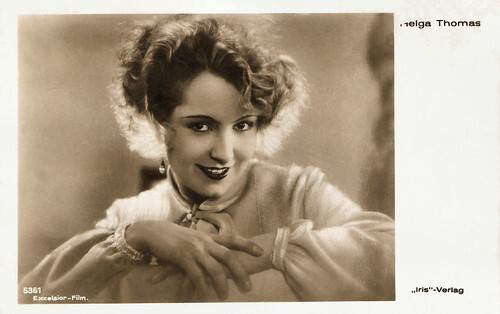
Austrian postcard by Iris Verlag, no. 5361. Photo: Excelsior-Film.
A slightly darker version of the Cinderella story
Helga Amalia Thomas was born in the Skog parish in Västernorrland County, Sweden, in 1891.
Thomas began her artistic career in Stockholm at the Intima Theatre. From 1916 to 1921 she was engaged at the Nya Theatre in Gothenburg. She was also a member of a travelling troupe for a time. Her film career was limited to the silent film years. Between 1923 and 1930 she appeared on screen in various German productions.
In 1923 Thomas debuted as the innocent young Abigail in Ludwig Berger's romantic comedy Ein Glas Wasser/One Glass of Water, which had an all-star cast including Mady Christians , Hans Brausewetter , Rudolf Rittner, Lucie Höflich, Bruno Decarli and others. After a supporting part in the Henrik Ibsen adaptation Nora (Berthold Viertel, 1923), with Olga Tschechowa in the title role, Thomas had the female lead opposite Wilhelm Dieterle in Der zweite Schuß/The Second Shot (Maurice Krol, 1923).
Helga Thomas was then reunited with Berger, who gave her the lead in Der verlorene Schuh/The Lost Shoe (Ludwig Berger, 1923), a slightly darker version of the Cinderella story, also with Paul Hartmann as the male lead and Frida Richard as the fairy godmother. At the time, the journal Lichtbild-Bühne wrote it was "a cinematic feat in which advanced technical skill can be admired in equal measure with esprit, charm and the most cultured aesthetics".
Afterwards, in her book 'The Haunted Screen', Lotte Eisner wrote on the film that German film directors had become more and more sensitive to the question of costume, "infusing life into surfaces". Eisner: "The costume film is free of naturalism that marked certain films in other genres. In Manon Lescaut and Der verlorene Schuh (Cinderella), Robison and Ludwig Berger portray the etiolated glow of velvets and the streaming crackle of silks."
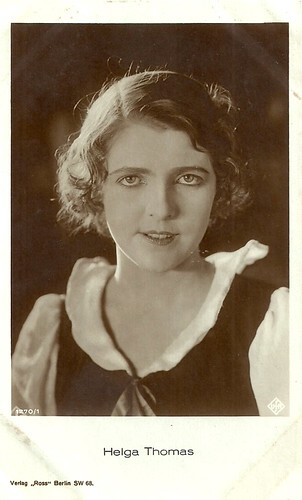
German postcard by Ross Verlag, no. 1270/1, 1927-1928. Photo: Ufa. Helga Thomas in Der Wilderer/The Poacher (Johannes Meyer, 1926).
Two women with children born out of wedlock
Helga Thomas continued with female leads opposite Gerd Briese in Rosenmontag (Rudolf Meinert, 1924), and opposite Carl de Vogt and Rudolf Rittner in Der Wilderer/The Poacher (Johannes Meyer, 1926).
She acted again opposite Rittner in Der Mann im Feuer/The Man in the Fire/When Duty Calls (Erich Waschneck, 1926), about an elderly fireman fired by a younger colleague ( Henry Stuart ) who is also in love with his daughter (Thomas). A rival suitor to the daughter ( Kurt Vespermann ) concocts more and more conflict between the old fireman and the daughter's lover, but when the rival creates a fire at the Scala theatre, it is the father who saves both his daughter and her lover from the flames. The fraud is unmasked and the father is rehired as a fireman.
While still playing female leads in Deutsche Frauen - Deutsche Treue/German Women - German Faithfulness (Wolfgang Neff, 1927) and Die glühende Gasse (Paul Sugar, 1927), she had to be satisfied with second-rank roles in other films that year opposite such actresses as Erna Morena and Maria Mindzenty. In 1928 she starred in Ledige Mütter/Unwed Mothers (Fred Sauer, 1928), about two women with children born out of wedlock ( Margarethe Schlegel and Thomas), causing scandal.
Thomas then acted in Mario Bonnard's society drama Die Sünderin/The Sinner (1928), with Elisabeth Pinajeff . She was the co-star of the Italian action hero Carlo Aldini in the Czech production Dva pekelné dny/Zwei höllische Tage (William Karfiol, 1928). She also played a supporting part in the Franco-German coproduction Quartier Latin/Latin Quarter (Augusto Genina, 1928) with Iván Petrovich , Carmen Boni , and Gina Manès . The following year, she acted in Morgenröte/Dawn or Red Morning (Wolfgang Neff, Burton George, 1929) starring Paul Henckels , Werner Fuetterer and Carl de Vogt .
Thomas had a last lead opposite André Mattoni in the comedy Hütet euch vor leichten Frauen/Beware of Loose WomenFilmportal.de. IMDb and German Wikipedia indicate she also acted in Richthofen (Peter Joseph, 1929) - not to be confused with Richthofen, der rote Ritter der Luft (Peter Heuser, Dezsõ Kertész, 1927) in which Thomas also acted - and Das heilige Schweigen (Hanns Beck-Gaden, 1930). The rise of sound cinema ended Thomas' career and she withdrew into private life. Helga Thomas was married twice and died in Stockholm in 1988, two days before her 97th birthday.
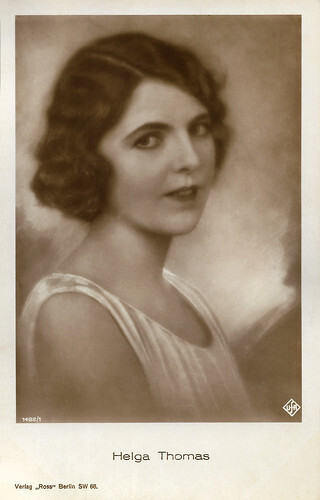
German postcard by Ross Verlag, no. 1182/1, 1927-1928. Photo: Ufa.
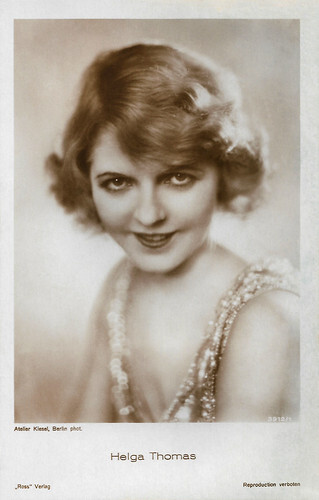
German postcard by Ross Verlag, no. 3912/1, 1928-1929. Photo: Atelier Kiesel, Berlin.
Sources: Lotte Eisner (The Haunted Screen), Filmportal, Wikipedia (German and English) and .

Austrian postcard by Iris Verlag, no. 5361. Photo: Excelsior-Film.
A slightly darker version of the Cinderella story
Helga Amalia Thomas was born in the Skog parish in Västernorrland County, Sweden, in 1891.
Thomas began her artistic career in Stockholm at the Intima Theatre. From 1916 to 1921 she was engaged at the Nya Theatre in Gothenburg. She was also a member of a travelling troupe for a time. Her film career was limited to the silent film years. Between 1923 and 1930 she appeared on screen in various German productions.
In 1923 Thomas debuted as the innocent young Abigail in Ludwig Berger's romantic comedy Ein Glas Wasser/One Glass of Water, which had an all-star cast including Mady Christians , Hans Brausewetter , Rudolf Rittner, Lucie Höflich, Bruno Decarli and others. After a supporting part in the Henrik Ibsen adaptation Nora (Berthold Viertel, 1923), with Olga Tschechowa in the title role, Thomas had the female lead opposite Wilhelm Dieterle in Der zweite Schuß/The Second Shot (Maurice Krol, 1923).
Helga Thomas was then reunited with Berger, who gave her the lead in Der verlorene Schuh/The Lost Shoe (Ludwig Berger, 1923), a slightly darker version of the Cinderella story, also with Paul Hartmann as the male lead and Frida Richard as the fairy godmother. At the time, the journal Lichtbild-Bühne wrote it was "a cinematic feat in which advanced technical skill can be admired in equal measure with esprit, charm and the most cultured aesthetics".
Afterwards, in her book 'The Haunted Screen', Lotte Eisner wrote on the film that German film directors had become more and more sensitive to the question of costume, "infusing life into surfaces". Eisner: "The costume film is free of naturalism that marked certain films in other genres. In Manon Lescaut and Der verlorene Schuh (Cinderella), Robison and Ludwig Berger portray the etiolated glow of velvets and the streaming crackle of silks."

German postcard by Ross Verlag, no. 1270/1, 1927-1928. Photo: Ufa. Helga Thomas in Der Wilderer/The Poacher (Johannes Meyer, 1926).
Two women with children born out of wedlock
Helga Thomas continued with female leads opposite Gerd Briese in Rosenmontag (Rudolf Meinert, 1924), and opposite Carl de Vogt and Rudolf Rittner in Der Wilderer/The Poacher (Johannes Meyer, 1926).
She acted again opposite Rittner in Der Mann im Feuer/The Man in the Fire/When Duty Calls (Erich Waschneck, 1926), about an elderly fireman fired by a younger colleague ( Henry Stuart ) who is also in love with his daughter (Thomas). A rival suitor to the daughter ( Kurt Vespermann ) concocts more and more conflict between the old fireman and the daughter's lover, but when the rival creates a fire at the Scala theatre, it is the father who saves both his daughter and her lover from the flames. The fraud is unmasked and the father is rehired as a fireman.
While still playing female leads in Deutsche Frauen - Deutsche Treue/German Women - German Faithfulness (Wolfgang Neff, 1927) and Die glühende Gasse (Paul Sugar, 1927), she had to be satisfied with second-rank roles in other films that year opposite such actresses as Erna Morena and Maria Mindzenty. In 1928 she starred in Ledige Mütter/Unwed Mothers (Fred Sauer, 1928), about two women with children born out of wedlock ( Margarethe Schlegel and Thomas), causing scandal.
Thomas then acted in Mario Bonnard's society drama Die Sünderin/The Sinner (1928), with Elisabeth Pinajeff . She was the co-star of the Italian action hero Carlo Aldini in the Czech production Dva pekelné dny/Zwei höllische Tage (William Karfiol, 1928). She also played a supporting part in the Franco-German coproduction Quartier Latin/Latin Quarter (Augusto Genina, 1928) with Iván Petrovich , Carmen Boni , and Gina Manès . The following year, she acted in Morgenröte/Dawn or Red Morning (Wolfgang Neff, Burton George, 1929) starring Paul Henckels , Werner Fuetterer and Carl de Vogt .
Thomas had a last lead opposite André Mattoni in the comedy Hütet euch vor leichten Frauen/Beware of Loose WomenFilmportal.de. IMDb and German Wikipedia indicate she also acted in Richthofen (Peter Joseph, 1929) - not to be confused with Richthofen, der rote Ritter der Luft (Peter Heuser, Dezsõ Kertész, 1927) in which Thomas also acted - and Das heilige Schweigen (Hanns Beck-Gaden, 1930). The rise of sound cinema ended Thomas' career and she withdrew into private life. Helga Thomas was married twice and died in Stockholm in 1988, two days before her 97th birthday.

German postcard by Ross Verlag, no. 1182/1, 1927-1928. Photo: Ufa.

German postcard by Ross Verlag, no. 3912/1, 1928-1929. Photo: Atelier Kiesel, Berlin.
Sources: Lotte Eisner (The Haunted Screen), Filmportal, Wikipedia (German and English) and .
Published on May 21, 2024 22:00
May 20, 2024
Whoopi Goldberg
American actress Whoopi Goldberg (1955) earned an Oscar nomination for her lead role in Steven Spielberg's The Color Purple (1985). She won an Oscar for her supporting role in Ghost (1990). Goldberg was also acclaimed for her work in Beyond Tara: The Extraordinary Life of Hattie McDaniel and the musical Sister Act (1992).
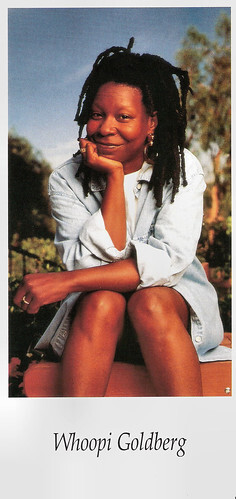
Belgian postcard by MultiChoice Kaleidoscope. Photo: Isopress / Outline (Trachtenberg).
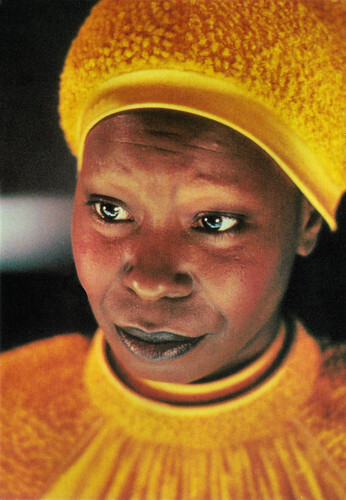
American postcard by Classico, San Francisco, Inc., no. 105-189. Photo: Paramount Pictures, 1992. Whoopi Goldberg in Star Trek - The Next Generation (1992-1993).
Whoopi Cushion
Whoopi Goldberg was born Caryn Elaine Johnson in 1955, in Manhattan, New York. Her mother, Emma (Harris), was a teacher and a nurse, and her father, Robert James Johnson, Jr., was a clergyman. She was inspired to become an actress by watching Nichelle Nichols' portrayal of Nyota Uhura in the original Star Trek (1966) series.
She dropped out of high school and became addicted to heroin. She ended up marrying her drug counsellor, Alvin Martin. She cleaned up and later divorced him. She worked as a funeral parlour make-up artist, a bank teller, and a bricklayer while taking small parts on Broadway.
In 1974, she moved to California and helped found the San Diego Repertory Company, where she used the name, Whoopi Cushion. She worked with improv groups, including Spontaneous Combustion, and developed her skills as a stand-up comedian. Goldberg had her breakthrough doing an HBO special and a one-woman show as Moms Mabley.
Her first film role was in Citizen (William Farley, 1982), but her career gained momentum as Celie Johnson in Steven Spielberg's drama The Color Purple (1985), based on Alice Walker's novel. For her role as Celie, she received critical acclaim, an Oscar nomination and became a major star. In 1985, she also won a Grammy Award for 'Whoopi Goldberg: Direct From Broadway'.
Her next films were, at best, marginal hits. She specialised in comedies like Jumpin' Jack Flash (Penny Marshall, 1986), Burglar (Hugh Wilson, 1987) and The Telephone (Rip Torn, 1988). Goldberg made her mark as a household name as Oda Mae Brown in the box office smash Ghost (Jerry Zucker, 1990) with Patrick Swayze and Demi Moore . She was the second African-American woman to receive an Academy Award. The first was Hattie McDaniel.
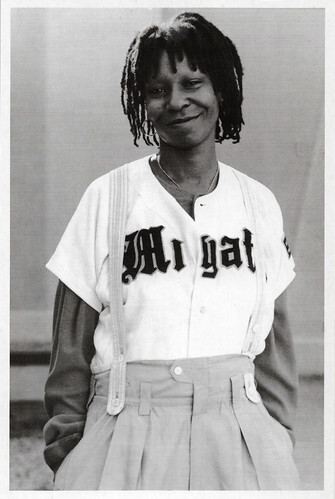
American postcard by The American Postcard Co, Inc., no. F59. Photo: 20th Century Fox Film Corp.
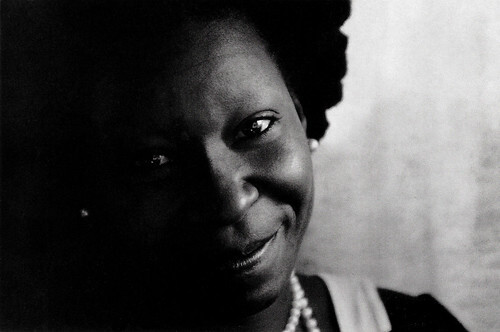
American postcard by the American Postcard Co., Inc. N.Y.C., no. 3249. Photo: Roddy McDowell. Caption: Whoopi Goldberg, New York City, 1990.
Fish-out-of-water with some flash
Whoopi Goldberg received another hit role in Sister Act (Emile Ardolino, 1992) as a nightclub singer forced to take refuge from the mob in a convent. She turns the convent choir into a soulful chorus with a Motown repertoire. Her fish-out-of-water with some flash seemed to resonate with audiences and it was a box office smash.
Goldberg starred in some highly publicised and moderately successful comedies of this time, including Soapdish (Michael Hoffman, 1991) with Sally Field , Made in America (Richard Benjamin, 1993) with Ted Danson and the sequel Sister Act 2: Back in the Habit (Bill Duke, 1993).
During her acting career, Goldberg played regularly in television series. This began with one-time guest roles in Moonlighting (1986) and A Different World (1991). She had a regular spot in Baghdad Cafe (1990- 1991). From 1990 through 1992 she was a voice actress on the animated series Captain Planet and the Planeteers.
Being a huge fan of the series, Goldberg asked creator and producer Gene Roddenberry for a role in Star Trek: The Next Generation (1988-1993). She was given the role of Guinan, the head of the Ten-Forward lounge. Goldberg also appeared regularly in Liberty's Kids: Est. 1776 (2002-2003).
As the late 1990s approached, Goldberg seemed to alternate between lead roles in straight comedies such as Eddie (Steve Rash, 1996) and The Associate (Donald Petrie, 1996) and supporting parts in more independent-minded films, such as How Stella Got Her Groove Back (Kevin Rodney Sullivan, 1998) with Angela Bassett and The Deep End of the Ocean (Ulu Grosbard, 1999) starring Michele Pfeiffer .
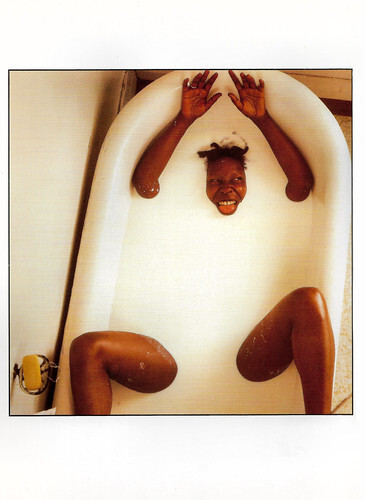
American postcard by Fotofolio, New York, N.Y., no. 2312. Photo: Annie Leibovitz. Caption: Whoopi Goldberg, Berkeley, California, 1984.
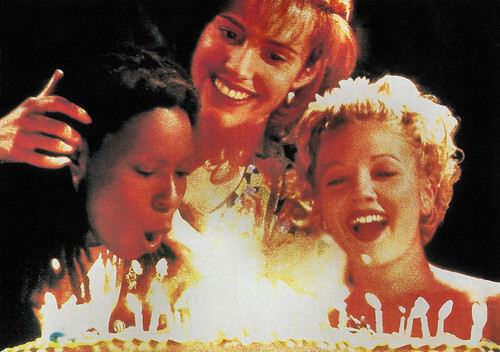
Dutch postcard by Boomerang Freecards, Amsterdam. Photo: Warner Bros. Whoopi Goldberg, Mary-Louise Parker and Drew Barrymore in Boys on the Side (Herbert Ross, 1995).
Ma Rainey's Black Bottom
Since 1999, Whoopi Goldberg worked regularly as a film producer and screenwriter. Goldberg was one of 15 writers who provided 130 episodes of the TV series Strong Medicine (2000-2006). Goldberg was the first woman to host the Academy Awards on her own. She hosted them in 1994, 1996, 1999, and 2002.
In 2002, she won a Tony Award as a producer for Best Musical, 'Thoroughly Modern Millie'. Goldberg herself returned to the stage in 2003, starring as blues singer Ma Rainey in the Broadway revival of August Wilson's historical drama 'Ma Rainey's Black Bottom' at the Royale Theatre. She was also one of the show's producers. Since 2007, Goldberg has been on the panel every weekday on the American discussion program The View. In 2009, Goldberg won the Daytime Emmy Award for Outstanding Talk Show Host for her work on The View. In 2010, she could also be seen at London's Palladium Theatre as the Mother Superior in the stage version of 'Sister Act'.
In the cinema, she starred in the Tyler Perry film For Colored Girls (2010), alongside Janet Jackson. The film received good reviews. The same year, she voiced Stretch in Pixar's Toy Story 3 (Lee Unkrich, 2010) which grossed $1.067 billion worldwide. Goldberg had a recurring role on the television series Glee (2012-2014) during its third and fourth seasons.
She starred in the film Nobody's Fool (Tyler Perry, 2018), and reprised her role as Guinan during the second season of Star Trek: Picard (2022). Goldberg portrayed Mother Abagail, a 108-year-old woman in the miniseries The Stand (2020-2021) with Alexander Skarsgard, based on the novel by Stephen King. She appeared in a cameo as a mid-wife in the remake The Colour Purple (Blitz Bazawule, 2023) and in preproduction is Sister Act 3 with Tyler Perry producing.
Whoopi Goldberg has been married three times. Her spouses were Alvin Martin (1973-1983), David Claessen (1986-1988) and Lyle Trachtenberg (1984-1985). She has one daughter, actress and producer Alex Martin, three grandchildren and one great-grandchild.
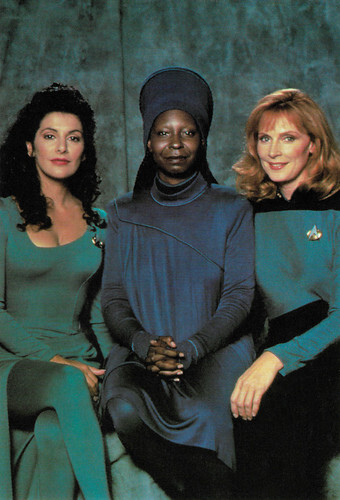
American postcard by Classico, San Francisco, Inc., no. 105-154. Photo: Paramount Pictures, 1991. Whoopi Goldberg, Marina Sirtis and Gates McFadden in Star Trek - The Next Generation (1988-1993).
Sources: Wikipedia (Dutch and English) and .

Belgian postcard by MultiChoice Kaleidoscope. Photo: Isopress / Outline (Trachtenberg).

American postcard by Classico, San Francisco, Inc., no. 105-189. Photo: Paramount Pictures, 1992. Whoopi Goldberg in Star Trek - The Next Generation (1992-1993).
Whoopi Cushion
Whoopi Goldberg was born Caryn Elaine Johnson in 1955, in Manhattan, New York. Her mother, Emma (Harris), was a teacher and a nurse, and her father, Robert James Johnson, Jr., was a clergyman. She was inspired to become an actress by watching Nichelle Nichols' portrayal of Nyota Uhura in the original Star Trek (1966) series.
She dropped out of high school and became addicted to heroin. She ended up marrying her drug counsellor, Alvin Martin. She cleaned up and later divorced him. She worked as a funeral parlour make-up artist, a bank teller, and a bricklayer while taking small parts on Broadway.
In 1974, she moved to California and helped found the San Diego Repertory Company, where she used the name, Whoopi Cushion. She worked with improv groups, including Spontaneous Combustion, and developed her skills as a stand-up comedian. Goldberg had her breakthrough doing an HBO special and a one-woman show as Moms Mabley.
Her first film role was in Citizen (William Farley, 1982), but her career gained momentum as Celie Johnson in Steven Spielberg's drama The Color Purple (1985), based on Alice Walker's novel. For her role as Celie, she received critical acclaim, an Oscar nomination and became a major star. In 1985, she also won a Grammy Award for 'Whoopi Goldberg: Direct From Broadway'.
Her next films were, at best, marginal hits. She specialised in comedies like Jumpin' Jack Flash (Penny Marshall, 1986), Burglar (Hugh Wilson, 1987) and The Telephone (Rip Torn, 1988). Goldberg made her mark as a household name as Oda Mae Brown in the box office smash Ghost (Jerry Zucker, 1990) with Patrick Swayze and Demi Moore . She was the second African-American woman to receive an Academy Award. The first was Hattie McDaniel.

American postcard by The American Postcard Co, Inc., no. F59. Photo: 20th Century Fox Film Corp.

American postcard by the American Postcard Co., Inc. N.Y.C., no. 3249. Photo: Roddy McDowell. Caption: Whoopi Goldberg, New York City, 1990.
Fish-out-of-water with some flash
Whoopi Goldberg received another hit role in Sister Act (Emile Ardolino, 1992) as a nightclub singer forced to take refuge from the mob in a convent. She turns the convent choir into a soulful chorus with a Motown repertoire. Her fish-out-of-water with some flash seemed to resonate with audiences and it was a box office smash.
Goldberg starred in some highly publicised and moderately successful comedies of this time, including Soapdish (Michael Hoffman, 1991) with Sally Field , Made in America (Richard Benjamin, 1993) with Ted Danson and the sequel Sister Act 2: Back in the Habit (Bill Duke, 1993).
During her acting career, Goldberg played regularly in television series. This began with one-time guest roles in Moonlighting (1986) and A Different World (1991). She had a regular spot in Baghdad Cafe (1990- 1991). From 1990 through 1992 she was a voice actress on the animated series Captain Planet and the Planeteers.
Being a huge fan of the series, Goldberg asked creator and producer Gene Roddenberry for a role in Star Trek: The Next Generation (1988-1993). She was given the role of Guinan, the head of the Ten-Forward lounge. Goldberg also appeared regularly in Liberty's Kids: Est. 1776 (2002-2003).
As the late 1990s approached, Goldberg seemed to alternate between lead roles in straight comedies such as Eddie (Steve Rash, 1996) and The Associate (Donald Petrie, 1996) and supporting parts in more independent-minded films, such as How Stella Got Her Groove Back (Kevin Rodney Sullivan, 1998) with Angela Bassett and The Deep End of the Ocean (Ulu Grosbard, 1999) starring Michele Pfeiffer .

American postcard by Fotofolio, New York, N.Y., no. 2312. Photo: Annie Leibovitz. Caption: Whoopi Goldberg, Berkeley, California, 1984.

Dutch postcard by Boomerang Freecards, Amsterdam. Photo: Warner Bros. Whoopi Goldberg, Mary-Louise Parker and Drew Barrymore in Boys on the Side (Herbert Ross, 1995).
Ma Rainey's Black Bottom
Since 1999, Whoopi Goldberg worked regularly as a film producer and screenwriter. Goldberg was one of 15 writers who provided 130 episodes of the TV series Strong Medicine (2000-2006). Goldberg was the first woman to host the Academy Awards on her own. She hosted them in 1994, 1996, 1999, and 2002.
In 2002, she won a Tony Award as a producer for Best Musical, 'Thoroughly Modern Millie'. Goldberg herself returned to the stage in 2003, starring as blues singer Ma Rainey in the Broadway revival of August Wilson's historical drama 'Ma Rainey's Black Bottom' at the Royale Theatre. She was also one of the show's producers. Since 2007, Goldberg has been on the panel every weekday on the American discussion program The View. In 2009, Goldberg won the Daytime Emmy Award for Outstanding Talk Show Host for her work on The View. In 2010, she could also be seen at London's Palladium Theatre as the Mother Superior in the stage version of 'Sister Act'.
In the cinema, she starred in the Tyler Perry film For Colored Girls (2010), alongside Janet Jackson. The film received good reviews. The same year, she voiced Stretch in Pixar's Toy Story 3 (Lee Unkrich, 2010) which grossed $1.067 billion worldwide. Goldberg had a recurring role on the television series Glee (2012-2014) during its third and fourth seasons.
She starred in the film Nobody's Fool (Tyler Perry, 2018), and reprised her role as Guinan during the second season of Star Trek: Picard (2022). Goldberg portrayed Mother Abagail, a 108-year-old woman in the miniseries The Stand (2020-2021) with Alexander Skarsgard, based on the novel by Stephen King. She appeared in a cameo as a mid-wife in the remake The Colour Purple (Blitz Bazawule, 2023) and in preproduction is Sister Act 3 with Tyler Perry producing.
Whoopi Goldberg has been married three times. Her spouses were Alvin Martin (1973-1983), David Claessen (1986-1988) and Lyle Trachtenberg (1984-1985). She has one daughter, actress and producer Alex Martin, three grandchildren and one great-grandchild.

American postcard by Classico, San Francisco, Inc., no. 105-154. Photo: Paramount Pictures, 1991. Whoopi Goldberg, Marina Sirtis and Gates McFadden in Star Trek - The Next Generation (1988-1993).
Sources: Wikipedia (Dutch and English) and .
Published on May 20, 2024 22:00
Paul van Yperen's Blog
- Paul van Yperen's profile
- 13 followers
Paul van Yperen isn't a Goodreads Author
(yet),
but they
do have a blog,
so here are some recent posts imported from
their feed.



